The Power and Purpose of Doodling

While doodling has been defined as “drawing or scribbling aimlessly,” I couldn’t disagree more. If you can believe it, doodling has the capacity to improve memory, focus, and cognition.

Many researchers suggest doodling is much more than a fruitless endeavor or a pointless waste of time.
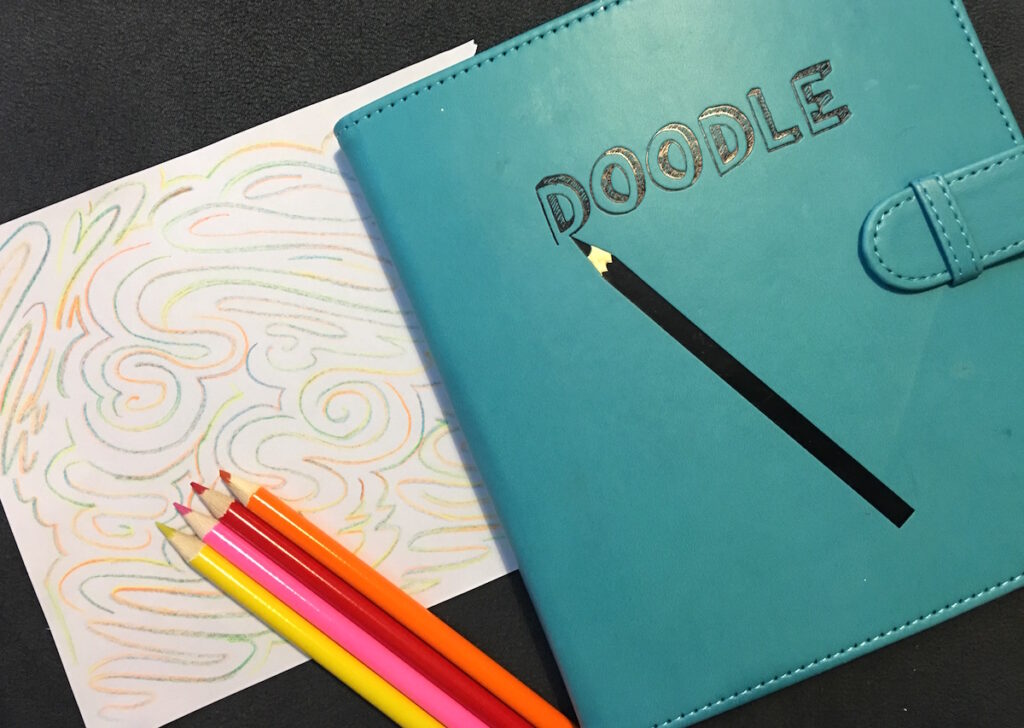
Doodling is “In”
Visit your local gift or bookshop and you’ll find a slew of journals and sketchpads promising to help stressed-out adults get in touch with their creative side. In the modern world, people are more overwhelmed than ever. Information and opportunities abound. However, this abundance can lead to stress and a lack of focus. Research suggests doodling can calm us, help us process information, and act as a tool for creative problem solving. Serious doodling actually creates a measurable change in your physical and neurological states.
In an article in The Atlantic , author Steven Heller explains, “Drawing with pencil, pen, or brush on paper isn’t just for artists. For anyone who actively exercises the brain, doodling and drawing are ideal for making ideas tangible.” Imagine the impact this could have on student learning!
Doodling Doesn’t Mean Disconnecting
While doodlers might appear inattentive to onlookers, this is rarely the case. Researchers tell us doodlers are most likely trying to make abstract concepts concrete with images, or they might be processing the information they are being given, filling in the gaps of their understanding.
What’s more, according to a study published in the Journal of Applied Cognitive Psychology , doodlers find it easier to recall dull information than non-doodlers, because the latter are more likely to daydream. Suddenly, doodling’s bad rap feels undeserved and more than a little unfair, no?
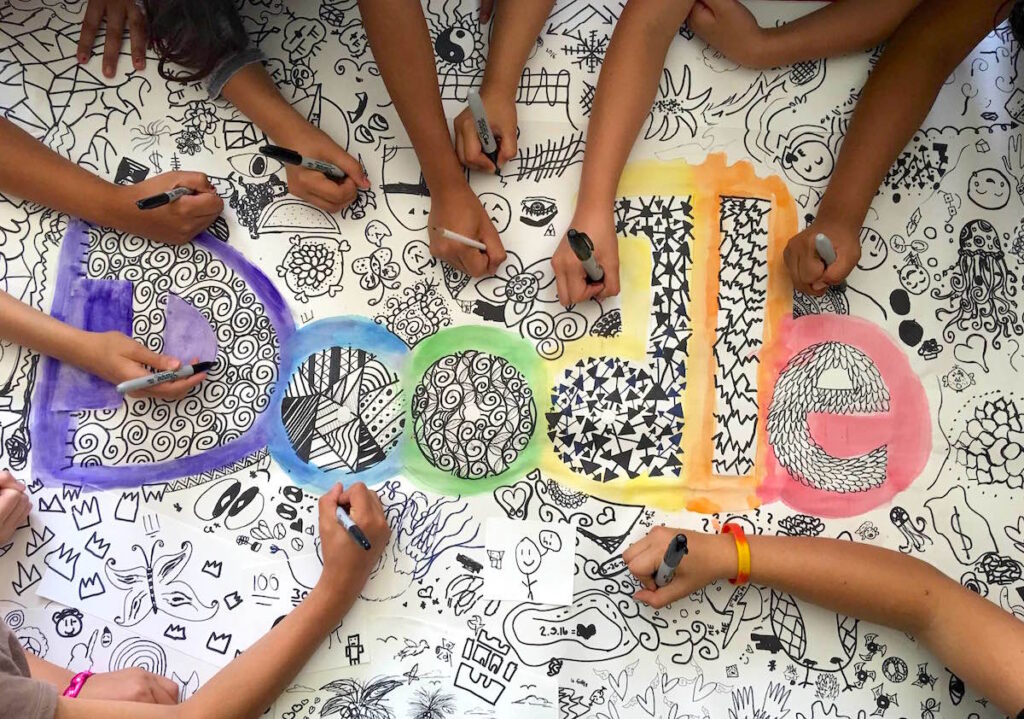
Doodling as an Academic Asset
The research doesn’t stop there! According to this article from the Huffington Post , Jackie Andrade, a psychology professor at Plymouth University who studied doodlers, found, “Doodling engages the brain’s ‘executive resources ’ — processes that help us plan, multi-task and concentrate. Engaging our executive resources with doodles while we’re listening to a lecture or phone call makes sure that those resources don’t wander off on their own to think about the grocery list or our plans for the weekend.” Encouraging students to doodle during note-taking might actually increase their retention.
The same article also mentions the work of Jesse Prinz, a philosophy professor at City University of New York Graduate Center who studies doodling in the context of research in art, found the practice is optimally suited for oral learning. He says doodling keeps people in a state of “pure listening.” That sounds like information teachers need to know and use.
The Power of the Doodle
For those of you who say doodling isn’t art, you are missing the point. It is a form of expression that, says Heller , “often triggers insights and discoveries that aren’t possible through words alone. Just think of all those napkins (or Post-Its) on which million-dollar ideas were sketched out.” As art teachers we should be teaching our students not just to make art, but how to think artistically and develop ideas and understandings in all kinds of capacities.
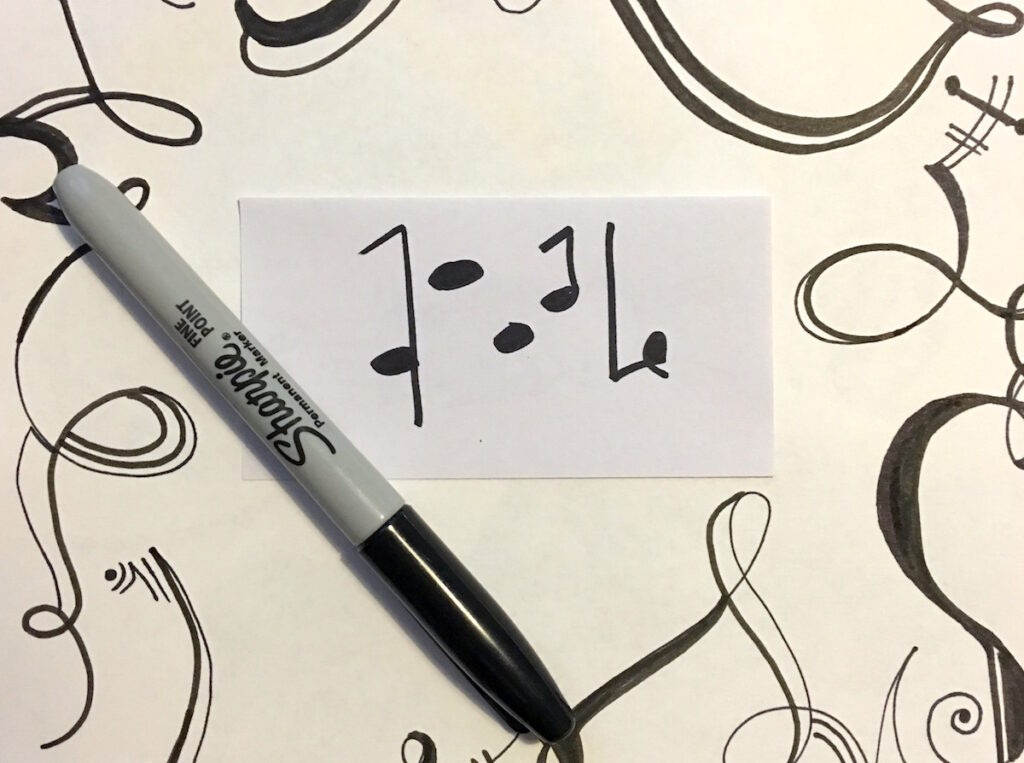
I’m reminded of a Picasso quote, “All children are artists. The problem is how to remain one once we grow up.” Doodling is one way all people – artistically inclined or not – can remain visual thinkers. We should never forget the power of losing yourself in a blank page. As Sue Shellenbarger of The Wall Street Journal says, “A blank page can serve as an extended playing field for the brain, allowing people to revise and improve on creative thoughts and ideas.”
Doodling is a powerful tool. One that can help our students process complex ideas. Maybe we should all be doing a bit more doodling.
Do you doodle? When? Where?
Can you think of any applications for your classroom to incorporate doodling?
Magazine articles and podcasts are opinions of professional education contributors and do not necessarily represent the position of the Art of Education University (AOEU) or its academic offerings. Contributors use terms in the way they are most often talked about in the scope of their educational experiences.

Lee Ten Hoeve
Lee Ten Hoeve, an elementary and middle school art educator, is a former AOEU Writer. She is passionate about making art a core subject and employing curiosity to engage learners.
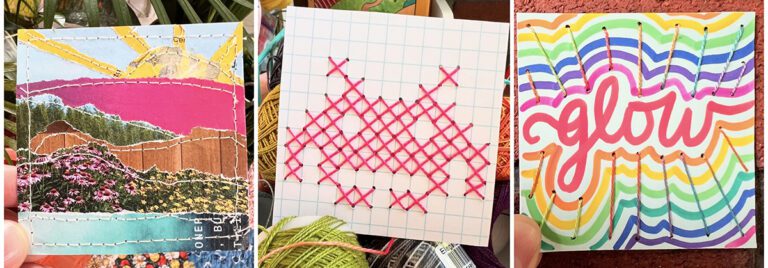
10 Ways to Empower Your Students in Big Ways with Mini Masterpieces
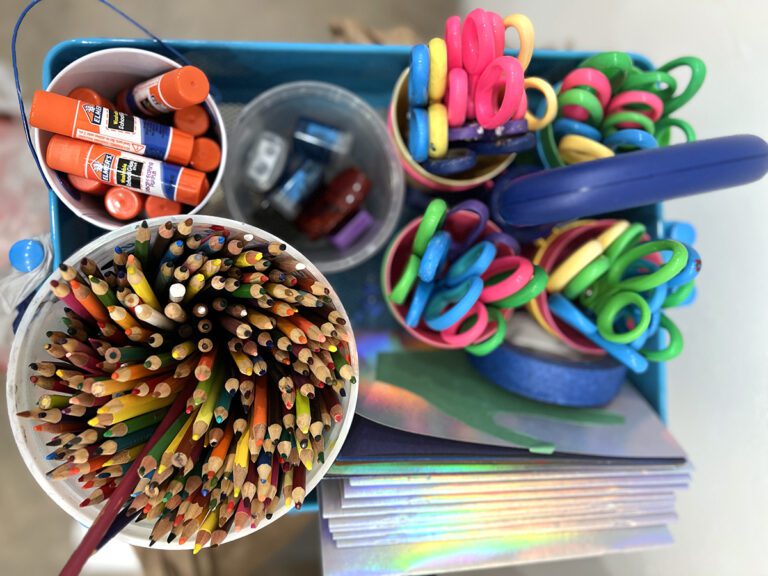
Make vs. Create: How to Encourage Creativity in the Art Room
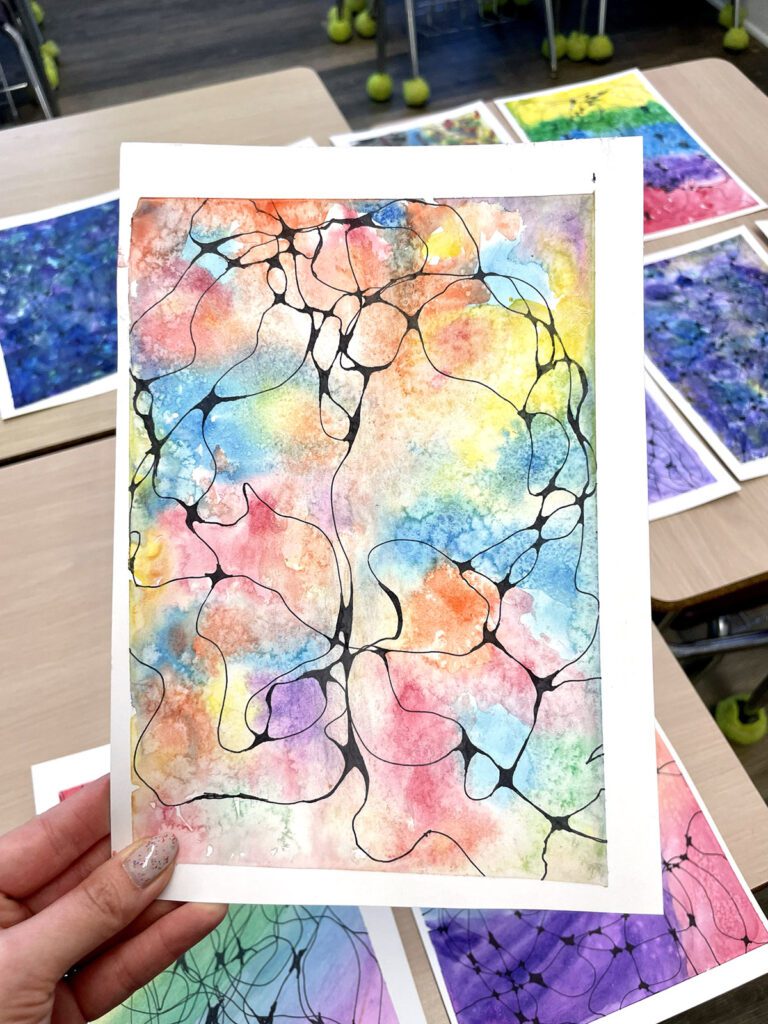
How to Use Neurographic Art to Encourage a Calm and Focused Mind
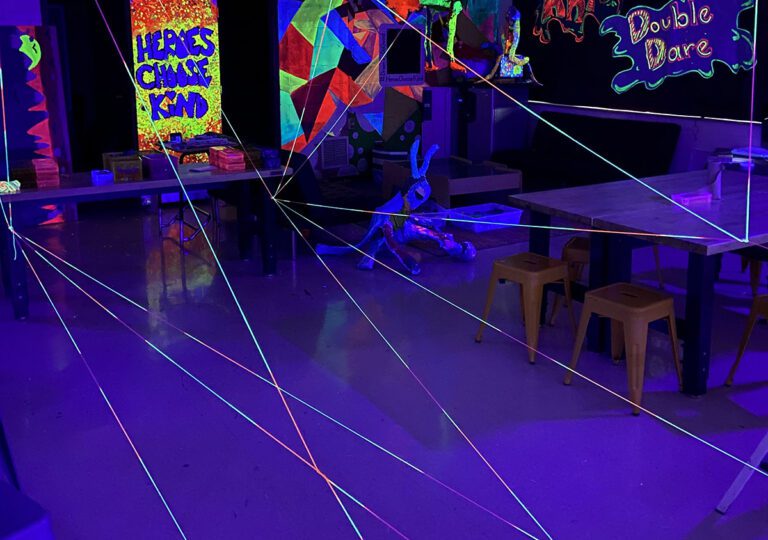
Level Up the Fun! 11 Awesome Art Games to End the Year
Doodle art: 20 brilliant examples
This doodle art proves it's a serious creative form.

Doodle art is underrated as an art form. It's a fun way of expressing yourself, but is also a brilliant way of experimenting and learning to draw. Doodles give a unique insight into your artistic style, conveying parts of your personality not shown through other mediums of art.
We've picked our favourite doodle artists out there, and listed examples of their work. Combining child-like doodles with expressive illustrations, they examples show how doodling can be used to create beautiful and arresting designs. Who knew there were so many doodle art styles?
If you'd like to work on your skill, try our selection of the best how to draw tutorials. Get drawing and you could add to your portfolio with a bunch of new work (for inspiration, see these examples of amazing design portfolios ).
01. Joe Whale AKA The Doodle Boy
Joe Whale (who is 10 years old) used to get into trouble for doodling at school, until asked to decorate a local restaurant in his cartoon-style doodles, when he gained attention and now has a serious following. He's been creating art since he was 3 and likes to "pretty much create doodles from anything as I get inspired by my surroundings and create characters from all of the things I see such as my Burger and Fries characters, Flowers, Vegetables,Cakes -Yum, clouds, etc...".
The video above shows him doodling on his bedroom wall. Just imagine what the future holds for this young artist.
02. Mr Doodle
Yellow Flowers Mr Doodle A photo posted by @mrdoodle on Feb 17, 2020 at 2:58pm PST
Sam Cox, also known as Mr Doodle , is a doodle artist who describes his mission in life as doodling everywhere, all the time. His work has been known to consume surfaces, walls and furniture in an almost viral form, growing relentlessly in clusters of characters, objects and patterns, and over the past few years he's been travelling the world to unleash his doodle creations, with his most recent doodling expedition taking him to Mexico.
03. Visoth Kakvei
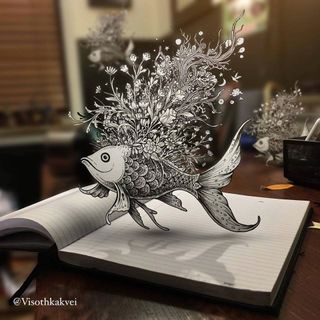
Visoth Kakvei is a Cambodian graphic designer who specialises in the most intricate hand-drawn doodle art with a real sense of depth. Where he really excels, though, is in taking his artwork and digitally enhancing it, either with bursts of colour or by transforming it into solid-looking pieces that seem to be bursting off the page. He never seems to stop creating; you can find hundreds of stunning examples over at his Instagram feed.
Get the Creative Bloq Newsletter
Daily design news, reviews, how-tos and more, as picked by the editors.
04. Hattie Stewart

London-based artist and illustrator Hattie Stewart is the undisputed queen of doodle art. She's famous for her unique graphic style, iconic cover takeovers and client work with – amongst others – Adidas and Apple . The awesome wraparound cover shown above was created for our sister magazine Computer Arts .
"The Character theme of the issue was perfect for me (obviously) so I wanted to bring all of my characters together on the cover for one big happy party," Stewart explains. "It’s a rare opportunity to be given free rein on such a brilliant canvas." The motifs were all hand-drawn, then scanned in, edited and composited in Photoshop , and the design also features Stewart's interactive installation I Don’t Have Time for This, part of the artist's solo exhibition at the NOW Gallery in London.
05. Jon Burgerman

Jon Burgerman is best known for his colourful, fluid and playful creations. This design, entitled 'I stare out of the window', was created for one of the New Art Gallery Walsall's large-scale windows. The brief was to depict the trials and tribulations of being an artist, including creating a concept, playing with ideas, taking a break and checking emails.
Find out more about Burgerman and his doodle art in our post How to use Instagram as a digital sketchbook .
06. Géraldine Georges
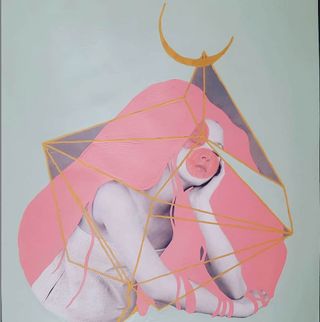
Géraldine Georges worked as a graphic designer for seven years before starting to freelance as an illustrator in 2006. The Belgian artist's collages are a perfect blend of photography and illustration, beautiful and elegant images that seep emotion.
07. Eva-Lotta Lamm
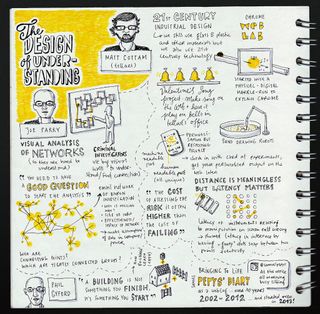
User experience designer Eva-Lott Lamm does web and interface design for Google as her day job, but enjoys graphic design and illustration as well and has made a name for herself with her series of sketchnotes: doodled notes from conference talks that add a fantastic visual element to boring old note-taking. She's even collected her sketchnotes into four books as well as a series of posters; find them all here.
08. Viktor Kalvachev
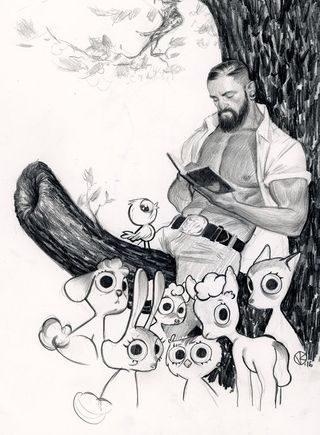
Born in Bulgaria, where he earned a master’s degree in fine arts, Viktor Kalvachev moved to the US to work in video games, and produced the graphic novel Pherone and crime series Blue Estate, the latter of which received two Eisner nominations. He now lives in Paris where he’s opened a studio and developed a video game.
09. Mattias Adolfsson
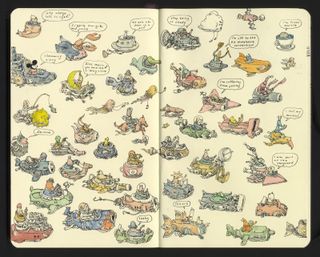
Working with everything from computer games to children's books, you will be hard pressed to find a better doodler than Swedish illustrator Mattias Adolfsson . Take a look through the pages of his sketchbooks to see what we mean.
10. Matt Lyon
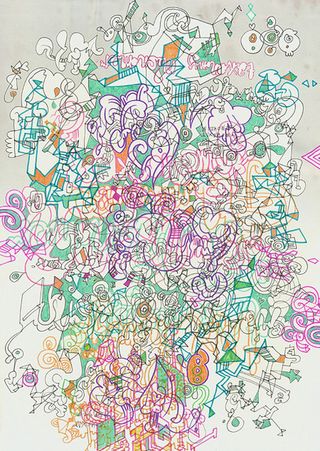
Matt Lyon is the London-based graphic artist and illustrator behind this colourful and chaotic doodle. He comments on his website: "My work stems from incessant doodling, often laced with wild colours, shapes and patterns." Indeed it does. And we love it!
11. Fred Blunt

Inspired by The Muppets, Quentin Blake and the Flintstones, Fred Blunt has been a compulsive doodler since he was in hand-me-downs. His cute characters are an instant source of cute and child-like inspiration that'll have you harking back to your childhood.
12. Pat Perry
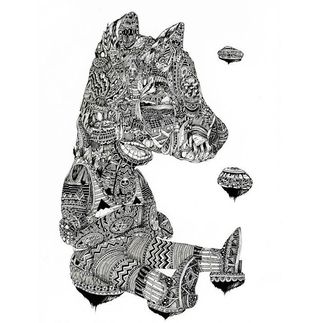
Pat Perry is a superbly talented artist who, as his mind wanders, inscribes in ink some truly surreal and attention grabbing imagery. A daily practice for the Michigan born artist, drawing helps Pat to work through the complexities of life and thankfully for us acts as a remedy for all we find mundane in day-to-day living.
13. Lizzie Mary Cullen
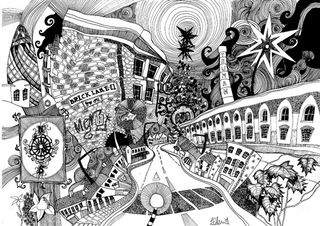
Lizzie Mary Cullen is a multi award-winning artist based in London. A natural talent with pen and ink, Cullen's doodle art has attracted the attention of many leading brands, including the BBC, MTV and Harvey Nichols. This intricate depiction of Brick Lane, is just one from Cullen's brilliant series titled London psychogeographies.
14. Kerby Rosanes

Kerby Rosanes is a graphic designer and SEO specialist with a passion for art and doodling. His work, which he post regularly on his Sketchy Stories blog , exists at various scales and his striking attention to detail makes each piece unique and original.
15. Lisa Krasse
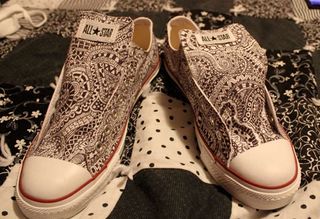
Craft, drawing, and fashion combine in one amazing project. Lisa Krasse has combined her love of doodling with a love of Converse shoes to create these amazing sneaker designs . Check out the rest on her Behance profile .
16. Jim Bradshaw
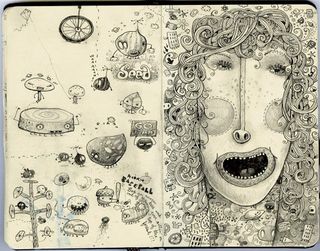
New Jersey illustrator Jim Bradshaw has been doodling away since he could pick up a pencil. Jim tackles all things creative and is never far from his Moleskine – especially now that he is doing illustration full-time, after leaving the his corporate job as an art directer. His doodles open up a weird and wacky world that often includes creatures from outer space and walking tree stumps. We love it!
17. Chris Piascik
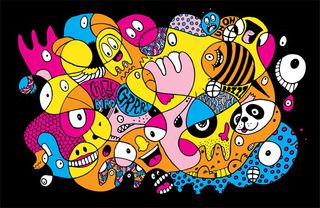
Describing himself as an 'illustrator, formerly known as designer', Chris Piascik fast became a well-known face in the doodle art world. Based in New England and with more than eight years of professional experience, Chris embarked upon a 'daily drawing' challenge back in 2007. Once he'd done 1000, he published them in a book entitled '1000 days of drawing'. He continues to doodle to this very day.
18. Sagaki Keita
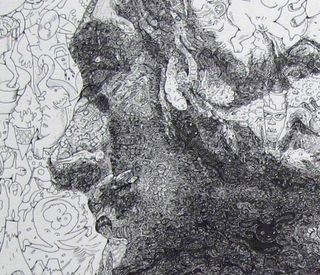
Japanese artist Sagaki Keita specialises in recreating classic masterpieces by covering them in these gorgeous child-like doodles. Even though the doodles themselves are simple, once you look further away from the drawing, you realise that Sagaki has taken the time to ensure they blend together perfectly.
19. Johanna Basford
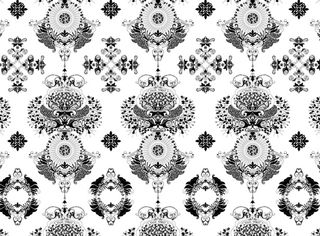
The unique doodling style from artist Johanna Basford managed to bag her this commission from international coffee company Starbucks. After persistently sending the company paper cups with her artwork on, Johanna was asked to design a wallpaper for the redesign of Starbuck's Vigo Street store in London. Hidden within the flourishes are tiny coffee cups, elusive birds, and the odd Frappuccino...
20. Chris Glasz
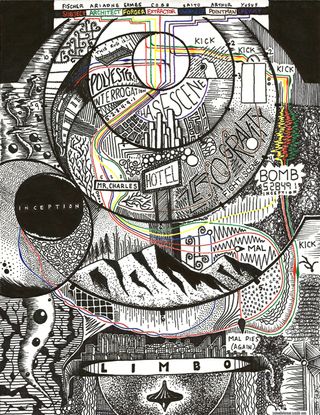
Owner of Tumblr blog In Doodle Format, Chris Glasz has chosen a number of popular films and illustrated them as creative doodles. Often using just a simple black Sharpie, so far, the talented artist has celebrated 11 well-loved films, including Back to the Future, Lord of the Rings, Harry Potter, and Inception (above).
We're a little in love with these illustrations, which are far more original than most of the fan art we see. It's also hard not to be a little in awe of this guy's talent with a Sharpie.
Related articles:
- 22 beautiful examples of paper art
- Art techniques: top tutorials for painting and drawing
- The best pencils: the best mechanical, colouring and drawing
Thank you for reading 5 articles this month* Join now for unlimited access
Enjoy your first month for just £1 / $1 / €1
*Read 5 free articles per month without a subscription
Join now for unlimited access
Try first month for just £1 / $1 / €1
Kerrie Hughes is a frequent contributor to Creative Bloq, and was once its editor. One of the original CB crew, Kerrie joined the team back in 2013 after moving from her role as staff writer on 3D World. Since then she's written regularly for other creative publications such as ImagineFX, Computer Arts and Digital Camera World. After a stint working for the police, Kerrie is back reviewing creative tech for creative professionals.
Related articles

- 2 Donald Trump’s NFT trading cards are back and cringier than ever
- 3 The new Barbie Flip Phone looks like a total dream
- 4 The Atari 7800+ is a remake of the only retro console I never owned, so of course I want it
- 5 Viral videos debunk bogus claims of 'no CGI' in these movies

What Is Doodling? – Enhance Your Creativity Through Doodling
You may have, on some occasions, found yourself in a tedious lecture or a boring conference, and your mind has wandered off. You might then find yourself scribbling randomly on a piece of paper, and this is what many of us think of as doodling. However, did you know that doodling can increase your concentration, ability to learn, creativity, and improves your drawing skills? In this article, we will be helping you to better understand doodling, and how it can benefit your health and wellbeing!
Table of Contents
- 1 What Is Doodling?
- 2 The Evolution of Doodling
- 3.1 Doodling Helps to Relieve Stress
- 3.2 Doodling Improves Your Memory
- 3.3 Doodling Improves Creativity
- 3.4 Doodling Helps to Process Your Emotions
- 3.5 Doodling Can Boost Your Mood
- 3.6 Doodling Helps You to Learn More Effectively
- 3.7 Doodling Helps to Improve Your Thinking
- 3.8 Doodling Can Make You a Better Listener
- 4.1 Zen Doodling
- 4.2 Zen Tangle
- 4.3 Mandalas
- 5 Doodling and Education
- 6 Doodling in the Workplace
- 7 How to Doodle
- 8.1 Is Doodling the Same As Drawing?
- 8.2 What Are the Main Benefits of Doodling?
- 8.3 What Is the Psychology Behind Doodling?
What Is Doodling?
Doodle art is an act of sketching, drawing, or scribbling on a piece of paper, without the idea of what the finished image will be. When it comes to this type of drawing, the act of doodling or drawing is of more value than the result. Even if your finished doodling art looks great, the act of doodling is more about your concentration and relaxation at the moment.
This means that doodling should be fun and must be done without any pressure or feeling that you need to create something perfect as a piece of art.
Doodling is also unique to each doodler, and there are no rules or fixed guidelines for you to follow. Some may enjoy drawing lines or shapes, for others it may be letters or numbers. Others may want to draw faces or animals; it is completely up to you what to doodle.
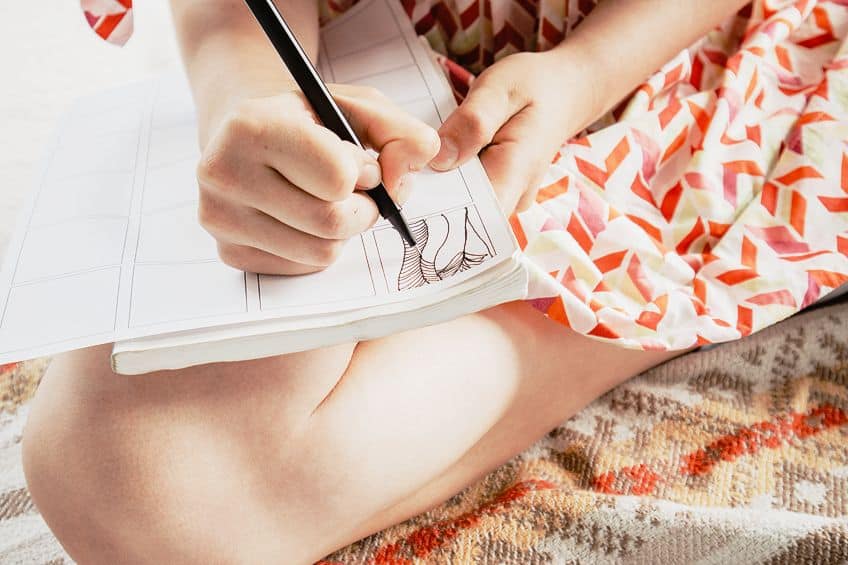
The act of doodling may be considered a type of art in progress, it may not be professional art, but you do not have to make any elaborate art piece. Even if you are only making lines or marks on a piece of paper, you are creating something and expressing yourself, and this can be considered art.
The Evolution of Doodling
The word “doodle” was first used in the early 17th century and means “a simpleton” or “a fool”. It was in the 18th century that “doodle” was used as a verb, which meant to make a fool of or to swindle. This led to the more general use of the verb doodle in modern times, which means to do nothing. Doodling is an art that is practiced by everyone including American presidents, such as Theodore Roosevelt, who doodled children and animals. Ronald Regan also doodled football players and cowboys, and John F. Kennedy doodled sailboats.
Even Hilary Clinton was caught doodling, which led people to believe she was not paying attention. However, this does not mean she was not listening to the proceedings, as doodling has been proven to help with listening and improving creativity.

Many of the world’s most influential historians were doodlers, and you will be very surprised to see how many goofy stick figures have appeared in the margins of some famous historical manuscripts. It has even been found in the mathematical field, where Stanislaw Ulam developed a visual aid for mathematics based on doodling, which he created when attending a conference.
Benefits of Doodling
Usually, when people doodle, it is out of frustration, boredom, or even to release stress. Doodling is almost like a safety valve that will enable you to release some pressure but in a non-threatening and safe way. However, there is a lot more going on as doodling opens the subconscious mind, allowing you to access ideas and concepts that you would not have considered. Doodling gives certain processes in your brain a short break while releasing other more productive processes.
Doodling has a definite physiological effect, which we will now take a closer look at.
Doodling Helps to Relieve Stress
When you feel wound up or tense, it is a good time to put pen to paper and start doodling to relieve any psychological distress. Doodling can help you to relax and unwind, as it can calm the amygdala , which is the part of your brain that controls the “fight or flight” responses that are linked to anxiety and stress. Doodling activates the brain’s ability to find certain past experiences and forward them into the present, which can help to produce a better life picture, helping you to relax.
Repeating the same shape or line brings about a state of calmness, as you are simply drawing the same thing without the fear of making any mistakes.

Doodling Improves Your Memory
In 2009, Jackie Andrade, a psychologist from the University of Plymouth in the UK, assembled 40 people and asked them to listen to a boring two-minute and 30-second telephone message. Later, they were asked to try and recall any information they could remember from the message. They were not told that they would be tested after the message. She divided the people into two groups and only told one group to shade in some square shapes on a piece of paper in front of them. They were also instructed not to be too concerned about neatness and keeping within the lines of the square shape.
Both groups were then asked to recall any information they could remember about the message. The group that did the doodling was able to recall about 30 percent more information than the group that just listened.
What was it that made the doodlers better at recalling information than the non-doodlers? By doodling, the people were held at just the correct level of arousal, which kept them from falling into a state of daydreaming. While the non-doodlers had no reason to keep them from drifting into a state of daydreaming.

Drawing without any pressure is what keep their brains more focused. In other words, paying continuous attention without doodling becomes a strain, while doodling keeps your attention without losing complete or total interest. A study was done on university students, particularly medical students, who are required to absorb a large amount of information.
They found that students who doodle for a few minutes at a time remember more information that they need to recall at a later stage.
Doodling Improves Creativity
Doodling does a great deal more than just keep you from falling asleep. The art of doodling aids in creativity, which can help you come up with more ideas that you can use for the problems that you are facing. Many famous poets and writers were doodlers, like J.K Rowling and Alexander Pushkin.
They drew the faces of their characters in the margins of their documents, which served as inspiration.
Sunni Brown, an American author, proved that doodling could stimulate certain parts of the brain and assist in processing information, allowing you to develop new ideas. She has been named one of the top ten highly creative people on Twitter.

Doodling can help in refining and generating ideas that have been in your mind for some time, which is the main reason why authors are doodlers. The faces that Alexander Pushkin doodled on the edges of his manuscripts helped them come to life in his imagination.
So, it is safe to say that many of the world’s greatest ideas are the result of doodling.
Doodling Helps to Process Your Emotions
When you feel anxious, depressed, or frustrated, you may find it difficult to express your feelings in words. When someone asks you what is wrong, you may have an image popping up in your mind that can describe those emotions, but no way of expressing it. The University of California in San Diego established a digital sketch platform named UbiSketch .
They tested it over four weeks and discovered that the users of the platform sketched images that they had in their minds, expressing their feelings.
One person sketched a frazzled brain because he felt exhausted from his job and a newborn baby. Another person sketched an exam paper looming over her head, as the deadline of her final exams was rapidly approaching.
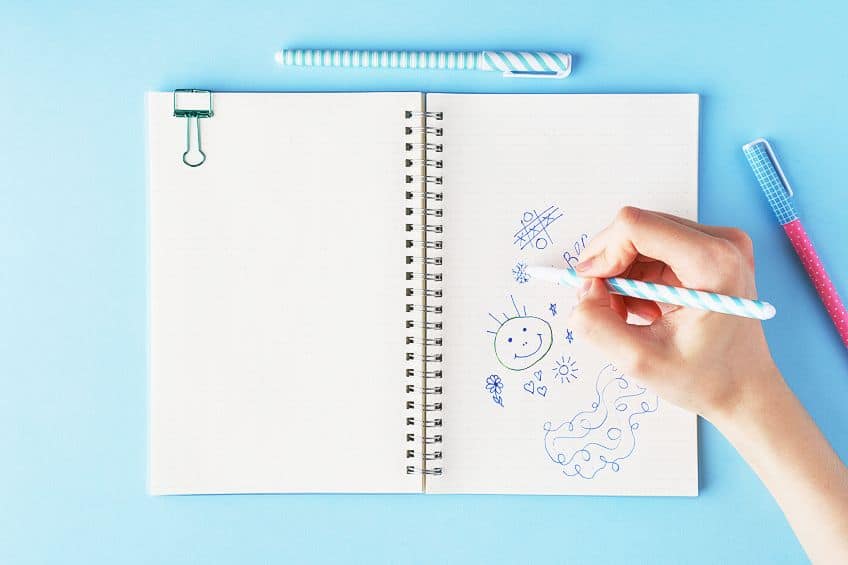
So, if you are found in a situation where you are wound up and frustrated, why not doodle that image and sketch out your feelings? Even if it is rough and not a good drawing, remember that a picture can speak a thousand words.
Doodling Can Boost Your Mood
Doodling does not only make you more creative, but it can also make you feel happier. In our preceding section on expressing your emotions by doodling, it did not matter what you sketched. However, what you draw here matters. In 2008, a study was conducted where participants were asked to sketch something that made them feel unhappy or happy. Those who chose to sketch the positive happy side experienced an elevation in their mood.
So, next time your spirits feel low, try sketching something that makes you feel happy.
Doodling Helps You to Learn More Effectively
You may think doodling during your study time is counterproductive, but studies have proven that students who doodle during assignments and lectures retain more information. This enables you to understand complex ideas as well as increase your enjoyment of study and learning. Doodling also reduces any distractions and will promote innovative thinking. These are some of the benefits you can enjoy in university, school, at work, or just life in general.
Doodling Helps to Improve Your Thinking
There is a well-known expression, “You can miss the forest for the trees”. Doodling is something that can help you take in the whole forest. When you have a problem to solve or a task to complete, you often suffer from tunnel vision, and you can only see what is directly in front of you. Doodling will help you to step backward and allows you to connect to other concepts. You can doodle ideas, even if they are in your subconscious or old memories. In other words, you are looking at the bigger picture, which can lead you to more innovative solutions to your problem.
Doodling can help you to concentrate and focus on your conscious mind, but even when daydreaming, connections can be made in your subconscious mind as well.
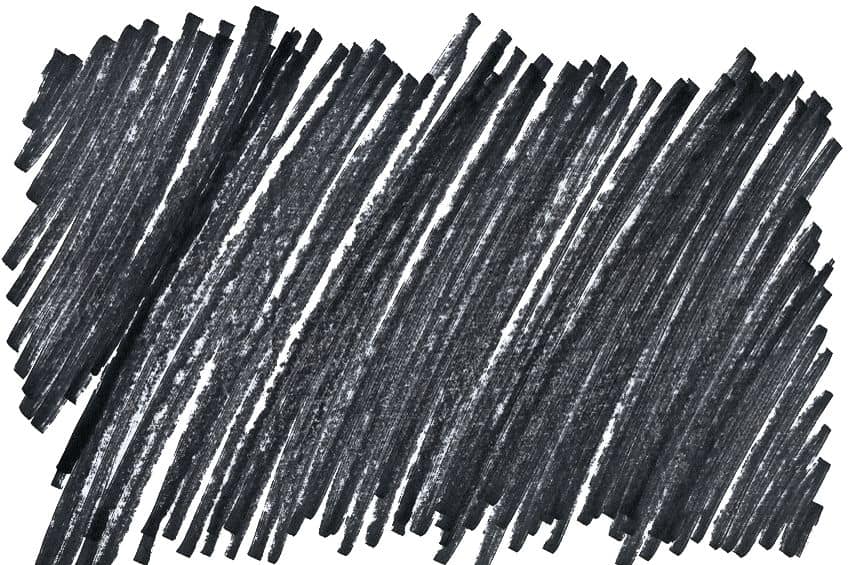
One student studying architecture was struggling to come up with an idea for a project, he was bored and doodled his signature repeatedly. Suddenly, he noticed a pattern forming between the letters. An idea sprang to mind, and he doodled a sketch, which became the cornerstone of his design that was highly successful.
Doodling Can Make You a Better Listener
We have all experienced our mind wandering when listening to someone talking to us, and our thoughts are more on personal issues. When this happens again, try to doodle. Jesse Prinz, who is a philosophy professor at the City University of New York Graduate Center, says doodling keeps your mind in a state of listening that is almost the same as meditation. Your mind is in a state where it cannot wander, and if you do not doodle, you find yourself having difficulty concentrating.
This attitude makes you a better listener, where you can concentrate and comprehend what the other person is talking about.
The Art of Doodling
Doodling has been described as mindless art, but this is far from the truth, so instead of calling it doodling, let us rather refer to it as doodle art. Many people love doodle art because they enjoy sketching, as it is relaxing and fun to do. Doodle art can be simple or more complex and intricate. Let us now consider different styles and techniques of doodle art that you can use and enjoy.
Zen Doodling
Zen doodling, also known as freestyle doodling, is sketching, or drawing lines, figures, or letters. You can even color in some of the loops or squiggles in different colors. You can create it anywhere and with any type of drawing supplies you may have at hand. The doodle can look like anything, it does not matter, the idea is for you to enjoy and relax. Here are some zen-doodling ideas for you to try.
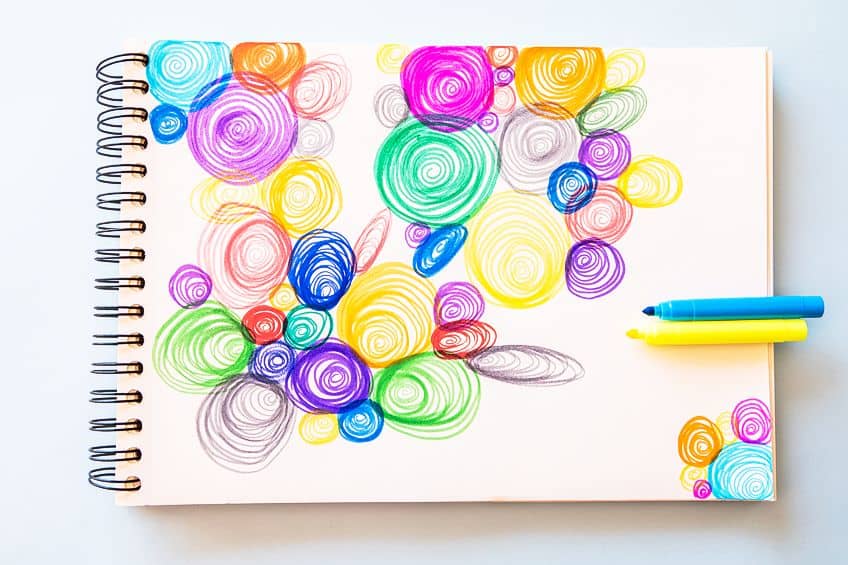
- Draw some boxes and color them in .
- Fill your page with different loops and lines .
- Draw a large triangle and then keep on adding smaller triangles inside and around it.
- Doodle your name and those of your family using different styles, like block letters , robot style, loopy letters, and even messy letters.
- In the center of your page draw a flower , then add smaller flowers all around it till you fill your page.
- Draw different sizes and shapes of leaves .
Zen Tangle
Zen tangle is a form of doodling that is made up of various doodling patterns that can be found in many books and online. These patterns all come together to create a whole art piece. It is easy to do, fun, and relaxing, and anyone can create amazing images of structured doodling patterns that are repetitive. However, zen tangling is different from zen doodling, as more thought is put into it. You are paying a lot more attention to making your doodles more cohesive, and it is not just a random squiggling of lines and letters but involves simple patterns that come together to create the final image.
Zen tangles are usually created using a small piece of square paper or board about three and a half inches, or board, which are then filled in with repetitive patterns.
Most zen tangles have specific names and ways in which each pattern is formed or drawn. There are many patterns you can learn, with names like dribbetz, cyme, ennies, fangle, among many others. The art of creating a zen tangle is known as tangling. It is a meditative art form, where the artist’s focus is on creating single lines and not a complete image. Zen tangles are usually created in black and white and should be a mindless drawing activity that looks like absolutely nothing but is created with intent and purpose. So, if your zen tangle looks like something with a specific shape or form, then it is not a zen tangle.
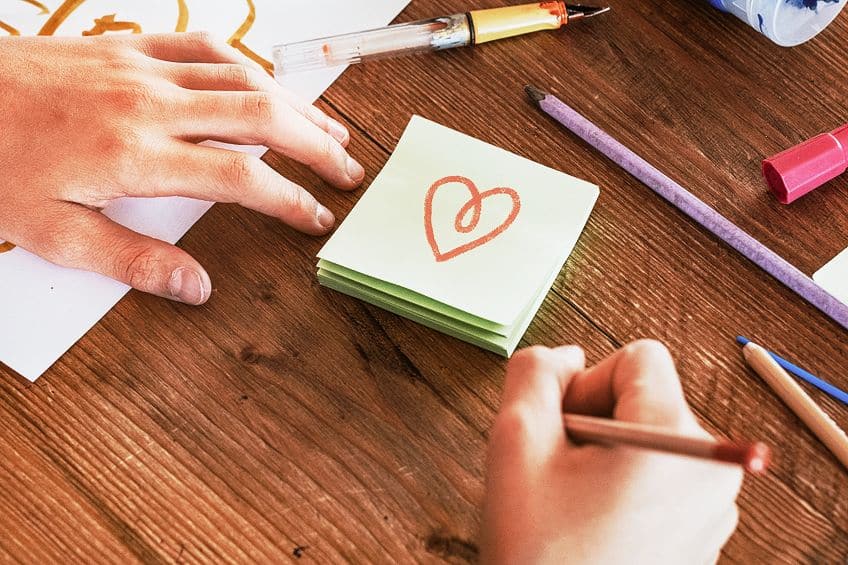
When you create a zen tangle, you need to see that it does not look like something. In other words, it has no top or bottom, no upside or downside, they are rather tangle patterns that may have some shading, but they are carefully and intentionally created. Below, you will find a few zen tangle ideas.
- Start off with a simple square shape and then begin adding zentangle patterns.
- You can also take other simple shapes , like a heart-shape, and fill with zentangle patterns.
- Use the zentangles to create beautiful butterfly wings.
- Create simple animal outlines and fill will zentangle patterns.
- How about a stylish zentangle hat ?
Mandalas
The word “Mandala” is a Sanskrit word meaning “circle” and is a very old custom that has been practiced by different religions and cultures over the centuries. For example, Hindus, Buddhists, Christians, Native Americans, and many more. It was used as a spiritual or meditation tool that represented a connection to the universe but is now used as a tool to promote relaxation and mindfulness. Mandalas consist of circles or circles within squares and can be of any shape. They must have an integrated structure that is organized around the center. The mandalas consist of repetitive geometric patterns that begin in the center and then move outward.
The mandalas can have color , or they can be black and white, and they can be simple, or immensely intricate.
Mandalas are created with a purpose, like creating a connection, wholeness, or intentions, and the creator needs to remain focused on that purpose all the time they are drawing. If you feel like adding shapes, words, or patterns just let your mind flow, and the mandala is complete when you feel it is finished or when the focus has been lost. There is even a specific color chart for the colors of your mandala. So, here is a list of the colors and their symbolic meaning, which will allow you to pick the color that you feel goes with your mandala.
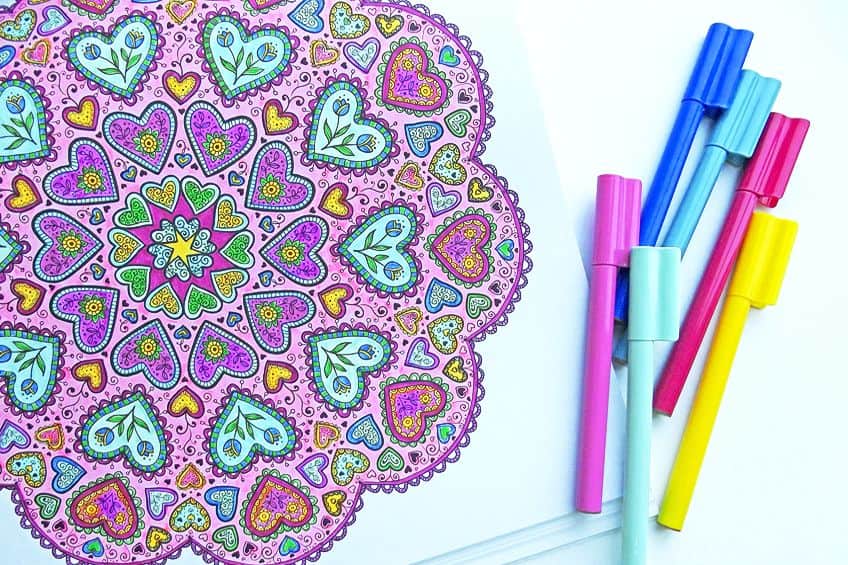
- Pink : represents intuition, love, and femininity.
- Red : represents high energy, strength, and passion.
- Yellow : represents wisdom, laughter, learning, and happiness.
- Orange : represents transformation, creativity, intuition, and self-awareness.
- Blue : represents inner peace, emotional healing, and meditation.
- Green : represents psychic ability, physical healing, caring, and love of nature.
- White : represents spiritual focus.
- Purple: represents all spiritual things.
- Black: represents deep thinking, mystery, and individuality.
Doodling and Education
Traditionally the art of doodling has been regarded as a distraction from learning, but psychological research has shown that doodling in the classroom can be of great benefit to the student in learning, attention, memory, stress relief, and increased focus. For many students, the conventional way of learning does not work, and doodling can be a way of improving the student’s ability to concentrate. In some schools, the teachers are beginning to include doodling as part of the curriculum.
Doodling in schools and places of learning should not be discouraged but rather used as a potential avenue where educators can find the best methods that will help the students to learn and retain information.
Doodling in the Workplace
When you next find yourself at work with a problem, and you cannot find the answer, why not take out a piece of paper and a pen or pencil and start doodling? By just drawing random shapes, lines, or figures, you will be able to improve your memory, boost your creativity, increase your productivity, or just help yourself relax. Researchers have proven that doodling has some amazing benefits for everybody, including at your workplace. Doodling will help to improve your memory to recall information that was spoken in meetings.
It will boost your creativity and will give you the ability to think outside the box, making you more efficient in your job. Doodling will also help you to relax and reduce any stress you may be going through.

Doodling makes an excellent brainstorming technique, each member gets a piece of paper and a pencil, then each one doodles an image that comes to mind. Then the papers are passed around to the person next to them, and they add to that first sketch. The papers are then collected, and each sketch is discussed to see how many innovative ideas come to mind.
How to Doodle
Doodling is a great way to pass the time when you are bored, which can strike anytime or place. So, you need to always be prepared by carrying a notebook and pencil with you so you can create doodles. Here are some simple steps to follow when learning how to doodle. First, here are some basic doodling supplies that you will need.
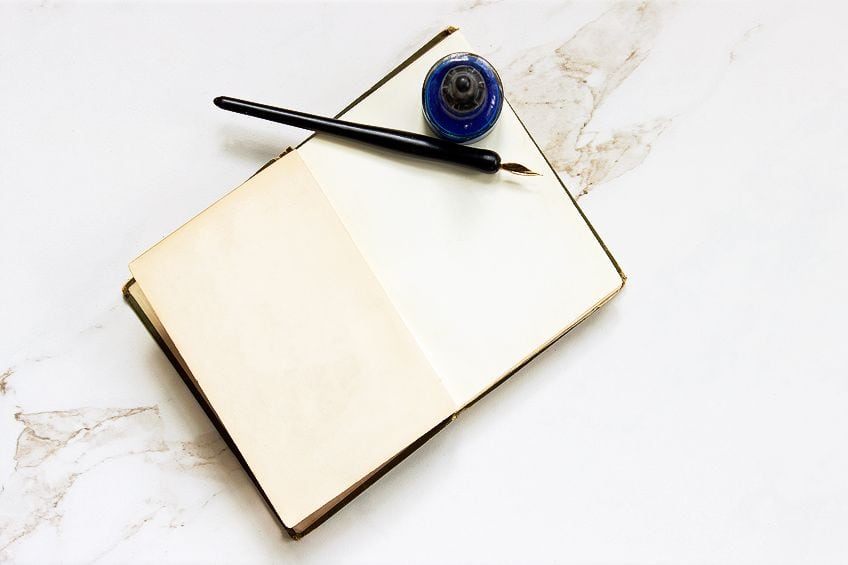
- Pencil or pen
- Highlighter
Whenever you want to doodle, just pick up your pen or pencil and start to doodle. You can sketch an event, an act, a feeling, a place, a person, your name, or anything that comes to mind, even if it is only a few lines and squiggles. As soon as you start, you will find that inspiration will come. Doodle ideas can include flowers, faces, words, or numbers using different types of figures and letters, or animals like your pet cat or dog or some scary monsters. Just look around you for doodle ideas, such as a tree, or people walking, or doodle what you can hear, like a song or what your teacher or lecturer is talking about.
Remember, doodling does not have to be perfect, and it does not have to resemble something or somebody.
Doodling is simply an expression of your feelings and what you are thinking. So, have some fun as there are no rules to follow and there are no deadlines to meet. Doodling is not just some random scribbling. Doctor Robert Burns, who was the director of the Institute of Human Development, made use of doodles to diagnose some of his patient’s emotional problems. He shares how doodling shows what is happening in our subconscious minds, and just as an EEG transmits brain activity onto a piece of paper, so your hand works in a similar way.

So, when you find yourself struggling and unable to concentrate, then doodling may be just the thing that you need. It will give your brain the ability to focus and allows you to be more creative, helping you to solve problems that you might be experiencing.
The art of doodling has been given a bad name in the past, but it has proven to be beneficial to students as well as employees, as it helps to improve memory and reduces stress. The main advantage of doodling is that it can be done by anyone, even if you do not have an artistic background. All you need to do is sketch some basic shapes or lines and you are doodling, and with some more practice, you can become a master in doodle art!
Frequently Asked Questions
Is doodling the same as drawing .
Doodling art is not as challenging as drawing, which is a skill you must learn. What is doodling? It is creating simple lines and basic shapes on paper. You are not trying to create something perfect, and the process is done more on a subconscious level. You are merely expressing yourself on the paper.
What Are the Main Benefits of Doodling?
Research has proven that people who doodle during a lecture or class are paying attention to what is being said, and that they can recall a lot of the information that was discussed. Their brain remains engaged, and their memory is improved. The main benefit of doodling is to help you remain focused and improve your frame of mind. Research has shown that doodling can uplift your mood and has the same effect on your brain as laughing or eating chocolate.
What Is the Psychology Behind Doodling?
Doodling can enhance your thinking and balances your mental state between daydreaming and awareness, enabling you to come up with new and creative ideas. It also produces a state of relaxation.

In 2005, Charlene completed her Wellness Diplomas in Therapeutic Aromatherapy and Reflexology from the International School of Reflexology and Meridian Therapy. She worked for a company offering corporate wellness programs for a couple of years, before opening up her own therapy practice. It was in 2015 that a friend, who was a digital marketer, asked her to join her company as a content creator, and this is where she found her excitement for writing.
Since joining the content writing world, she has gained a lot of experience over the years writing on a diverse selection of topics, from beauty, health, wellness, travel, and more. Due to various circumstances, she had to close her therapy practice and is now a full-time freelance writer. Being a creative person, she could not pass up the opportunity to contribute to the Art in Context team, where is was in her element, writing about a variety of art and craft topics. Contributing articles for over three years now, her knowledge in this area has grown, and she has gotten to explore her creativity and improve her research and writing skills.
Charlene Lewis has been working for artincontext.org since the relaunch in 2020. She is an experienced writer and mainly focuses on the topics of color theory, painting and drawing.
Learn more about Charlene Lewis and the Art in Context Team .
Cite this Article
Charlene, Lewis, “What Is Doodling? – Enhance Your Creativity Through Doodling.” Art in Context. August 15, 2023. URL: https://artincontext.org/what-is-doodling/
Lewis, C. (2023, 15 August). What Is Doodling? – Enhance Your Creativity Through Doodling. Art in Context. https://artincontext.org/what-is-doodling/
Lewis, Charlene. “What Is Doodling? – Enhance Your Creativity Through Doodling.” Art in Context , August 15, 2023. https://artincontext.org/what-is-doodling/ .
Similar Posts
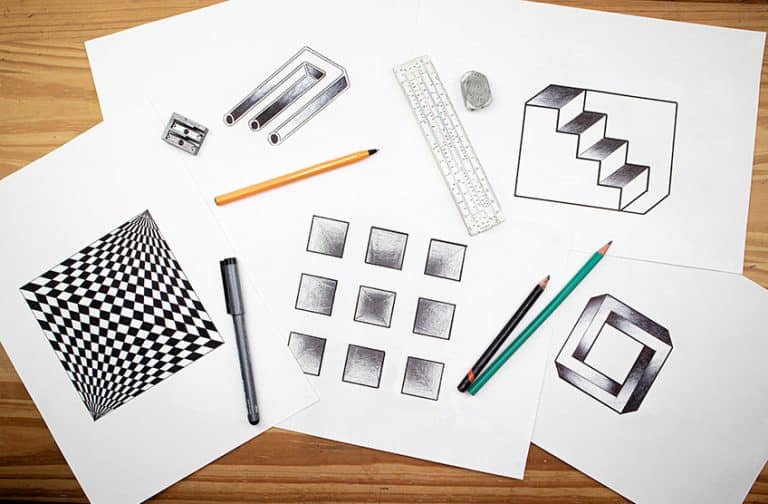
Optical Illusion Drawing – How You Use Optical Illusions in Art?
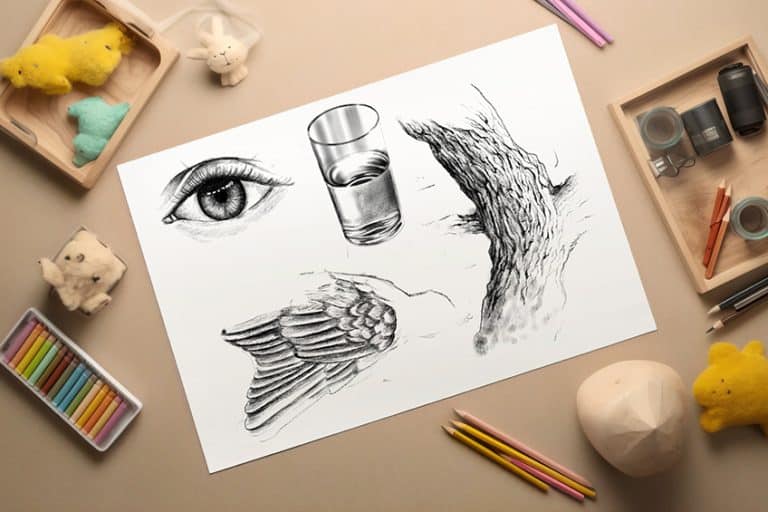
How to Draw Texture – A Masterclass in Drawing Techniques
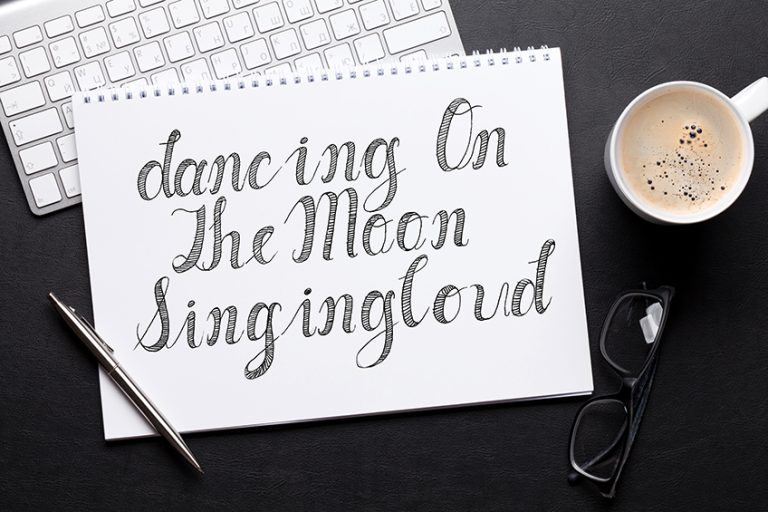
Faux Calligraphy – How to Create Simple Calligraphy Letters
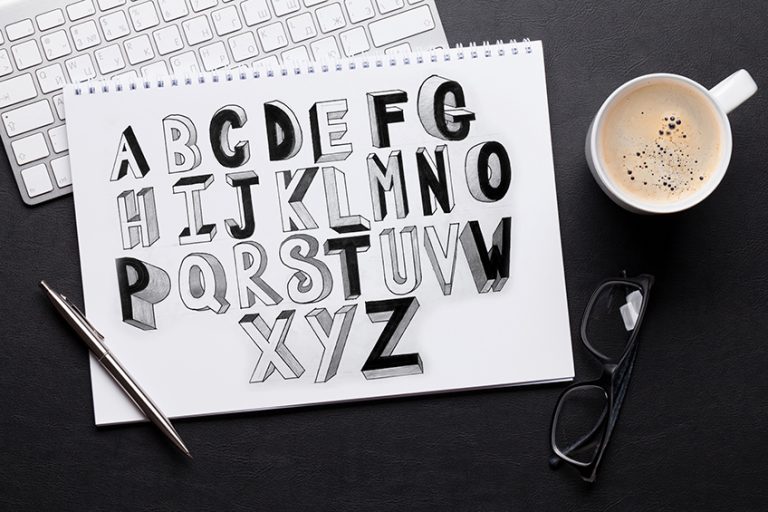
How to Draw Letters in 3D – A Dimensional Hand-Lettering Tutorial

Drawing Exercises – Learn How to Draw in Only 9 Days

Cross Hatching – Learning the Cross Hatching Technique
Leave a reply cancel reply.
Your email address will not be published. Required fields are marked *
Save my name, email, and website in this browser for the next time I comment.
- Cart $ 0.00
- Why Born To Draw?
- Born to Draw for Homeschool Parents and After School Programs
- Born to Draw for Adult Beginning Drawers
- Art Projects/Curricula
- Visual Literacy
- Teacher Training for Art Program iBooks
- Art Education Projects
- Materials: Adult Watercolor Class
- Materials: Born to Draw Children’s Art Drawing Program
- Materials: BTD Teachers Classroom List and by Child
- Materials: Classroom List for Step-By-Step Drawing
- Materials: Color Pencil Drawing and Rendering
- Materials: Drawing Basics
- Materials: Pastels
- Materials: Mixed Media
- Buy Materials at Dick Blick
- Born to Draw: Children’s Art Drawing Program
- Born To Draw: Drawing for Holidays and Special Occasions
- Drawing Perspective
- More iBooks
- Apple Volume Purchase Program
- Virtual Art Room
Children’s Art Gallery
- Submit a Drawing
- ArtMakers Contest
- About Workshops
- Workshops Overview
- Member Login
- Follow us on Twitter
- Join our Facebook Group
Why Doodling is Important
“I Draw Pictures All Day”
By Alma Hoffmann August 3rd, 2012 Creativity , Inspiration , Workflow
From Smashing Magazine — Creative Commons License Attribution 4.0
“So, you do nothing all day.”
That’s how many people would respond to someone who says they spend the day with a pen or pencil in their hand. It’s often considered an empty practice, a waste of time. They’re seen as an empty mind puttering along with the busy work of scribbling.
But for us designers and artists, drawing pictures all day is integral to our process and to who we are as creative people, and despite the idea that those who doodle waste time, we still get our work done. So, then, why are those of us who draw pictures all day even tempted to think that someone who is doodling or drawing pictures in a meeting or lecture is not paying attention?
What does it mean to be a doodler, to draw pictures all day? Why do we doodle? Most of all, what does it mean to our work? It turns out that the simple act of scribbling on a page helps us think, remember and learn.
What Does It Mean To Doodle?
The dictionary defines “doodle” as a verb (“scribble absentmindedly”) and as a noun (“a rough drawing made absentmindedly”). It also offers the origins of the word “doodler” as “a noun denoting a fool, later as a verb in the sense ‘make a fool of, cheat.’”
But the author Sunni Brown offers my favorite definition of “doodle” in her TED talk, “ Doodlers, unite! ”:
“In the 17th century, a doodle was a simpleton or a fool, as in “Yankee Doodle.” In the 18th century, it became a verb, and it meant to swindle or ridicule or to make fun of someone. In the 19th century, it was a corrupt politician. And today, we have what is perhaps our most offensive definition, at least to me, which is the following: “To doodle officially means to dawdle, to dilly dally, to monkey around, to make meaningless marks, to do something of little value, substance or import and,” my personal favorite, “to do nothing.” No wonder people are averse to doodling at work. Doing nothing at work is akin to masturbating at work. It’s totally inappropriate.”
It is no wonder, then, why most people do not have great expectations of those who “draw pictures all day.” Or perhaps they are inclined to think that those who draw pictures all day are not highly intellectual and are tempted to say to them condescendingly, “Go and draw some of your pictures.” As designers, many of us have heard such comments, or at least felt them implied, simply because we think, express or do things differently.
Why Do We Doodle?
Consider that even before a child can speak, they can draw pictures. It is part of their process of understanding what’s around them. They draw not just what they see, but how they view the world. The drawing or doodle of a child is not necessarily an attempt to reflect reality, but rather an attempt to communicate their understanding of it. This is no surprise because playing, trial and error, is a child’s primary method of learning. A child is not concerned with the impressions that others get based on their drawings or mistakes.
Their constant drawing, picture-making and doodling is a child’s way of expressing their ideas and showing their perceptions in visual form. It comes from a need to give physical form to one’s thoughts. Similarly, an adult doodles in order to visualize the ideas in their head so that they can interact with those ideas.
Visual Learners
According to Linda Silverman, director of both the Institute for the Study of Advanced Development and the Gifted Development Center and author of Upside-Down Brilliance: The Visual-Spatial Learner , 37% of the population are visual learners. If so many people learn better visually, we can expect, then, that some of them learn better by putting a speech, lecture or meeting into visual and tangible form through pictures or doodles, rather than by being provided with pictures or doodles (which would be the product of another person’s mind).
Humans have always had a desire to visually represent what’s in their minds and memory and to communicate those ideas with others. Early cave paintings were a means of interacting with others, allowing an idea or mental image to move from one person’s mind to another’s. The purpose of visual language has always been to communicate ideas to others.
Secondly, we doodle because our brain is designed to empathize with the world around us. According to Carol Jeffers, professor at California State University, our brains are wired to respond to, interact with, imitate and mirror behavior. In an article she wrote , she explains the recent research into “mirror neurons” which help us understand and empathize with the world around us.
Cave paintings were the first means of communication with each other
Cave paintings were our first means of communicating ideas to others.
Think of it this way. When you’re at an art gallery and find a painting that intrigues you, what is your first reaction? You want to touch it, don’t you? I thought so.
When I was a ballroom dancer, I used to sit and watch those who I considered to be great dancers, tracing their forms in space with my index finger as a way to commit them to memory. I used to go to galleries and museums and, at a distance, trace the lines and forms that I saw in the paintings and designs. I did this out of curiosity and a desire to physically record what I saw to memory.
Nearly 100 years ago, Maria Montessori discovered the link between physical touch and movement and learning in children. Montessori education teaches children to trace the letters of the alphabet with their index finger as a way to commit their shapes to memory. My son used to trace forms that he found interesting in space. It’s safe to say, then, that we doodle to visually commit to memory a concept that we want to both empathize and interact with.
An experiment conducted by Jackie Andrade , professor of psychology at the University of Plymouth in England, demonstrated the positive effect that doodling has on memory retention. In the experiment, 40 people were given a simple set of instructions to take RSVP information over the phone from people going to a party. The group of 40 was divided in two. One group of 20 was told to doodle (limited to shading in order not to emphasize the quality of the doodles), and the other 20 would not doodle.
The doodlers recalled 29% more information. Doodling helps us retain information.
The study showed that doodling helps the brain to focus. It keeps the mind from wandering away from whatever is happening, whether it’s a lecture, reading or conference talk.
Still, we have become bored with learning.
Professor Emeritus at Cornell University, Joseph D. Novak argues that this is because we have been taught to memorize but not to evaluate the information being given to us. In many traditional settings, the pattern is simple and dull: sit, receive and memorize. Many traditional educational systems do not encourage active engagement with the material. Doodling, drawing and even making diagrams helps us not only engage with the material, but also identify the underlying structure of the argument, while also connecting concepts in a tactile and visual way. Jesse Berg, president of The Visual Leap , pointed out to me in a conversation that doodling is a multisensory activity. While our hand is creating what might seem to be random pictures, our brain is processing the stimuli that’s running through it.
Many of us are the product of traditional schooling, in which we were made to numbingly memorize dates and facts, and many of us continue this pattern later in life. While some of us were avid doodlers (I used to fill the backs of my notebooks with pictures and draw on desks with a pencil during class), some of us stopped at high school, others in college and others once we settled into a job. At some point during the education process, doodling was discouraged. Teachers most likely viewed it as a sign of inattentiveness and disrespect. After hard preparation, educators want nothing more than unwavering attention to their lectures. The irony is that, according to Andrade’s study , doodlers pay more attention to the words of educators than we think.
In her TED talk , Sunny Brown goes on to explain the benefits of doodling and even offers an alternative to the definition found in the Oxford Dictionary:
“Doodling is really to make spontaneous marks to help yourself think. That is why millions of people doodle. Here’s another interesting truth about the doodle: People who doodle when they’re exposed to verbal information retain more of that information than their non-doodling counterparts. We think doodling is something you do when you lose focus, but in reality, it is a preemptive measure to stop you from losing focus. Additionally, it has a profound effect on creative problem-solving and deep information processing.”
How Can Designers Use This To Their Benefit?
As designers, we have a unique advantage when it comes to doodling. We don’t just doodle to keep our minds focused — we also deliberately sketch ideas in order to problem solve and to get immediate feedback from clients and peers. Designers such as Craighton Berman and Eva-Lotta Lamm are two of the biggest proponents of the “sketchnotating” movement. Berman states that sketchnotating “forces you to listen to the lecture, synthesize what’s being expressed, and visualize a composition that captures the idea — all in real time.”
A designer’s best friend: a sketch pad
In 2009, I came across a book titled The Back of the Napkin by Dan Roam. Roam is a business strategist and founder of Digital Roam, a management-consulting firm that uses visual thinking to solve complex problems. He uses a simple approach to solving problems visually. Every idea is run through five basic questions to encourage engaged thinking and to ensure a meaningful meeting. The process takes the acronym SQVI^. S is for simple or elaborate, Q is for qualitative or quantitative, V is for vision or execution, I is for individual or comparison, and ^ is for change or status quo. These simple choices are worked through with simple doodles in order to better understand the problem and find a solution. In his book, Roam says:
“What if there was a way to more quickly look at problems, more intuitively understand them, more confidently address them, and more rapidly convey to others what we’ve discovered? What if there was a way to make business problem solving more efficient, more effective, and — as much as I hate to say it — perhaps even more fun? There is. It’s called visual thinking, and it’s what this book is all about: solving problems with pictures.”
After discovering Roam’s book, I decided to doodle again. Once a prolific doodler and drawer, I had become inactive in lectures and similar settings, often forgetting what was said. Taking notes felt too cumbersome, and I often missed words and ideas. I decided to give doodling another shot. Instead of focusing on specifics, I would focus on concepts, key words and ideas.
Since 2011, I have been actively promoting doodling in my design classes, making a deal with my students, saying to them, “Doodle to your heart’s content, but in return I want you to doodle the content of my lectures.” They are skeptical at first, but they soon realize that doodling is better than having a quiz. I reap the benefits of doodling, and by allowing them to doodle — with the requirement that it be based on the class’ content — they become more informed of the topic and they engage in more meaningful conversations about design.
Doodle by Alisa Roberts from my “Introduction to Typography” course.
The typographic novices in my classes naturally start to apply the principles of visual hierarchy and organization, grouping ideas either by importance or by category. They will group ideas with lines, boxes, marks and more. Headings and lecture titles might be made larger, more ornate or bolder, and key concepts might be visually punctuated. It is fascinating how natural and almost second-nature the idea of visual hierarchy is to all of us. The learning curve of typography is steep for some of us, but doodling and sketchnotating really makes it easier to grasp. Below are some doodles by students in my classes. Doodle by Alisa Roberts from my “Introduction to Typography” course.
By picking out concepts, ideas and topics, the students start to establish a hierarchy by making visual groupings and start to use visual punctuation. By the time I assign work on typographic hierarchy, the sketches tend to show more astuteness. Transferring these sketches to the computer is a challenge for those new to typography, but once they naturally understand the relationships in what they are doing, they start to make smarter design decisions.
Doodle by Aubrie Lamb from my “Identity and Branding” course.
Another by Aubrie Lamb from the same course.
As we have seen, doodling has many benefits, beyond what designers as visual communicators and problem solvers use it for. Doodling also helps our brain function and process data. Those of us who doodle should do so without feeling guilty or ashamed. We are in good company. Historically , doodlers have included presidents, business moguls and accomplished writers. Designer, educator and speaker Jason Santa Maria says this :
“Sketchbooks are not about being a good artist. They’re about being a good thinker.”
Doodling, drawing pictures and sketchnotating are about using visual skills to solve problems, to understand our world and to respond effectively. So, what are you waiting for? Doodle!
Kudos Alma Hoffman! I like your story and it is in line with how we should encourage visual thinking in core curricula – Elaine Cimino
Leave a Reply
Leave a reply cancel reply.
Your email address will not be published. Required fields are marked *
Save my name, email, and website in this browser for the next time I comment.
Subscription Memberships
Subscription Memberships for Classrooms or School Campus Sites, Home School or Afterschool Enrichment
Blog Categories
- Adult Workshops
- Art Education
- Art Exhibitions
- Children's Art Education
- Children's Classes
- Educators Input & Editorials
- Guest Writers
- How-to Videos
- Kid's Exhibitions
- Parents and the Arts
- Private Lessons
- Uncategorized
Latest Tweets
- Join us to learn about integrating art into your classroom #constantcontact http://t.co/DLoP3xSXlZ May 9, 2013 - 8:14 am
- Presenting Born to Draw #constantcontact http://t.co/5Udr5oZdUe May 2, 2013 - 11:38 am
- Register for Born to Draw #borntodraw #constantcontact http://t.co/C54UIqhwuW May 1, 2013 - 2:17 pm
Search the Site
Rio grande educational collaborative.

Business Partner's since 2012 For After School Program Offerings
Newsletter Signup
Unm continuing education youth programs.

Born to Draw Saturday Morning Children's Art Class
Recent Blog Posts
- Offering of Intermediate Adult Art Classes In Portraiture, Watercolor and Pastel
- 2016 Spring Art Lessons for Children @ Rio Rancho UNM WEST
- ART IN ANY CLASSROOM
Cooperative for Educational Services

Cooperative for Educational Services Contractor Since 2013--2015 Educational Consultant and Educational Learning Materials Provider Enhancing Art Education
New Mexico Kids

See our web ads on their Website!

Albuquerque Apple Developers and eBook Publishers
- Send us Mail
- Subscribe to our RSS Feed
Advertisement
Doodle nation: notes on distracted drawing, arts & culture.
The art and life of Mark di Suvero
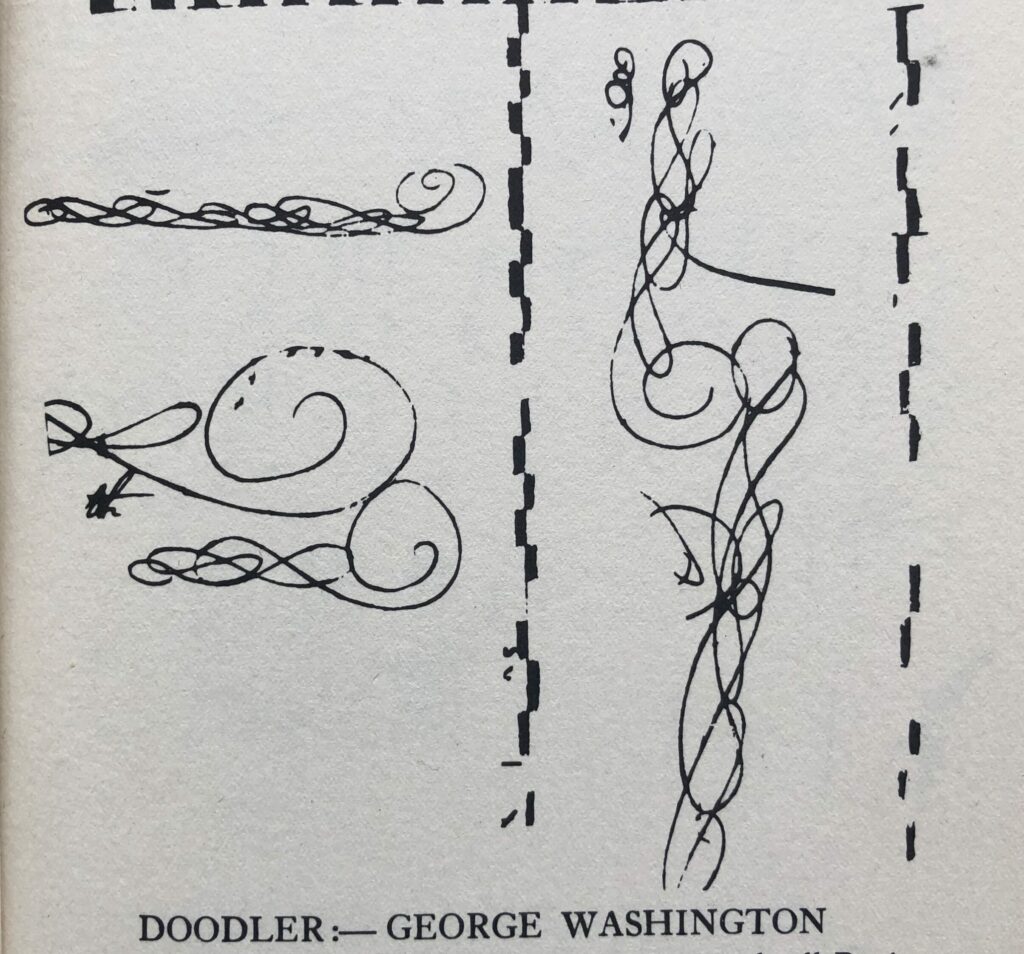
Some doodles by George Washington. Page from Everybody’s Pixillated: A Book of Doodles by Russell M. Arundel, 1937. Photograph by Polly Dickson.
Doodling today is not what it was. Or is it? Google “doodle” and you’ll find the Google Doodle—what Google calls a “fun, surprising, and sometimes spontaneous” transformation of its logo by a team of dedicated Doodlers to commemorate significant, and not so significant, days: from the seventy-fifth anniversary of the publication of Anne Frank’s diary to “Chilaquiles day.” You will also find a long list of apps that take Doodle as their name, including the ubiquitous scheduling tool. This recasting of the word in the age of the internet takes us far from the freewheeling squiggles, squirls, and whirls decorating the margins of telephone books and notepads—which is, perhaps, what doodling once was, in some near-unimaginable bygone era, when we worked with pens and pencils on paper, and when our attention and our hands wandered in different ways.
“Doodling” describes an activity of spontaneous mark-making by an agent whose attention is at least partially directed on something else. It’s the doodle’s apparent spontaneity and whimsy, but also its complicated relationship to attention—that most anguished-over of modern commodities—that makes it ripe for exploitation by the marketing strategies of app-based companies. That is: the doodle is usefully positioned, around the edges of our work documents and our conscious thought, to help us think about how our minds wander and about what those forms of wandering might yield. In a self-styled “doodle revolution,” which she introduces in a TED Talk and a book, Sunni Brown, founder of a “visual thinking consultancy,” explicitly attempts to capitalize on doodling’s wayward energies. Brown praises the potential of doodling for the workplace, coining a technique that she calls “infodoodling” as a tool for honing the attention of workers and thus increasing their “Power, Performance, and Pleasure” (plus, presumably, productivity—and profit). The goal is to “unlock” the potential of “visual language” to realize the full potential of our brains and “to help [us] think” in different ways. Brown’s self-styled revolution sits within a broader trend toward rehabilitating the act of disinterested drawing, as a kind of salve to our frayed modern attention spans. The doodle-curious consumer will find online a baffling array of derivative self-help- and wellness-flavored “guides” to doodling, full of promises to help us “Discover [our] Inner Whimsy and Find Moments of Mindfulness,” as the Daily Doodle Journal has it, or to “enhance your creativity,” according to another notebook of the same name. Doodling, or: how to cash in on the mind at play.
The activity of distracted drawing was first named “doodling” at a very particular moment: in the 1936 Frank Capra film Mr. Deeds Goes to Town . To be clear, the word “doodle” already existed. It possibly derives from the German dudeltopf , meaning “simpleton,” cementing a strand of aimlessness or surplus value that persists in its current form. Before the twentieth century, it was used to refer to a “simple or foolish fellow.” It is in a courtroom scene toward the end of Mr. Deeds Goes to Town that the word was coined in its current meaning: distracted drawing. The film’s oddball protagonist Longfellow Deeds has been proclaimed insane by his relatives for, amongst other things, playing the tuba and giving away his inheritance money. In his defense, Deeds argues that he plays the tuba to help himself think, and points out that everybody is subject to such inane, or insane, distracted fiddlings (or in the idiom of the film, “everybody’s pixillated,” meaning something like “away with the pixies”). Not least pixillated of all is the court psychotherapist, Emile von Haller, who has been trying to make a case for Deeds as a manic depressive. It is the psychotherapist’s own doodle that Mr. Deeds triumphantly exposes in the film, calling von Haller a “doodler,” which, he explains, “is a word we made up back home to describe someone who makes foolish designs on paper while they’re thinking”:
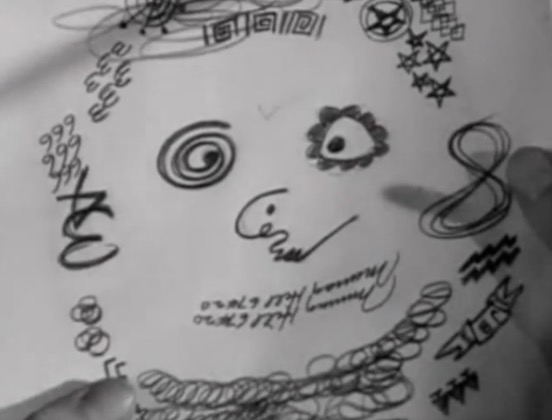
From Mr. Deeds Goes to Town . Screenshot courtesy of Polly Dickson.
Our modern understanding of a doodle thus has its premise in a fictional work. What Deeds shows us is the first doodle to be called a doodle, but of course it’s not one; it’s a drawing of a doodle . It’s as if here the scriptwriter has aimed to include all those archetypal forms that we are likely to find ourselves drawing when bored—stars, numbers, swirls, figure eights—drawing them together into the shape of a manic-looking face, such that it can be easily “read.” This gives it a satisfying finish, the snap of recognition. The fantasy of a doodle here, as a signifying system, bears witness to the investments we make in them—those investments have to do with clear, correspondent meaning. If it is mad it is also productive in a quiet and legible manner.
Whilst humans have presumably doodled for as long as they have written and drawn (the art historian Ernst Gombrich has studied the idle scribblings made by Napoli bankers on their ledgers in the fourteenth century), once psychoanalysis had begun to imagine the doodle as a key to understanding the unconscious mind, it was no longer possible to doodle innocently. Mr. Deeds Goes to Town , with its Austrian psychotherapist a parody of Freud, is a response to a frenzy for all things psychoanalysis in the thirties. Carl Jung, Hans Prinzhorn, and Alfred Adler had all previously written about the significance of our absentminded drawings or Kritzeleien (a word that is better translated as “scribblings”) in a psychotherapeutic context.
In Capra’s film, when Deeds asserts the universality of doodling and fidgeting, the doodle emerges, with its new name, from psychoanalytic papers into the Anglo-American mainstream consciousness. (Victoria Riskin has blogged about the “grave injustice” committed by the Merriam-Webster dictionary in failing to attribute to her father, Robert Riskin—the screenwriter of the film—the first use of the word in its current sense.) The doodle gained its name in a self-mockingly circular logic whereby the doodle is declared singular and meaningful only in order to show that the analyst himself is as mad as everybody else. All of this was in service of defending Longfellow on the charges of madness for having given his inheritance money away, drawing both money and doodles into the task of proving or disproving one’s madness. From this moment on, the doodle would continue to be caught up in an intensifying desire to make use of such drawings, to see what they might yield.
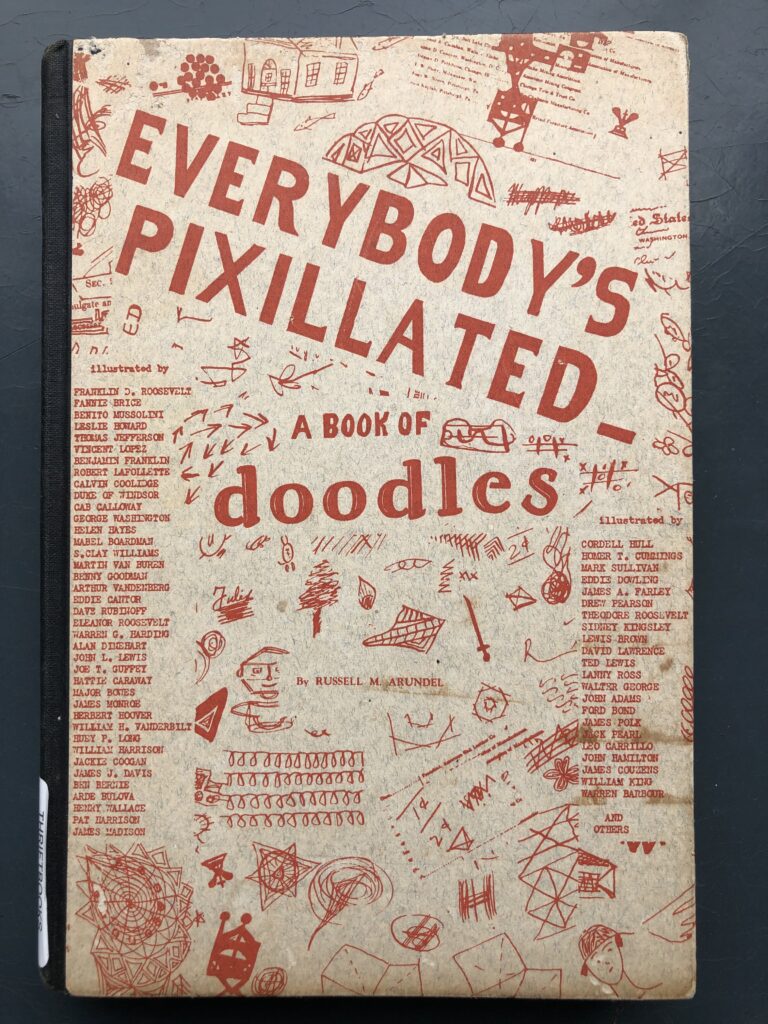
Cover of Everybody’s Pixillated: A Book of Doodles by Russell M. Arundel, 1937. Photograph courtesy of Polly Dickson.
A book that consolidated the word’s contemporary meaning is a strange, slim volume by Russell M. Arundel called Everybody’s Pixillated —a direct citation of Capra’s film—first published in 1937. Across its pages are reproductions of scrappy marginal drawings, documents of “priceless surrealism” sketched, scribbled, and doodled by presidents, senators, the Prince of Wales, lawyers, and other notable figures (almost all of them men).
Everybody’s Pixillated is both a paper exhibition of doodles and a whimsical manifesto in favor of paying attention to the chatterings of the unconscious mind. A case study at the heart of the book cements Arundel’s basic premise that doodles are pictorial clues to the secrets of what he affectionately terms “old man subconscious.” According to this story, a certain Private Marvin Shores liquidated his assets and buried the gold and silver bullion somewhere on his grandfather’s estate before going off to fight in World War I. When Shores returned in 1918, suffering from what was then called shell shock, his grandfather was dead and he had no memory of where he had buried his treasure. It was from the doodles he made during a telephone conversation—“crude drawings of rabbits, sketches resembling guns, and the word ‘booty’ ”—that a friend familiar with the secrets of “automatic writing” was able to help him unlock the location of his treasure: buried beneath an old rabbit hutch. Whether this little story is apocryphal or not does not really matter in the context of Arundel’s project. For it works as a founding myth of doodling and doodle-reading, justifying Arundel’s excavatory enterprise with the promise of unconscious treasure ready to be unturned. This version of doodling’s founding myth, like the scene in Mr. Deeds Goes to Town, is centered on capital. Paying attention to doodles will convert the apparent work of distraction back into attentional currency—and hard gold. This is the real work of making doodles mean.
Arundel’s doodle book takes Riskin at his word, and is premised on the notion that everybody is inhabited by the compulsion to doodle. “This is a pixillated book for pixillated people,” he declares mischievously in the foreword. It is, in one sense, the document of one man’s obsessive pareidolia: that state of mind perched tantalizingly close to the state of paranoia, in which meaningless or random marks are configured into a message or picture, as when we catch a glimpse of a face in a wall or a buttered slice of toast or in a coffee stain. His analysis of Theodore Roosevelt’s boats and scribbles is delivered with a poetic sparseness: “Dreamer. Very exacting. Careful. Analytical.”
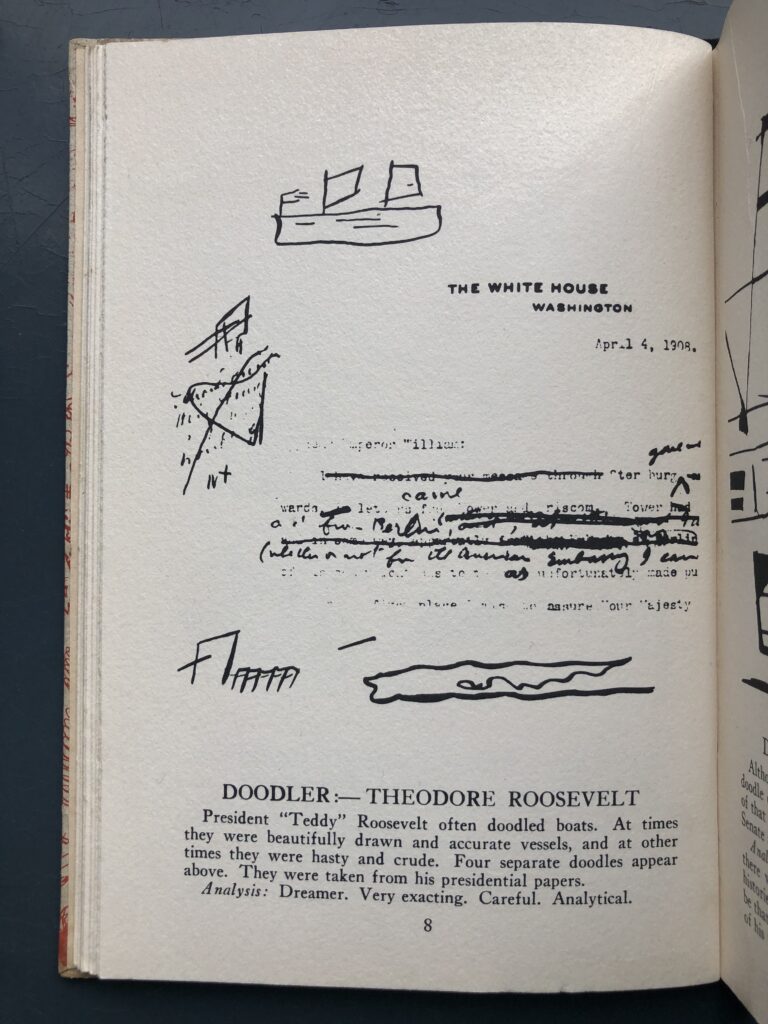
Page from Everybody’s Pixillated: A Book of Doodles by Russell M. Arundel, 1937. Photograph by Polly Dickson.
Are we mad because we doodle—even the most apparently rational minds amongst us, even those politicians whose drawings, some of them quite baffling indeed, feature in this book? Or are we mad because we are irresistibly drawn to such images and to the impossible task of decoding them? Here is another contradiction aroused by the doodle: that what seems like an intensely private activity can in fact trace our relationships to other people; that the doodle has a kind of social life.
Arundel was, by all accounts, something of an eccentric. Having worked as a lawyer at Capitol Hill, in the presence of the politicians whose scrappy papers he was able to salvage from the waste paper basket, Arundel was also the president of the Pepsi-Cola Bottling Company of Long Island, a keen hunter and fisherman, and, more surprisingly, founding father of the Principality of Outer Baldonia, a micronation in Nova Scotia that existed for twenty-four years. This odd episode in Arundel’s life is the story of a fabricated reality, an irresistible parody of nation building, that made Arundel into an unlikely hero of the Cold War.
In 1948, Arundel purchased for $750 a four-acre island off the Tusket Islands that he had come across whilst fishing. He called it Outer Baldonia, proclaimed himself Prince of Princes, and limited the citizenship of his newly founded principality first to men, then to tuna fishermen. Back in Washington, Arundel and his subjects managed to get their dubious male utopia onto an official map of Canada and drew up laws, a national flag, and a currency, the Tunar. They even sketched out a declaration of independence:
Let these facts be submitted to a candid world. That fishermen are a race alone. That fishermen are endowed with the following inalienable rights: The right of freedom from question, nagging, shaving, interruption, women, taxes, politics, war, monologues, cant, and inhibitions. The right to applause, vanity, flattery, praise, and self-inflation. The right to swear, lie, drink, gamble, and silence. The right to be noisy, boisterous, quiet, pensive, expansive, and hilarious. The right to sleep all day and stay up all night.
As a bit of hypermasculine silliness, this declaration of the legal rights of its citizens to lawlessness is written in the good-humored register of Carrollian hyperbole. It was also an immense feat of bureaucracy. When a writer of the Moscow Literary Gazette took (or seemed to take) the wording of the constitution seriously and declared Arundel a tyrant, Arundel responded, fully in the spirit of things, by formally declaring war on the Soviet Union. Needless to say, it all came to nothing, and in the seventies Arundel sold Outer Baldonia to a society for the protection of birds for a single dollar.
In both the doodle book and the fictional nation, Arundel rouses up the nonsensical underside of bureaucratic processes. Both are governed by a dreamlike, “pixillated” logic of overturning our expectations of paperwork. In the doodle book, he exposes the unexpected byproducts of writing, thinking, and paying attention; in the Outer Baldonia episode, he conjures up a fictional state that, on paper only, resembles a real one. Arundel was interested in the indiscriminate chatter that tangles and clusters at the edges of our conscious thoughts and decision-making processes. A significant portion of the doodle book is given over to an autographic history of the process of writing out an agricultural relief bill—or rather, the ways in which it is “doodled into shape”—and passing it through Congress and Senate. Arundel, in the guise of enthusiastic “doodlebug,” narrates this version through the doodles of its authors. Stately political processes, he shows, go hand in hand with the madcap arabesques, squiggles, and scribbles of politicians’ scrap paper. Doodling here is writing’s other self, its shadow form.
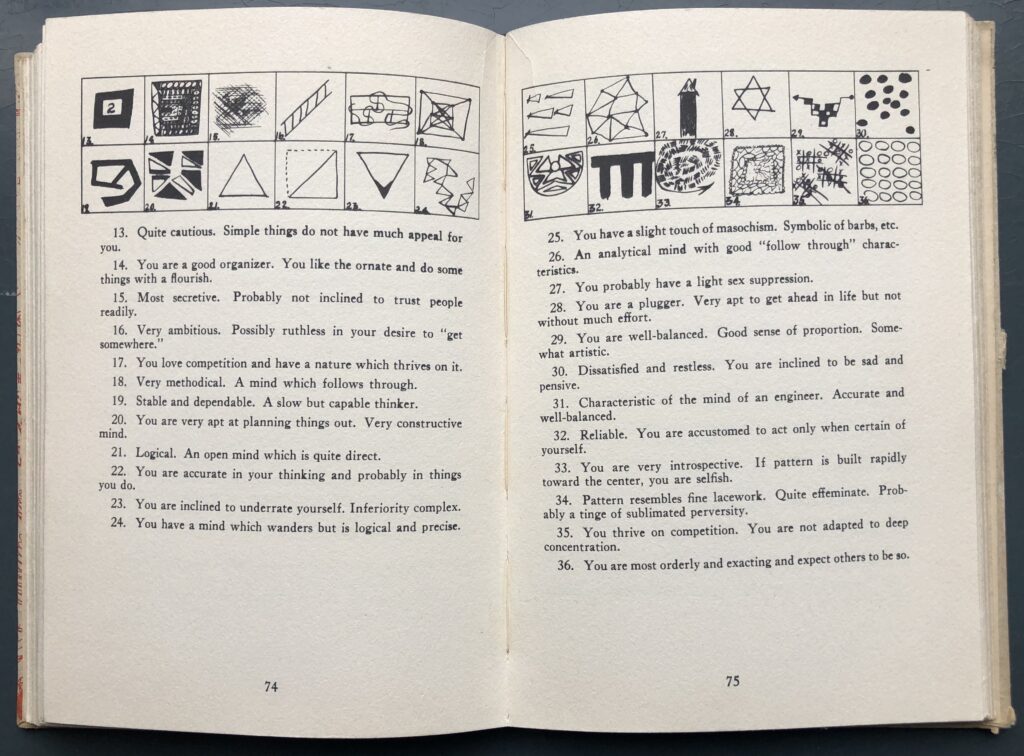
From Everybody’s Pixillated: A Book of Doodles by Russell M. Arundel, 1937. Photograph courtesy of Polly Dickson.
As much as they tell us about writing, doodles tell us about reading. They get at the heart of the critical act by seeming to solicit interpretation, then skittering away when we get down to the business of studying them. They might, after all, register no more than the inky imprints of the pleasures of mark-making or the necessity of testing the pen. Take a doodle too seriously, and you risk finding only your own desire for meaning bounced back at you. Despite Arundel’s tongue-in-cheek taxonomizing, and the earnest efforts of graphologists ever since, no systematic vocabulary for the understanding or critical interpretation of doodles, no Doodle Dictionary, has ever gone mainstream. And of course that’s the point. By telling us how to read them, Arundel is asking us a question about reading. It’s a fitting quirk of Arundel’s own life that in the Outer Baldonia episode he seems to have attracted, in the character of the Russian journalist, precisely the kind of exaggerated seriousness the doodle book flirts with (although, to be fair to the Russian journalist, nobody seems clear on whether he was engaging in satire of his own). For the book knows itself to be a kind of joke: its motive, he states on the first page, “is good humor.” “If the chart doesn’t happen to tell the truth,” Arundel reminds us, “just remember the foreword—‘This is a pixillated book for pixillated people.’ ”
Whether or not we see doodles as subversions of work, as what art therapist and historian David Maclagan (who has studied the history of the doodle) has called a kind of “graphic truancy” or “miniaturized graffiti,” or as hieroglyphs of hidden parts of the self, or as a way of unleashing hidden potential and maximizing our performance as workers—or as performing some other kind of work—the most fascinating things about doodles are the desires of their readers.
Pixillation attracts and engenders pixillation. This book about doodles is a book about how we pay attention to each other, about the forms of attention we are able to pay or give. Although Arundel’s book is a dazzling treatise on paying attention to parts of the human mind that cannot usually be caught and directed by such attention, at its heart, really, is the curious figure of the self-titled “doodlebug,” who pictures himself creeping gleefully between wastepaper baskets in the offices of congress, asking senators to hand over their scrap paper.
Polly Dickson is an assistant professor in German at Durham University. She is the author of Romanticism, Realism, and the Lines of Mimesis and is at work on a project on doodles.
How Jon Burgerman Turned Doodling into a Day Job

Portrait of Jon Burgerman. Photo by Bas Berkhout. Courtesy of the artist.
Jon Burgerman, Rhyme Crime . Courtesy of the artist.
Doodling—the free-wheeling approach to drawing favored by kids and artists alike—may at first seem like a mindless or futile activity, but research in recent years has proven that it aids concentration and creativity . It’s no surprise that the great 20th-century French artist Jean Dubuffet conceived his most famous series of paintings and sculptures, “L’Hourloupe,” while talking on the phone and doodling with a ballpoint pen. Today, over five decades later, a wave of artists continues to employ doodling as a viable method to fuel creativity—and even, in the case of a few, a full-fledged creative career.
Prominent among such “doodle artists” is the British, Brooklyn-based artist Jon Burgerman . It’s possible you’ve seen his work via Instagram (he often draws funny faces on photos of food or adds dancing hot dogs to New York street scenes; last year, his Instagram Stories were featured at the Tate Modern in London) or in the pages of a clever children’s book, like the new title Rhyme Crime . Maybe you’ve spied his dancing noodles mural at Xi’an Famous Foods in Chinatown, or the scribble-filled sneakers he designed for Puma. Burgerman has worked with major brands, like Nike, MTV, and Apple, and along the way he’s been spreading the gospel of doodling among children and adults alike, through various books and workshops.
“It was meant to be a bit of a gag,” he said, speaking from his studio at the Invisible Dog Art Center, in Boerum Hill, Brooklyn. “People would ask me what is it that you make, and in a self-effacing kind of way I would say ‘Oh, it’s just doodles.’ In a funny way, it stuck over the last 20 years or so, and now I have people emailing me and saying, ‘I make doodle work just like you!’”

Mural by Jon Burgerman in Los Angeles, CA. Courtesy of the artist.
Like many, Burgerman’s artistic inclinations trace back to childhood, growing up in Birmingham, England. “It was impossible to walk past a window with condensation or a muddy car and not draw something with my index finger,” he recalled, adding that he would fill the margins of test papers with doodles at the end of an exam, in lieu of checking his work (“I got in trouble quite a bit, innocently drawing on stuff”).
He reasons he’s been working in vaguely the same vein since art school at Nottingham Trent University. He was painting and drawing, but for his final degree show, inspired by museum gift shops, he built a makeshift boutique filled with lo-fi, handmade trinkets. “I didn’t realize then that I would go on and license my works and make products like these for real,” Burgerman said.
The artist has since fully embraced his commercial side; today, you can buy everything from ceramic mugs and notebooks, to iPad sleeves, wallpaper, and temporary tattoos sporting his playful creations.
A new area of focus has been children’s books, an industry he tapped into through a recommendation from friend and fellow artist Oliver Jeffers (a leading artist in children’s book publishing). Burgerman’s first picture book, Splat! , was published last June. His second children’s book, Rhyme Crime —which follows a clever, rhyming crook—will publish in the United States this April.

“I may start out saying I’m going to paint this or draw this, but I’m never quite sure how it's going to work out.”
Part of the goal is simple, honest enjoyment. “I’m making stuff that satisfies my need to be creative, and also makes me smile or laugh,” he explained. Indeed, he noted that he’s in his “happiest state” when he’s able to make things, whether that’s with a pen, his iPhone, or Instagram’s drawing tools. It’s a satisfaction he aims to share with others.
“It feels like you’re summoning this sort of super power, to know that you can manipulate the world around you to create something,” he mused. It’s this kind of empowered thinking that inspired his 2017 books, It’s Great to Create and Daily Doodle , both of which encourage individuals to make drawing a part of their everyday lives, and his Doodle School, a series of drop-in workshops he held in New York that engaged adults in wacky, Burgerman-style art projects.

Pages from Jon Burgerman’s Daily Doodle . Courtesy of the artist.
“A lot of people say ‘I’m not good at art, so I shouldn’t really do it,’ but who's to say what’s good and bad?” he offered. “I try and show in all my work how it’s been made, and hopefully that triggers something in your brain, so you say ‘Hey, I could do that.’”
Burgerman’s Doodle School likewise puts the emphasis on having fun and being creative, rather than making artworks that might end up in a gallery. The lessons revolve around exercises with simple materials, markers, and paper. There’s no training necessary and the focus is on spontaneity.
“As soon as you take away that pressure people go for it,” Burgerman explained. “We all grew up with clay and some scribbling, it’s innate in us, but at a certain age that’s taken away from us. It’s not considered grown-up, in a way.”
He’s witnessed many adults quickly become swept up in a childlike wonderment. “It’s very infectious. I’m very keen to share that with people,” he reflected. “We should have these pockets of joy all the time.”

- Vertical The Example Article Title Longer Than The Line By Example Name Jan 1, 1970

Doodling: A Positive Creative Leisure Practice
- First Online: 25 June 2020
Cite this chapter

- Priyanka Baweja 7
Part of the book series: Leisure Studies in a Global Era ((LSGE))
1088 Accesses
5 Citations
Leisure can be expressed in various states—physical, intellectual, social, sacred, energetic, inert, observer, artistic or imaginative. Doodling is one of the creative expressions which each one of us has done in our life. Doodles are simple drawings just composed of random abstract lines or it can even have realistic meaning. Although many people still consider doodling as an indication of disinterest but Sunny Brown’s ( The doodle revolution; Unlock the power to think differently. New York: Penguin Putnam Inc., 2014) “The Doodle Revolution” is a perfect case against such concerns as the book aims to radically overturn social misperceptions about doodling. This chapter explores doodling as a creative leisure activity. Specifically, it examines how people creatively self-express by doodling and how this expression helps evoking positive emotions and making individuals smarter, happier and more productive.
This is a preview of subscription content, log in via an institution to check access.
Access this chapter
Subscribe and save.
- Get 10 units per month
- Download Article/Chapter or eBook
- 1 Unit = 1 Article or 1 Chapter
- Cancel anytime
- Available as PDF
- Read on any device
- Instant download
- Own it forever
- Available as EPUB and PDF
- Compact, lightweight edition
- Dispatched in 3 to 5 business days
- Free shipping worldwide - see info
- Durable hardcover edition
Tax calculation will be finalised at checkout
Purchases are for personal use only
Institutional subscriptions
Similar content being viewed by others

Leisure and Meaning-Making: The Pursuit of a Meaningful Life Through Leisure

Hedonism, Eudaimonia, and the Serious Leisure Perspective

Leisure Experience and Engaged Buddhism: Mindfulness as a Path to Freedom and Justice in Leisure Studies
Andrade, J. (2009). What does doodling do? Applied Cognitive Psychology, 24 (1), 100–106. https://doi.org/10.1002/acp.1561
Article Google Scholar
Battles, M. (2009, August 24). In praise of doodling . Retrieved from Hilobrow: http://www.hilobrow.com/2009/08/24/in-praise-of-doodling/
Brown, S. (2011, March). Doodlers unite (Video file). Retrieved from https://www.ted.com/talks/sunni_brown_doodlers_unite
Brown, S. (2014). The doodle revolution; Unlock the power to think differently . New York: Penguin Putnam Inc..
Google Scholar
Business Standard. (2017, June 14). Doodling can make you feel happy rewarded . Retrieved from https://www.business-standard.com/article/current-affairs/doodling-can-make-you-feel-happy-rewarded-study-117061400775_1.html
Conner, T. S., DeYoung, C. G., & Silvia, P. J. (2018). Everyday creative activity as a path to flourishing. The Journal of Positive Psychology, 13 (2), 181–189.
Cowan, L. G., Weibel, N., Pina, L. R., Hollan, J. D., & Griswold, W. G. (2011). Ubiquitous sketching for social media. In Proceeding MobileHCI ‘11 Proceedings of the 13th International Conference on Human Computer Interaction with Mobile Devices and Services (pp. 395–404). New York, NY: ACM. https://doi.org/10.1145/2037373.2037433 .
Culhane, D. (2017). If you can doodle, you can paint: Transforming simple drawings into works of art . Beverly, MA: Quarto Publishing Group.
Edginton, C., Jordan, D., Degraaf, D., & Edginton, S. (2002). Leisure and life satisfaction: Foundational perspectives . New York: McGraw-Hill.
Edginton, C. R., & Chen, P. (2014). Leisure as transformation . Urbana, IL: Sagamore Publishing.
Eisner, E. W. (1999). Does experience in the arts boost academic achievement? The Clearing House: A Journal of Educational Strategies, Issues and Ideas, 72 (3), 143–149. https://doi.org/10.1080/00098659909599615
Gupta, S. (2016, May 10). Doodling: The artistry of the roving metaphysical mind. Journal of Mental Health and Human Behaviour, 21 (1), 16–19. https://doi.org/10.4103/0971-8990.182097
Hanusiak, X. (2009, October 6). The lost art of doodling . Retrieved from The Sydney Morning Herald: https://www.smh.com.au/politics/federal/the-lost-art-of-doodling-20091006-gkah.html
Iso-Ahola, S. E., & Crowley, E. D. (1991). Adolescent substance abuse and leisure boredom. Journal of Leisure Research, 23 (3), 260–271. https://doi.org/10.1080/00222216.1991.11969857
Johnson, A., & Backman, K. F. (2010). Leisure and community types as indicators of overall quality of life. World Leisure Journal, 52 (2), 104–115.
Kabanda, P. (2015). Work as art: Links between creative work and human development. Retrieved from United National Development Programme: http://hdr.undp.org/en/content/human-development-report-2015-work-human-development
Kaimal, G., Ayaza, H., Herresb, J., Dieterich-Hartwella, R., Makwanaa, B., Kaisera, D. H., et al. (2017, September). Functional near-infrared spectroscopy assessment of reward perception based on visual self-expression: Coloring, doodling, and free drawing. The Arts in Psychotherapy, 55 , 85–92. https://doi.org/10.1016/j.aip.2017.05.004
Kniveton, C. C. (2017, August). How can the art making process foster a stronger sense of self? Master Thesis, University of Northern Colorado. Retrieved from http://digscholarship.unco.edu/arp/11
Malchiodi, C. (2014, January 13). Doodling your way to a more mindful life . Retrieved from Psychology Today: https://www.psychologytoday.com/intl/blog/arts-and-health/201401/doodling-your-way-more-mindful-life?amp
Pillay, S. (2016, December 15). The “thinking” benefits of doodling . Retrieved from Harvard Health Blog: https://www.health.harvard.edu/blog/the-thinking-benefits-of-doodling-2016121510844
Qutub, A. (2012). Communicating symbolically: The significance of doodling between symbolic action and psychoanalytical perspectives . Retrieved from http://www.calstatela.edu/sites/default/files/groups/Colloquy%20Front%20Page/qutub_essay.final_.pdf
Rabin, J. (2017, July 13). Stuck in a creative rut? Here’s how doodling can help you unlock new ideas . Retrieved from PR Newswires: https://mediablog.prnewswire.com/2017/07/13/stuck-in-a-creative-rut-heres-how-doodling-can-help-you-unlock-new-ideas/
Schott, G. (2011, September). Doodling and the default network of the brain. The Art of Medicine, 378 (9797), 1133–1134. https://doi.org/10.1016/S0140-6736(11)61496-7
Siagto-Wakat, G. (2017). Doodling the nerves: Surfacing language anxiety experiences in an english language classroom. RELC Journal, 48 (2), 226–240. https://doi.org/10.1177/0033688216649085
Stebbins, R. A. (2017). Leisure Activities in Context: A Micro-Macro/Agency-Structure Interpretation of Leisure . New York: Routledge.
Book Google Scholar
Tadayon, M., & Afhami, R. (2016). How does doodling effects on students learning. Advanced Research Institute of Arts (ARIA), Kimiya-ye-Honar, 4 (17), 86–97. Retrieved from http://kimiahonar.ir/article-1-598-en.html
Warren, R. (2003, October). Drawing on the wrong side of the brain: An art teacher’s case for recognising NLD. The International Journal of Art and Design Education, 22 (3), 325–334.
Watson, B. (2008). Oodles of doodles? Doodling behaviour and its implications for understanding Palaeoarts. Rock Art Research, 25 (1), 36–60.
Watts, M. (2005). Doodle interpretation . Coventry, UK: Hodder & Stoughton.
Weekly World News. (2000, October 24). Too pooped to pop? Get rid of fatigue, pain and depression—By drawing picture . Retrieved from https://books.google.co.in/books?id=QfADAAAAMBAJ&source=gbs_navlinks_s
Winters, T. (2011, February). Facilitating meta-learning in art and design education. International Journal of Art & Design Education, 30 (1), 90–101. https://doi.org/10.1111/j.1476-8070.2011.01685.x
Yocum, J. A. (2017, July). Who doodles and why? Master Thesis, University of Northern Colorado. Retrieved from http://digscholarship.unco.edu/arp/10
Download references
Author information
Authors and affiliations.
Rajasthan University, Jaipur, India
Priyanka Baweja
You can also search for this author in PubMed Google Scholar
Editor information
Editors and affiliations.
University of Alberta, Edmonton, AB, Canada
Shintaro Kono
Government Meera Girls College, Rajasthan, India
Anju Beniwal
Leeds Beckett University, Leeds, UK
Karl Spracklen
Rights and permissions
Reprints and permissions
Copyright information
© 2020 The Author(s)
About this chapter
Baweja, P. (2020). Doodling: A Positive Creative Leisure Practice. In: Kono, S., Beniwal, A., Baweja, P., Spracklen, K. (eds) Positive Sociology of Leisure. Leisure Studies in a Global Era. Palgrave Macmillan, Cham. https://doi.org/10.1007/978-3-030-41812-0_19
Download citation
DOI : https://doi.org/10.1007/978-3-030-41812-0_19
Published : 25 June 2020
Publisher Name : Palgrave Macmillan, Cham
Print ISBN : 978-3-030-41811-3
Online ISBN : 978-3-030-41812-0
eBook Packages : Social Sciences Social Sciences (R0)
Share this chapter
Anyone you share the following link with will be able to read this content:
Sorry, a shareable link is not currently available for this article.
Provided by the Springer Nature SharedIt content-sharing initiative
- Publish with us
Policies and ethics
- Find a journal
- Track your research
Just added to your cart

45 Best Doodle Art Ideas To Let Your Imagination Run Wild

Doodling is a great way to unleash your creativity and let your imagination run wild. It can also be a fun way to relieve stress and relax your mind. This blog post will share 45 of the best doodle art ideas that will help you unleash your inner artist.
Simple Doodles
Start simple on your doodles. Use basic shapes, everyday things you see around you, or anything that inspires you. The most important thing is to start on your doodles and work on improving.
1. Breakfast Options

Doodle of breakfast options - Image by Doodles by Sarah
Breakfast is the most important meal of the day. Sometimes, it can be frustrating when you get the same type of food every so often. Why not then try these breakfast options to visualize what you want? You can draw these on a separate sheet of paper to cut and paste into your journal. Better yet, take out that Cricut and create your doodle food stickers as a fun and delicious way of accessorizing your scrapbooks and journals.
2. Kawaii Faces

Kawaii faces - Image by Vinnie's Doodle World
Kawaii is a Japanese word that means "cute." Use your imagination and create these cute faces in various expressions in the usual doodling style. Draw them together into one big picture or draw them separately, and it’ll be cuteness overload either way.

A doodle showing different poses of cats - Image by Milly's Doodle Art
Pets, in general, are one of the easiest subjects to use in doodling because of your emotional attachment to them. Cats make cute subjects with their adorable antics and charm. Take photos of them, then use these photos as references for their poses. Your doodles will then ooze with purrrfection .
4. Doodling with Basic Shapes

Doodling with basic shapes - Image by Vinnie's Doodle World
If you don't know how to start your doodles, try overlapping basic shapes, then fill them with cute faces. For overlapping doodles, use a pencil to plan the doodle better. Outline with drawing markers. Accessorize the background and add texture to your doodles to finish. After all, “basic” doesn’t have to be merely basic.
5. Back to School Doodle

Back to school doodle - Image by Craftylity
Another common subject for doodles is school supplies. You can use these doodles to customize notebook covers. Use the right symbols per course. Math formulas, a protractor, and a compass make good doodles for math notebooks and books or a stethoscope and syringes for medical notebooks. Use one focal subject, then doodle around it with other related symbols. All that for some arts and crafts fun multiplied.
Journal Doodles
Journals, most especially bullet journals, need lots of decorations. They're not required, but they make your journals a work of art, even if you're not that into art.
6. Practice Doodles for Bullet Journals

Practice doodles for bullet journals - Image by The Petite Planner
New to doodling? Don't worry. Start with a month-long challenge. You can line up subjects per day for the next 30 days, then doodle them regularly. By the end of the month, you'll have mastered doodling and become a doodle pro yourself.
7. Bullet Journal Decor Doodles

Bullet journal decor doodles - Image by Mariana's Corner
Journal decors are excellent practice pieces for everyone, starting with bullet journaling. Practice with banners, dividers, and flourishes to organize your thoughts into sections. Like hitting two birds with one stone, now you won’t only have doodles or journals, but both.
8. Monthly Cover for BuJo

Monthly cover for BuJo - Image by Craftylity
Monthly covers for bullet journals are another way to improve your doodling skills while understanding the need to accessorize your journals. As you improve, you'll have more amazing monthly covers. You can color them to add more interest or leave it as is.
9. Weekly Spread Doodles

Weekly spread doodles - Plan With Me
Your weekly spread is the most you see every day, so it pays to make it pretty. Though you can use several themes, flowers are among the most commonly used decors for weekly spreads on your bujo. The journal artist first drew the main flowers and then filled in the gaps for a better presentation.
10. Bullet Journal Themes

Bullet journal themes - JashiiCorrin
Bullet journals usually follow a theme. Many artists choose celebrations like the New Year for January or Valentine's Day for February for their monthly themes. Others also choose random designs they love to decorate their journals.
However, whatever theme you choose, it is best to make a plan. Draw your theme on a spread of the journal, then draw the general theme and colors you want to use on your themes.
Word Doodles
Some doodle artists use words as the focal of their work. However, you can also do other word doodles shown in the examples below.
11. Word Doodles for Journals

Word Doodles for Journals - Image by Vedika Gurav
Stylize your journal words by making a doodle out of them. Make a simple word such as smile into a work of art by writing the word inside a sunflower, or use different font styles and sizes to write your headings and quotes.
12. Doodle Names

Doodle names - Image by Funwax & Craft
If you want your name to be a work of art, why not doodle around it? In this example, the artist wrote a name on the center of the page then added the doodles around the name to accessorize it. Some artists choose to use doodles of things that best represent the person, such as flowers, butterflies, pets, etc.
13. Flower Art Slogan Doodle

Flower art slogan doodle - Joob Whitman
This slogan uses several flowers to spell out the words. This technique is easy to do and ideal to glam up your slogan without doing much. Start with the letters, then decorate them with flowers for that floral power doodle as you see fit.
14. Decorative Word Doodle

Decorative word doodle - Image by Ayushi Singhal
Another way to stylize your words is using the same theme that the word implies, like things you see in space for the word SPACE or sneakers and feet for the word WALK. You may also opt to add colors if you want.
15. Words to Doodles

Words to doodles - Image by Shagun Guyal
Another good challenge is to turn words into doodles, sometimes using several things or a particular object to represent a letter. The real challenge is finding an object that starts and looks like the letter it represents, like a stethoscope for an S or a weasel for a W.

Seasonal Doodles
If you want to keep updated with your doodles, seasonal doodles are the thing. Some enterprising artists even doodle on kraft bags to give it a DIY glam look ready for the season.
Check out some of these seasonal doodles. We'd love it if you shared your ideas with the rest of our readers. You can also use it as a fun catalog for ideas for your seasonal decorations.
16. Winter Season Clothes

Winter season clothes - Image by Kids Colorful Art Room
Though some people are not fond of the winter, many find the winter season as an excuse to be trendy and fabulous. Have you found a style you fancy but can't afford on Pinterest? Doodle it! You can even turn it into stylish paper clothes should you want something to go with your paper dolls as recreation.
17. Christmas Decors

Christmas decors - Image by She'z Art
Plan out your Christmas decorations with doodles. You can use doodles to design your Christmas balls and other ornaments if you're a DIY crafter. Add colors to your doodles to visualize them. This fun plan makes it easier for you to get your ornaments on a theme you want.
18. Summer Doodles

Summer doodles - Image by Simple Art Ideas
Summer is another fun season to doodle - the beach, sun and sand, and even umbrellas and sunblock. If you have kids who can't read yet, make a list of things they need to prepare for a beach day with doodles. They can then tick that item off the list once they have it on them.
19. Halloween Doodles

Halloween doodles - Image by AmandaRachLee
Halloween doodles are best for making your Halloween cards and banners. Choose your favorite Halloween ornaments to use on your doodles. You can also freehand some scary-looking doodles to decorate your house.
20. Easter Doodles

Easter doodles - Image by Doodle Love
Easter eggs, Easter bunnies and chicks, and Easter baskets are all great ideas for doodles. You may add banners, flowers, and other objects related to the Easter celebration for that “hoppy” holiday full of artsy doodles.
Botanical Doodles
Flowers, herbs, succulents, and leaves make excellent doodle art ideas. Read on to learn more.
21. Cosmos Doodle

Cosmos doodle - Image by Mary's Easy Mini Art
For this doodle, the artist used a cluster of cosmos flowers. Like this example, you may add other flowers or botanical elements to this design or keep it simple. Whatever you choose, do something that’s fun for you.
22. Garden Doodle

Garden doodle - Image by Karinka Oli
Garden lovers will also love this doodle art idea of garden elements, including these gnome houses, planters, and garden tools. You may also doodle your garden idea before putting it to work on visualizing your design better.
23. Botanical Doodles with Alcohol Markers

Botanical doodles with alcohol markers - Image by Being Me
Make a colorful background for your doodles using alcohol markers . Use micron pens or white gel pens to doodle your flowers and accessorize your doodles. However, plan your background well so they don't clash.
24. Potted Succulents

Potted succulents - Image by Karinka Oli
Doodles don't have to be small drawings on paper. You may also doodle a single object on a piece of paper. For this project, the artist drew several succulents in pots. If you want to add more details, use a white gel pen or colored pencils.
25. Watercolor Stain Doodle Art

Watercolor stain doodle art - Image by Maremi Small Art
This beautiful and easy doodle art idea is for those who love abstract watercolors . Start with a good piece of watercolor paper and a mop brush. Paint random designs on the paper. Allow the watercolors to run, then let them dry. Use an artist's pen to draw the design you want to make, then decorate them with watercolor pens.
Zentangle Doodles
Zentangle is a modern art form that many people use to relieve stress and anxiety and develop creativity. Though in the strict sense of the word, doodles are just random drawings, since it became an art form, many adapted it. Now, doodles are something that people aim to perfect, making fusion with zentangle possible.
26. Zentangle Patterns

Zentangle patterns - Image by Pic Candle
Zentangle is one of the most popular doodle art ideas. Zentangle patterns are perfect for those who want to improve their focus and concentration. To create a zentangle pattern, start with a simple shape, then build on it by adding more shapes, lines, and details.
27. Zentangle Doodle on a Circle

Zentangle doodle on a circle - Image by Ketki Fadnis Arts
For this project, the artist drew a zentangle doodle starting with a circle, then divided it into sections to draw the patterns. Though zentangle does not technically qualify as a doodle since it focuses on patterns, while doodles are more random, zentangle patterns become repetitive, and artists become less mindful of the patterns they do.
28. Abstract Zentangle Landscape

Abstract zentangle landscape - Image by Mystique Art
When zentangle and doodling meet, you can create amazing artwork like this abstract landscape. Divide your paper into sections, then fill each section with patterns, each section different from the others.
29. Zentangle Landscape

Zentangle landscape - Image by Craftisa Art
Here's another take on a zentangle landscape. Instead of filling every void space with dizzying patterns, the artist used calm patterns - dashes on the sky and wavy lines on the river - giving the artwork an uncluttered look.
30. Zentangle Ornament

Zentangle ornament - Image by Naomi 75 Art Street
Though most zentangle artists fill pages or shapes with patterns, you can also do zentangle doodles without doing that. Instead, try this doodle pattern and make your lovely ornaments. The resulting doodle is an interesting combination of patterns that you can try on your other projects.
Doodling from Everyday Life
31. weather.

Hidden world doodle on lined paper - Image by Kaori
Use weather elements like the sun, snow, and thunder to doodle. You can use these elements in your daily journal to document the day's weather.
You can also add a personal touch to your doodle by including people or animals. For example, you can draw a person walking in the rain with an umbrella or a snowman melting under the sun. By adding these elements, you'll be able to create a story through your doodle.
32. Kitchen Utensils

Behind the lines - Image by Drawing & Coloring
For someone who loves cooking, doodling kitchen utensils and appliances is a fun way to plan your kitchen and pin your wish list without even going on Pinterest. It's also a fun way to teach your kids to eat well with these fun doodles.
33. Architecture Doodle
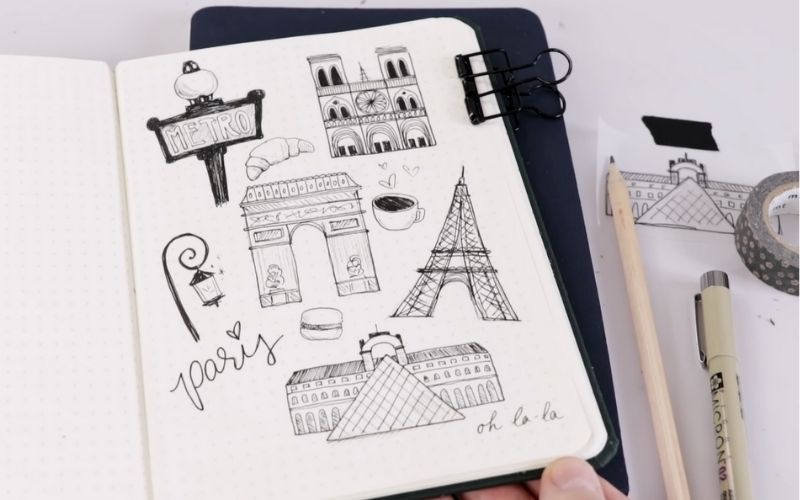
Architecture doodle - Image by Shayda Campbell
Famous buildings are great subjects for doodle art. Even if you have not visited places and seen these buildings in real life, you can still doodle them using reference images. Reproduce them in smaller sizes and draw them on tracing paper to trace on later. Again, you can use them on your destination wish list.
34. Transportation Doodle

Transportation doodle - Image by Sugandha Jule
Kids love to doodle cars, airplanes, and rockets, but there's more in the transport industry that you haven't explored yet. Spend a good time doodling with your kids and experience the joy of being a child again.
35. Fitness Doodle

Fitness doodle - Image by Nataliia Volosaieva
Another good thing about doodles is the freedom to draw anything. For this example, the artist used fitness equipment. Doodling fitness equipment is a good way to motivate you to get fit. You may also include sports equipment if you want.
Character Doodles
36. monsters.

Monster doodles - Image by Art Landy
One of the most popular things to doodle is monsters. You can let your imagination run wild and draw any type of monster you want. If you're feeling extra creative, you can even add a background or story to your doodle.
37. Villain Designs

Villain designs - Image by Sarabjeet World
What's an animated movie without villains? Work on the expression of your characters to give them a real menacing look fit for a nasty villain. After all, villains can be fun to doodle, too.
38. Designing Characters

Designing characters thru doodles - Image by Mad Stuff with Rob
Designing characters is harder than drawing them because that's where all the struggle starts. However, the video tutorial included here shows you tips on how to do character designing properly.
If you compare the drawing on top, you'll see that it's very basic, while the drawing on the lower part is more complicated and has more character. Changing the orientation of the shark and adding a shirt and a hat gives it a more edgy look.
39. Anime Characters

Baymax doodle - Image by Doodles by Sarah
Animation movie characters are another great source of inspiration for doodles. You can start with the most popular ones and work your way down to the more obscure characters. For starters, the artist drew Baymax and several other very simple movies and TV characters.
40. Movie Characters

Doodle of Harry Potter characters - Image by Doodles by Sarah
Doodling Harry Potter characters is a great way to relax and de-stress. You can doodle him and other characters from your favorite movie. You can also use different colors to make the characters stand out.
Colorful Doodles
Colorful doodles are fun to do. Aside from keeping your doodles more interesting, you can also improve your doodle's overall look with colors.
41. Watercolor Doodles

Watercolor doodles - Image by Nianiani
Doodle over watercolor dots on your sketchbooks and discover how these dots improve the overall look of your micro pen doodles. Decorate with more watercolor washes . Play with colors, and mix in your doodles - you’ll surely have an exciting time trying this technique.
42. Alcohol Ink Zentangle

Colorful zentangle - Emiko Kaneko CZT
When making a zentangle, invest in a good zentangle toolset instead of getting the pens and tiles separately. The cotton pulp paper made in molds is absorbent yet strong enough to withstand several layers of ink and colors.
For this zentangle, the artist used alcohol inks and sprayed them over with water to spread the ink. She also blotted out excess inks with a paper towel. Once dry, she darkened some parts of the zentangle with a graphite pencil.
43. Rainbow Doodle

Rainbow doodle - Image by Doodlester_22
A rainbow doodle is a great way to show your personality and add some color to your notes. Use different colors of pen or pencil to make the different parts of the rainbow. You can also use highlighters to make the colors pop for a more vivid presentation.
44. Colorful Doodles for Stickers

Colorful doodles for stickers - Image by Sarah Faber
Did you know that you can turn your doodles into money? A simple app on your iPad and a Cricut machine is all you need to turn that creative bundle into something you can sell to your friends.
45. Colorful Heart Doodle

Colorful Heart Doodle - Image by Unique Art
Trace a heart on paper, then divide it into two sections for the design you want to do. You can use a pencil to sketch out your design or go right in with markers. Try using colored pencils or even paints if you want to add color. Just stay within the lines to prevent the paint from running.
Tips on Doing Doodles
Though doodling in the technical sense is just mindless drawing, the outset of doodling as an art challenged many artists to improve their skills. As a result, styles and techniques evolved and needed careful planning to work on a theme.
Draw using drawing supplies you prefer
Doodling doesn't have to be complicated. You can use any drawing supplies you have on hand, whether a pencil and sketching book or a digital tablet. Don't force yourself to get more supplies unless you're looking for something more serious in your doodling.
Decide on a theme
Choose a theme for your doodles to keep them tied together. It could be something as simple as a color scheme, or you could base your doodles around a subject matter. For example, you could doodle different animals every day for a week. Once you have a theme in mind, brainstorming ideas for your doodles will be much easier.
Start simple
If you're new to doodling, start with basic shapes. Give it a fun edge by adding cute faces, color, and other elements that can elevate it from just a square or a star into a work of art. Start small, too, until you build your doodling muscle.
Experiment with textures
Don't go easy on yourself when it comes to art. It's okay to start small, but don't be complacent. Doodle on different kinds of paper, experiment with shading and cross-hatching and try new mediums like colored pencils, gel pens, and even crayons. The world is your oyster when it comes to doodling.
Turn your mistakes into accidental decors
Don't let errors deter you from making your doodles. Instead, think of a way to accessorize your doodle and use that error to give your doodle a better look. There are, after all, no mistakes. Just lessons learned.
Give yourself a break
Doodling is meant for relaxing, so take it easy if you make mistakes. If it gets too much, take a break and discard that piece. Start a new piece, and don't stress about your previous progress. Doodling can only be therapeutic if you let it.
Improve your subject
Work on improving your doodle subject. Though you only have melons and oranges to doodle, adding a face or other element will make your doodle more creative. Don’t be scared to think outside the box, get creative, and have fun.
Vary your line thickness
You should be able to distinguish your lines from the patterns by using varying line thicknesses. Make the thickest outlines and use medium thickness for the next major lines. Patterns and details should use the thinnest lines for your doodles.
Doodling is a great way to relieve boredom or stress, but you can also make amazing art pieces. With a little imagination and some practice, you can let your inner artist run wild with these amazing doodle art ideas.
Had enough with doodling? Try these marker drawing ideas .
- Share Share on Facebook
- Tweet Tweet on Twitter
- Pin it Pin on Pinterest
Leave a comment
Please note, comments must be approved before they are published
- Choosing a selection results in a full page refresh.
- Press the space key then arrow keys to make a selection.

- Welcome Video
- On The Point Blog
- School Video
- Student Stories
- Philosophy & Mission
- Faculty & Staff Directory
- Request Information
- How to Apply
- Schedule a Visit
- Tuition & Financial Aid
- Art Classes
- Academic Supports
- Post Grad Year at RPS
- College Acceptances
- A Day in the Life at RPS
- Student Profiles
- Residential & Dorm Living
- Evening & Weekend Activities
- School Traditions
- Dogs of Rock Point School
- Healthy Living & Wellness
- Social-Emotional Learning
- Community Service & Internships
- Field Trips & Travel
- Living in Burlington
- Public Events
- School Calendar
- School Newsletter
- Health Updates
- Annual Report
- Strategic Plan

On The Point blog
Doodling: thinking, learning, and creativity.
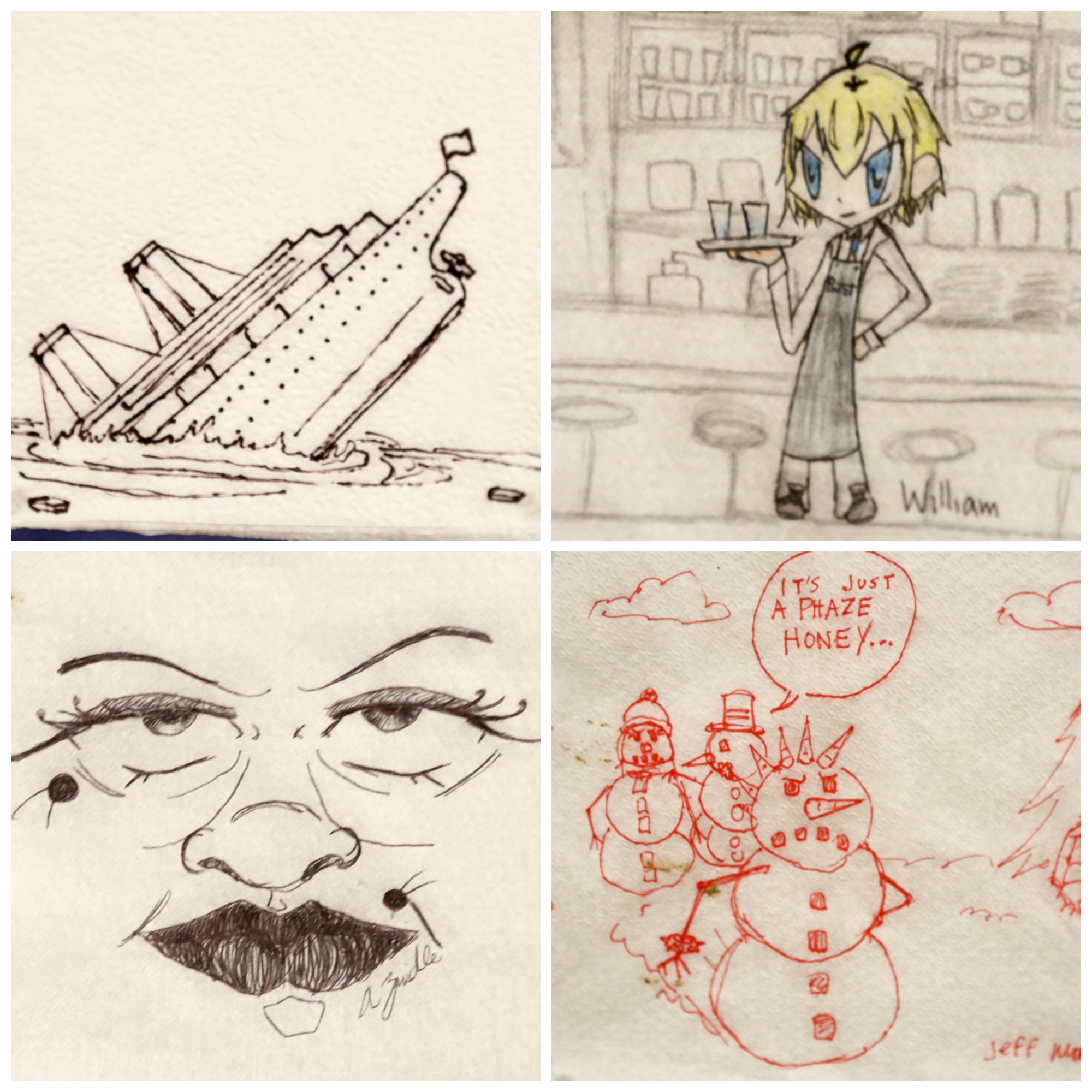
As classes are beginning, students everywhere are organizing their notebooks and binders and practicing note taking. At Rock Point School, we encourage students, when possible, to take notes by hand. Wondering why?
What is Doodling?
Doodling has various definitions, but the best one I think is simply this: drawing any kind of marks in any kind of way, that just feels good, might have no purpose, and might be entirely unrecognizable to someone else! It’s like (nearly) mindless daydreaming or humming or tapping your fingers on a table. But in these activities and doodling, oftentimes, patterns, themes, and repeated symbols form and reappear. And, of course, you can do it with pencil and paper.
Might the whimsy of doodling be connected to organized thinking, learning, and ultimately, creativity? I have no problem believing that doodling is connected in some way to opening up brain pathways to better graphical and pictorial communication and thinking, to freeing the mind, and to creativity.
Freehand drawing is a ubiquitous, highly useful, age-old skill; doodling is the simplest form of drawing . Learn to draw – draw to think, learn, communicate, and create. Doodling is a precursor to drawing with more purpose, and it starts with toddlers.
Why to Encourage Doodling
There have been numerous studies highlighting the benefits of longhand note taking as a way to improve memory and comprehension of the material. We find students are more focused when their laptops are closed and they are writing in their notebooks. Taking notes by hand also means more students are doodling in the margins of their notebooks, on napkins, and on the backs of their binders. While some educators may think doodling is a sign that students aren’t paying attention, that has not been our experience!
There is a lot of anecdotal supporting evidence to show how doodling might be connected to brain development creativity, especially among famous people identified as being creative. In an essay titled, “Doodling and the default network of the brain,” the authors found that doodling can allow the brain to make creative connections as well as help the doodler’s relax.
“The authors found that doodles were produced during states of idleness, boredom, leisure, meditation, and “affective tension”—indecision, concentration, expectation, and impatience. But when an individual doodles, the brain may also be highly creative, being occupied, for example, in solving mathematical problems, or generating ideas for new works in literature, art, or design. For some doodlers, therefore, doodling may be crucial for creativity, whereas for those at the other end of the spectrum, doodling seems to be relaxing or simply entertaining.”
In our experience, students who are doodling are still being productive in class, either finding a way to ease stress or tension while remaining present or processing information in a creative way. One study from the University of Plymouth demonstrated that, “The doodlers in the study retained about 29% more information than non-doodlers.”
Doodling for Lifelong Learners
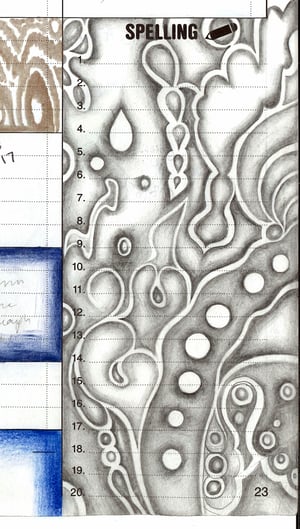
In a book entitled “The Back of the Napkin: Solving Problems and Selling Ideas with Pictures,” author and doodler Dan Roam demonstrates that everyone is born with a talent for visual/ spatial thinking, even those who swear they can't draw. In his book, filled with doodles and drawings, he demonstrates how thinking with pictures can help you discover and develop new ideas, solve problems in unexpected ways, and dramatically improve your ability to share your insights. Check out the author’s slideshow .
While drawing and doodling is often referred to as a visual task, in my work with the blind and visually impaired, they make raised line doodles that they can feel with a stylus and special tactile drawing sheets. This kind of drawing has the same benefits for the visually impaired as it does for the sighted, as the lines can increase sense memory and creativity.
Get doodling!
So, grab your Sketchpad and doodle away! Just draw lines, curves, shapes – freely, unplanned, randomly, hard, soft, big, small, with feeling (or not) – and see what emerges, without judgement or evaluation or expectation or restraint!
The doodles at the top of the page were created by students during the Napkin Doodle Challenge. All drawings were completed during one lunch period, while the artists ate and conversed with friends. The doodle at the bottom is from Katie's (class of 2020) planner, created in class.
Topics: Open & Inclusive , high school , anxiety , life skills
Written by Michael Coleman
Michael Coleman, Ph.D., is a Math Tutor at Rock Point School and was a college instructor in applied mathematics and mechanical engineering (including engineering graphics and design). In his spare time, Mike is a cross-country skier, biker, photographer, piano player, and artist.
Leave a Comment
Recent posts.
- academics (5)
- anxiety (6)
- college (2)
- community (1)
- COVID-19 (1)
- gap year (1)
- high school (9)
- life skills (6)
- Motivation (7)
- Open & Inclusive (8)
- post-graduate (1)
- resilience (7)
- school vacation (2)
- Therapeutic (6)
- transitions (5)
Subscribe To Our News & Events
News & Events will land in your inbox and keep you up to date with the happenings at Rock Point School. Covering special events, career explorations, academic and artistic pursuits, expert guest speakers, daily life in general, plus much more.
Rock Point School
An inclusive, independent boarding and day school for grades 9-12 in Burlington, Vermont.
Rock Point School 1 Rock Point Road, Burlington, VT 05408 Phone: 1-802-863-1104
Quick Links
Admissions Academics Philosophy & Mission School Calendar Contact Us
News & Events
Consider a gift today to help us continue our path of helping young adults become their best selves.
DONATE

Exploring Easy Doodle Art Ideas: Unleash Your Creativity
Are you looking to unleash your creativity and add some fun to your daily routine? Look no further then these easy doodle art ideas! Doodling is a simple and enjoyable way to express your imagination and turn a blank page into a unique piece of art. In this article, we will explore some easy doodle art ideas that will inspire you to pick up a pen and let your creativity flow.
Whether you’re a beginner artist or an experienced artist, these doodle art ideas are sure to ignite your imagination. From whimsical patterns and intricate designs to nature-inspired doodles and doodle lettering, there’s something for everyone. You don’t need any fancy tools or extensive artistic skills – just a pen, paper, and a willingness to let your mind wander.
Doodle art is a fantastic way to express yourself, reduce stress, and have fun. It allows you to let your imagination run wild and create unique designs that are a reflection of your personality.
No artistic skills? No problem! This guide breaks down doodle art into simple steps, making it easy for anyone to learn and enjoy. Doodle art for beginners and veterans alike is a relaxing and beneficial experience. So grab your favorite pen and paper, and let’s dive into the world of doodle art together!
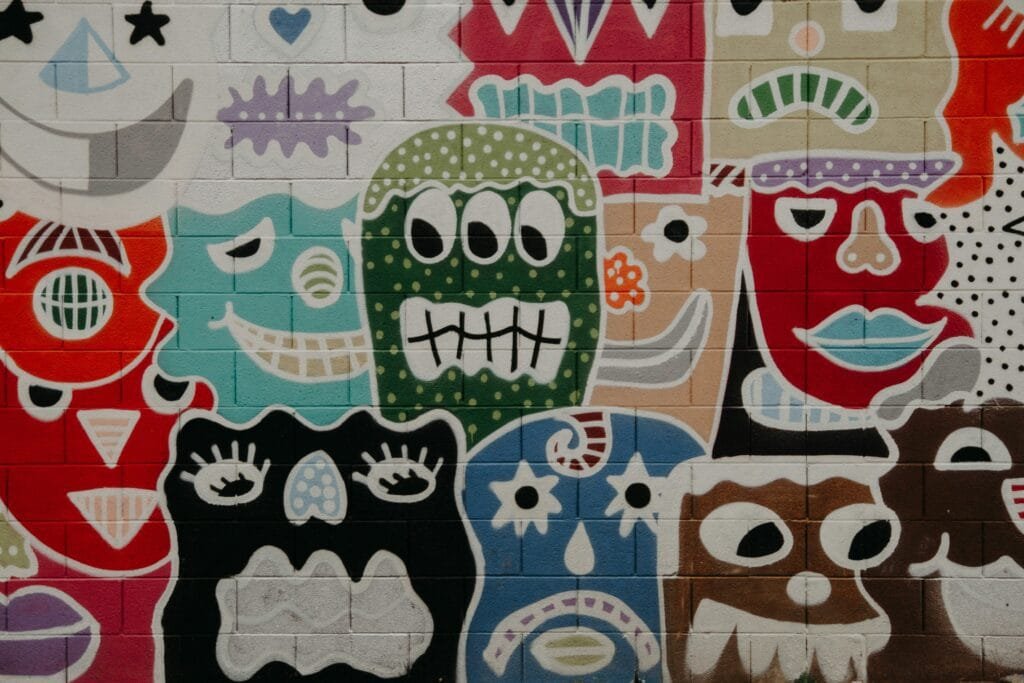
Benefits of Doodle Art for Beginners
Doodling is often seen as a mindless activity, but it actually comes with a host of benefits. Not only does it provide an outlet for self-expression, but it can also improve your focus and concentration. When you’re doodling, you enter a state of flow where your mind is fully engaged in the activity at hand. This can help reduce stress and anxiety, allowing you to relax and unwind.
Moreover, doodling has been found to enhance memory and retention. Research has shown that doodling while listening to a lecture or a presentation can actually improve your ability to recall information. It keeps your brain active and prevents it from wandering off, ensuring that you stay engaged with the material.
Lastly, doodle art is a form of self-expression. It allows you to let your imagination run wild and create unique designs that are a reflection of your personality. Whether you’re drawing simple patterns or intricate compositions, your doodles are a window into your inner world. Doodle art for beginners, as well as veteran artists, can be truly beneficial in so many ways!
Basic Supplies for Doodling
Before we dive into the different doodle art ideas, let’s talk about the supplies you’ll need to get started. Fortunately, doodling doesn’t require any fancy tools or expensive materials. All you need is a pen or pencil and a piece of paper.
When choosing a pen, opt for one that feels comfortable in your hand and produces a smooth line. Some popular options include gel pens, fine tip markers, and even ballpoint pens. Experiment with different pens to find the one that suits your style best.
As for paper, any type will do. You can use a plain white sheet, a notebook, or even a sketchbook. If you’re just starting out, it may be helpful to use a sketchbook with thicker paper to prevent ink from bleeding through. A sketchbook or a drawing pad with a smooth surface is especially ideal for doodling. This will give you a clean canvas to work on and prevent your pen from snagging on the paper fibers.
Additionally, you may want to have an eraser handy in case you make any mistakes or want to remove any pencil guidelines. An eraser will allow you to correct errors and refine your doodles. Finally, if you prefer to add color to your doodles, you can invest in a set of colored pens, markers, or colored pencils.
Basic Doodle Art Techniques for Beginners
Before we jump into the doodle art ideas, let’s go over some basic techniques that will help you create beautiful doodles. These techniques will serve as the foundation for your doodle art journey and can be applied to a wide range of designs.
1. Start with Simple Shapes: Begin by doodling simple shapes like circles, squares, and triangles. Experiment with different sizes and arrangements to create interesting patterns.
2. Lines and Patterns: Once you’re comfortable with basic shapes, start adding lines and patterns to create more intricate designs. Experiment with different line weights and styles to add depth and dimension to your doodles. Try using straight lines, curvy lines, dashed lines, and even spirals to create interesting effects.
3. Create Focal Points: To add depth and interest to your doodles, create focal points within your composition. This can be a larger shape or pattern that draws the viewer’s eye and anchors the overall design.
4. Shading and Crosshatching : Adding shading and crosshatching to your doodles can make them appear more dynamic and three-dimensional. Use hatching (parallel lines) or crosshatching (intersecting lines) to create shadows and highlights. Play around with different densities and angles to achieve the desired effect.
5. Textures and Fillers : Incorporating different textures and fillers can add texture and visual interest to your doodles. Some common fillers include dots, stars, hearts, flowers, and geometric shapes. Experiment with different shapes and sizes to find the ones that complement your doodles.
6. Incorporate Color: If you’re using colored pens or pencils, now is the time to add some color to your doodles. Experiment with different color combinations and techniques to create vibrant and eye-catching designs.
Remember, there’s no right or wrong way to doodle. Let your intuition guide you and enjoy the process of creating unique artworks. Now that we’ve covered the basics, let’s explore some easy doodle art ideas for beginners.

Easy Doodle Art Ideas for Beginners
Doodle art is incredibly versatile, offering a wide range of techniques and styles to explore. Here are a few popular techniques you can try:
1. Zentangle Patterns: Zentangle is a popular form of doodling that involves drawing repetitive patterns within defined spaces. Start by drawing a simple shape, such as a square or a circle, and then fill it with intricate patterns. Zentangle patterns are easy to learn and can be as simple or as complex as you like.
2. D oodle Lettering and Typography: Combine your love for doodling with hand-lettering by creating doodle letters. Start by writing a word or a phrase in your favorite font, and then embellish the letters with patterns and designs. Doodle lettering is a great way to personalize your artwork and showcase your unique style.
3. Nature-Inspired Doodles: Take inspiration from the world around you and create doodles inspired by nature. Draw flowers, leaves, trees, and animals to bring a touch of the outdoors to your doodle art. You can also incorporate natural elements, such as rocks or seashells, to add texture and visual interest.
Now that we’ve covered the basics and have some easy doodle art ideas under your belt, it’s time to challenge yourself with some intermediate doodle art ideas.
Intermediate Doodle Art Ideas
- Mandalas : Mandalas are intricate geometric designs that can be incredibly satisfying to create. Start by drawing a circle as your base and then add layers of patterns and shapes. You can experiment with different motifs, such as flowers, stars, or geometric shapes, to create a mesmerizing mandala.
- Doodle Landscapes : Transport yourself to another world by creating doodle landscapes. Draw mountains, trees, clouds, and other elements to bring your landscape to life. Play with perspective and shading to add depth and dimension to your artwork.
- Abstract Doodles : Let your imagination run wild with abstract doodles. Create random shapes, lines, and patterns, and then fill them in with vibrant colors. Abstract doodles are a great way to express your emotions and explore different artistic styles.
Now that you’re feeling more confident in your doodle art skills, it’s time to take on some advanced doodle art ideas.
A Closer Look at Easy Doodle Art Ideas
1. whimsical patterns and intricate designs.
One of the great things about doodling is that you can create your own patterns and designs. Let your imagination run wild and experiment with different shapes, lines, and textures. Start by drawing simple shapes, such as circles, squares, and triangles, and then fill them in with intricate patterns. You can create repeating patterns, such as flowers or geometric shapes, or go for a more random and abstract look.
To add depth and dimension to your doodles, try shading. Shading involves adding different levels of darkness to your drawings to create a sense of depth and realism. You can use cross-hatching, stippling, or even just simple shading techniques to add depth to your doodles. Don’t be afraid to play around and see what works best for you.
If you’re feeling adventurous, try incorporating different materials into your doodles. Use colored pens, markers, or even watercolors to add a splash of color to your designs. You can also experiment with different textures, such as using a toothbrush or sponge to create interesting effects. The possibilities are endless when it comes to doodling, so let your creativity guide you.
2. Nature-Inspired Doodles
Nature is a great source of inspiration for doodle art. Take a walk outside and observe the beauty of the world around you. From flowers and trees to animals and landscapes, there are endless possibilities for nature-inspired doodles. You can create intricate floral patterns, draw your favorite animals, or even recreate a scenic landscape.
To add a touch of realism to your nature-inspired doodles, pay attention to details. Study the shape, texture, and color of the subject you’re drawing and try to replicate it as accurately as possible. Don’t worry about perfection – the beauty of doodling is that it’s all about expressing your own unique style.
If you’re not sure where to start, try looking up reference images online or in books. There are also many tutorials and step-by-step guides available that can help you learn different techniques and styles. Don’t be afraid to experiment and make mistakes – remember, doodling is all about having fun and expressing yourself.
3. Doodle Lettering
Doodle lettering is a fun and creative way to add a personal touch to your doodles. Whether you’re writing a quote, a favorite word, or just doodling your name, lettering can be a great way to express yourself. You can experiment with different fonts, sizes, and styles to create unique and eye-catching designs.
To get started with doodle lettering, practice writing different letters and words. Play around with different styles, such as bubble letters, cursive, or block letters. You can also add embellishments and decorations to your letters, such as flowers, stars, or swirls. The key is to let your imagination run wild and have fun with it.
If you’re looking for inspiration, there are many online resources and tutorials available that can help you learn different lettering styles and techniques. You can also join online communities or attend workshops to connect with other doodle artists and learn from their experiences. Remember, the most important thing is to enjoy the process and let your creativity shine.
Tips for Enhancing Your Doodle Art Skills
As with any skill, practice is key to improving your doodle art abilities. Here are a few tips to help you enhance your skills and take your doodles to the next level:
1. Doodle Every Day: Set aside dedicated time every day to doodle. The more you practice, the more comfortable you’ll become with different techniques and styles.
2. Experiment with Different Pens and Paper: Don’t be afraid to try out different pens and papers to find the ones that work best for you. Each pen and paper combination can produce unique effects and textures.
3. Study Other Artists’ Work: Look for inspiration in the work of other doodle artists. Study their techniques, compositions, and use of color to expand your creative horizon.
4. Join a Doodle Art Community: Connect with like-minded doodle artists by joining online communities or attending local meetups. Sharing your work and receiving feedback from others can be incredibly motivating and inspiring.
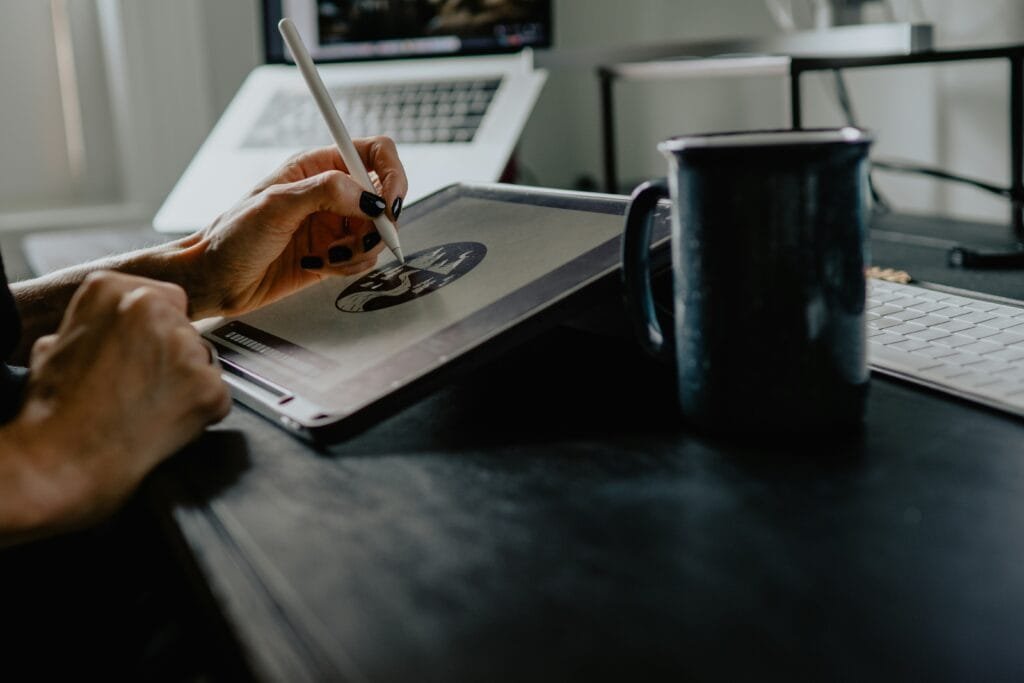
Inspiration and Resources for Doodle Art Ideas
If you ever find yourself lacking inspiration or ideas for your doodle art, don’t worry! There are plenty of resources available to spark your creativity. Here are a few places to find inspiration:
1. Nature: Step outside and observe the beauty of nature. Take note of the shapes, patterns, and colors you see and incorporate them into your doodles.
2. Books and Magazines: Flip through art books, magazines, or graphic novels for ideas and new techniques. You can also find step-by-step tutorials to help you learn specific doodle art styles.
3. Online Platforms: Explore social media platforms like Instagram and Pinterest, where you’ll find a wealth of doodle art inspiration. Follow other artists, save your favorite designs, and create mood boards to fuel your creativity.
4. Doodle Challenges: Participate in doodle challenges or prompts that provide daily or weekly themes to doodle about. These challenges can help you stay motivated and push your creative boundaries.
Showcasing your Doodle Art – Digital vs. Traditional Mediums
Once you’ve created a collection of doodle art pieces, you might be wondering how to showcase and share your work. One of the advantages of doodle art for beginners is its versatility in terms of mediums. You can choose to showcase your art digitally or through traditional methods. Here are the pros and cons of each:
1. Digital Medium: Sharing your doodle art digitally allows you to reach a wider audience. You can create a portfolio website, upload your work to social media platforms, or even sell digital prints online. However, keep in mind that the digital medium may not do justice to the intricate details and textures of your doodles.
2. Traditional Medium: Displaying your doodle art in traditional formats, such as framing them or creating physical prints, can give your work a personal and tangible touch. Traditional mediums allow viewers to appreciate the details up close and offer a more intimate viewing experience. However, it may be more challenging to reach a large audience compared to the digital medium.
Consider your goals, audience, and personal preferences when deciding how to showcase your doodle art. You can also explore a combination of both digital and traditional mediums to maximize exposure.
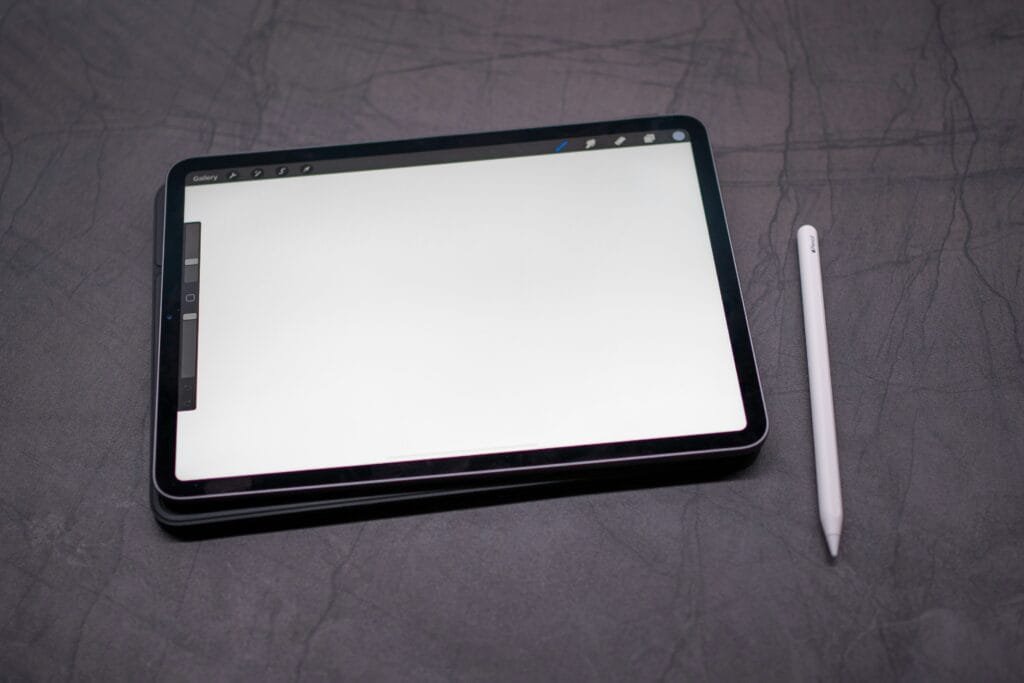
Doodle Art Communities and Online Platforms
Being part of a doodle art community can provide invaluable support, inspiration, and feedback. Here are a few online platforms where you can connect with other doodle artists:
1. Instagram : Instagram is a popular platform for sharing and discovering doodle art. Follow hashtags like #doodleart, #doodlersofinstagram, or #doodlecommunity to find and connect with other artists.
2. Doodle Addicts: Doodle Addicts is an online community dedicated to doodle art. Here, you can showcase your work, participate in challenges, and connect with fellow doodlers.
3. Reddit : Reddit has several doodle art-related communities, such as r/Doodles and r/ArtCrit. These communities provide a space for sharing, receiving feedback, and engaging in discussions about doodle art.
4. Doodle Art Forums: Explore online forums and discussion boards focused on doodle art. These platforms allow you to ask questions, share your work, and learn from experienced doodle artists.
Conclusion: Embrace Your Creativity Through Doodle Art
Doodling is not only a great way to relax and destress, but it can also improve your focus and concentration. By exploring different doodle art ideas, you can unleash your creativity and turn a blank canvas into a unique masterpiece. Whether you’re a beginner or an experienced artist, there’s something for everyone in the world of doodle art.
So why wait? Grab a pen and start doodling today! Let your creativity take flight and watch as your doodles transform into true works of art. Remember, there are no rules when it comes to doodling – it’s all about expressing yourself and having fun. So let your imagination run wild, experiment with different techniques, and most importantly, enjoy the process. Happy doodling!
If you are interested in more articles about doodle art for beginners, check out my other article on doodling. You may also to take a look at this YouTube video about using line to draw a simple doodle.
About The Author
Phillippia fuqua, leave a comment cancel reply.
Your email address will not be published. Required fields are marked *
Save my name, email, and website in this browser for the next time I comment.
This site uses Akismet to reduce spam. Learn how your comment data is processed .
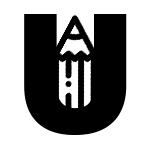
Cute Doodle Art: Tips and Techniques for Beginners
1. choosing materials, paper types, pens and markers, coloring tools, 2. basic shapes and patterns, using circles, incorporating squares, triangles and lines, 3. developing your own style, finding inspiration, experimenting with techniques, practicing consistency, 4. adding color to your doodles, color schemes, coloring techniques, blending colors, 5. doodle art resources, books and guides, online tutorials, doodle art communities.
```Note: Remember to replace the `#` in the `href` attributes with the actual URLs for each section when you create your blog content.
Creating cute doodle art is a fun and relaxing activity that anyone can enjoy. With the right materials and some basic techniques, you can easily transform simple shapes and patterns into adorable doodle masterpieces. In this blog, we'll guide you through the process of choosing materials, mastering basic shapes and patterns, developing your own unique style, adding color to your doodles, and finding resources to help you improve your cute doodle art skills. Let's get started!
The first step in creating cute doodle art is selecting the right materials. By choosing the best tools, you can ensure your doodles look their best and achieve the desired effect. In this section, we'll discuss the various types of paper, pens, and coloring tools you can use to create your doodle art.
When it comes to paper for your cute doodle art, there are several options to choose from:
- Sketch paper: A lightweight paper that's perfect for quick doodles and practice sketches.
- Drawing paper: A slightly heavier paper with a bit more texture, ideal for more detailed doodles and finished pieces.
- Mixed media paper: A versatile option that works well with various coloring tools, such as markers, colored pencils, and watercolors.
Experiment with different types of paper to find the one that works best for your doodling style and preferred coloring tools.
Choosing the right pens and markers is essential for creating clean and precise cute doodle art. Here are some popular options:
- Gel pens: These pens have a smooth ink flow and come in a variety of colors, perfect for adding fine details to your doodles.
- Fineliners: With their thin, precise tips, fineliners are great for outlining your doodles and drawing intricate patterns.
- Brush pens: These pens have a flexible brush-like tip, allowing you to create both thin and thick lines, giving your doodles a dynamic look.
Experiment with different pens and markers to find the ones that suit your cute doodle art style the best.
Adding color to your cute doodle art can bring your creations to life and add an extra touch of personality. Consider the following coloring tools:
- Colored pencils: A versatile and easy-to-use option, colored pencils allow for precise coloring and shading techniques.
- Markers: Available in various tip sizes and a wide range of colors, markers are perfect for filling in larger areas and creating bold, vibrant doodles.
- Watercolors: For a softer, more whimsical look, try using watercolors to add color to your cute doodle art. This medium also allows for unique blending and layering techniques.
Experiment with different coloring tools to discover which ones work best for your doodling style and preferred aesthetic.
Now that you have your materials, it's time to start doodling! Cute doodle art often begins with simple shapes and patterns that can be combined and modified to create unique and adorable designs. In this section, we'll explore how to use circles, squares, triangles, and lines as the foundation for your doodles.
Circles are versatile and can be the basis for a variety of cute doodle art creations. Here are some ideas to get you started:
- Faces: Use circles to create the heads of cute animals, people, or even inanimate objects with faces.
- Flowers: Draw a small circle for the center and surround it with petals to create a simple flower design.
- Bubbles: Combine various-sized circles to create a bubbly effect, which can be used as a background or a standalone design element.
Remember, you can always modify and embellish your circular doodles with additional shapes, lines, and patterns to make them truly unique.
Squares may seem basic, but they can be used in many creative ways in your cute doodle art. Here are some ideas:
- Gifts: Turn a simple square into a cute gift box by adding a ribbon and a bow.
- Buildings: Use squares to create the base of houses, shops, or other structures, then add details like windows, doors, and roofs.
- Geometric patterns: Combine squares with other shapes and lines to create intricate geometric patterns and designs.
Just like with circles, you can customize your square-based doodles with additional elements to make them stand out.
Triangles and lines can be used to create a wide range of cute doodle art designs, from simple to intricate. Here are some suggestions:
- Animals: Combine triangles with other shapes to create the bodies, ears, and tails of cute animals.
- Trees and plants: Use triangles to form the leaves of trees or the petals of flowers, and lines for stems and branches.
- Patterns and borders: Mix triangles and lines to create interesting patterns, borders, and frames for your doodle art.
Experiment with different combinations of triangles and lines, and don't be afraid to add other shapes and patterns to create unique and eye-catching cute doodle art.
As you practice and explore different shapes and patterns, you'll naturally begin to develop your own unique cute doodle art style. In this section, we'll discuss how to find inspiration, experiment with techniques, and maintain consistency in your doodles to help you hone your personal style.
Looking at other artists' work can help spark your creativity and give you ideas for your own cute doodle art. Here are some sources of inspiration:
- Children's books: Illustrated children's books often feature simple and adorable characters and scenes that can inspire your doodles.
- Cartoons and animated films: Study the character designs and backgrounds in your favorite cartoons and animated films for ideas on how to create cute and appealing doodles.
- Everyday objects: You might be surprised at how many cute doodle ideas can come from observing the world around you. Try turning everyday objects into cute characters or incorporate them into your doodle art.
Remember, the goal is to draw inspiration—not to copy. As you find ideas, adapt and modify them to make them your own.
To develop your own style, it's essential to try new techniques and approaches in your cute doodle art. Here are some ideas to help you experiment:
- Line thickness: Use different pen sizes or adjust the pressure while drawing to create variations in line thickness, which can affect the overall look of your doodles.
- Textures and patterns: Incorporate various textures and patterns in your doodles to add depth and interest to your designs.
- Character design: Play with different facial expressions, body shapes, and accessories to create unique and memorable characters in your doodle art.
Don't be afraid to step out of your comfort zone—it's through experimentation that you'll discover what works best for your style.
Consistency is key in developing your own cute doodle art style. To maintain a cohesive look across your doodles, try these tips:
- Color palette: Choose a consistent color palette for your doodles, whether it's a specific set of colors or a general color theme.
- Line style: Stick to a consistent line style, such as smooth curves or angular lines, to help define your unique style.
- Recurring elements: Include recurring elements, like specific characters, symbols, or patterns, to create a signature look in your doodle art.
Remember, practice makes perfect. The more you doodle, the more your unique style will emerge and evolve over time.
Adding color to your cute doodle art can bring your designs to life and enhance their appeal. In this section, we'll discuss color schemes, coloring techniques, and blending colors to help you create vibrant and eye-catching doodles.
Choosing the right color scheme can make a big difference in the overall look of your cute doodle art. Consider these tips when selecting colors:
- Complementary colors: Colors that are opposite each other on the color wheel, such as blue and orange or red and green, can create a striking contrast in your doodles.
- Analogous colors: Colors that are next to each other on the color wheel, like different shades of blue or green, can create a harmonious and cohesive look.
- Monochromatic colors: Using various shades, tints, and tones of a single color can give your doodle art a unified and sophisticated appearance.
Feel free to mix and match these color schemes or create your own combinations to find the perfect palette for your cute doodle art.
Experimenting with different coloring techniques can add depth and dimension to your cute doodle art. Here are some methods to try:
- Hatching and cross-hatching: Use parallel lines or cross-hatched lines to create shading and texture in your doodles.
- Stippling: Create shading and texture by using small dots, varying the concentration of dots to achieve different levels of darkness.
- Layering: Apply multiple layers of color to build up depth and richness in your doodles, starting with lighter colors and gradually adding darker shades.
Don't be afraid to mix and match these techniques or develop your own methods to add character to your cute doodle art.
Blending colors can create smooth transitions and gradients in your cute doodle art, giving your designs a polished and professional look. Here are some blending tips:
- Colored pencils: Use a light hand to apply layers of color, blending them with a white or colorless blender pencil to create smooth transitions between shades.
- Markers: Choose markers that are designed for blending, such as alcohol-based markers, and use a blending pen or a lighter shade to merge colors together seamlessly.
- Watercolors: Apply wet colors next to each other on damp paper and allow them to naturally blend together, or use a clean, wet brush to gently merge the colors.
Experiment with different blending tools and techniques to find the ones that work best for your cute doodle art style.
There are plenty of resources available to help you hone your cute doodle art skills and find inspiration for your designs. In this section, we'll explore some books and guides, online tutorials, and doodle art communities that can support your creative journey.
Books and guides can be a great source of inspiration and instruction for cute doodle art. Here are a few popular titles to check out:
- Doodle Invasion: A fun and engaging coloring book filled with intricate doodle designs that can spark your creativity.
- The Art of Doodle Words: This book teaches you how to combine lettering and doodling to create unique and expressive artwork.
- Doodle Theory: An interactive guide that encourages readers to expand on simple shapes and lines to create their own doodle masterpieces.
Visit your local bookstore or library to find even more books and guides on cute doodle art.
Online tutorials can provide step-by-step guidance for creating cute doodle art, from basic shapes and patterns to advanced techniques. Some popular platforms for finding doodle tutorials include:
- YouTube: Search for "cute doodle art" or similar keywords to find a wealth of video tutorials from talented doodle artists.
- Pinterest: This visual platform is filled with cute doodle art ideas, tutorials, and inspiration boards to spark your creativity.
- Instagram: Follow doodle artists and hashtags like #cutedoodleart to discover new techniques and get inspired by their work.
Explore these platforms and others to find the online tutorials that resonate with your cute doodle art style.
Connecting with other doodle artists can offer encouragement, feedback, and inspiration as you develop your cute doodle art skills. Consider joining one of these doodle art communities:
- Facebook groups: Search for "doodle art" or similar keywords to find groups where artists share their work, ask questions, and offer support to one another.
- Reddit: Subreddits like r/doodles and r/doodleart provide a platform for artists to share their creations, ask for critiques, and discuss techniques.
- Art forums: Websites like WetCanvas and DeviantArt have dedicated forums for doodle artists to connect and share their work.
By engaging with these resources and communities, you'll be well-equipped to continue growing and improving your cute doodle art skills. Happy doodling!
If you're looking to improve your character design skills and create adorable characters that everyone will love, don't miss the workshop ' How to Create CUTE Character Design ' by Alba. This workshop will teach you the techniques and secrets to designing irresistibly cute characters that will make your art stand out.

Live classes every day
Learn from industry-leading creators
Get useful feedback from experts and peers
Best deal of the year
* billed annually after the trial ends.
*Billed monthly after the trial ends.

- Artist Watch
- Artist Blog
- Book Reviews
A Tribute To The Founder
- Escape Into Chris

All Content
- 1,763,244 hits
Celebrating the Art of the Doodle: 20 Awesome

Faith Georgia

Jabson Rodrigues

molossus aka rooibas

Jim Bradshaw

Sam Morrison

Penny Raile

Mariann Johansen Ellis

Snippy Snippy

Daniel Dors

Sherrie Thai

Dave Bollinger

Check out the essay, “Beyond the Doodle,” by David Maclagan
Share this:
- Click to share on Facebook (Opens in new window)
- Click to share on Twitter (Opens in new window)
- Click to share on LinkedIn (Opens in new window)
- Click to share on Tumblr (Opens in new window)
- Click to share on Pinterest (Opens in new window)
- Click to share on Pocket (Opens in new window)
78 responses to “Celebrating the Art of the Doodle: 20 Awesome”
these are amazing. but they remind me of things my friend used to draw while on simulants, scary in a way
These are amazing, I really like that second one, but theyre all awesome!
Anthony Pittarelli
Crazy wonderful! As an advocate for the doodling soul, I can't wait to share!!
i love this i do this all the time
innnnnnnnnncredible! I want this art show where I live.
am saving this page for future tattoo ideas (=
confessed doodler..these are ridiculous..very cool
Fantastic doodles
i like Sam Morrison very much
Type your comment here.
Really great doodles…. post more:)
great to see abstract art like mine. Always looking for inspirations!
sono tutti bellissimi…
isnt a doodle something which requires no thought input at all or maybe a slight input. The idea of “doodles” is lost here
ah, so many hours spent in calculus not paying attention. Glad to see at least one more fellow line notebook doodler up there!
how is the idea of doodles lost here? quit being so cynical.
This are really cool! It reminds me of my friends doodle art. Check it out if you have time, I think you will like it. http://www.facebook.com/#!/pages/Piaget-Martelino-Art/106137802761693
Great work indeed, your friend does. Thank you for sharing 🙂
Amazing! I just love Jabson Rodrigues draw.
[…] Celebrating the Art of the Doodle: 20 Awesome Doodles & Escape Into Life – StumbleUpon […]
[…] Celebrating the Art of the Doodle: 20 Awesome – As a follow-up to our recent article, […]
[…] http://www.escapeintolife.com/showcase/celebrating-the-art-of-the-doodle-20-awesome-doodles/ […]
[…] Celebrating the Art of the Doodle: 20 Awesome […]
szkło gięte w piotrkowie trybunalskim,polecam
[…]usually posts some incredibly intriguing stuff like this. If you are new to this site[…]
jdyf333 says thank you!
Leave a Reply Cancel reply
This site uses Akismet to reduce spam. Learn how your comment data is processed .
Recent Posts
- Music for Music: Alta Vista August 25, 2024
- Life in the Box: Valuing Women, Anna May Wong August 23, 2024
- Via Basel: Hope and Joy August 16, 2024
- Martin Garhart August 15, 2024
- What type of mystery reader are YOU? August 3, 2024
Recent Comments
- Amanda Steinmetz on Via Basel: Hope and Joy
- holly b on Via Basel: Griefs and Gifts of July
- Basel Al-Aswad on At the Edge of a Thousand Years: chapbook review
- Hailie on Hannah Stephenson
- VIRGIL JOHNSON on Lynne Naylor
Browse Archived Posts
The Doodle Method for Creative Writing
Laura Lee Hamm
Why does so much creative writing teaching focus on rules and formulas? It’s like teaching painting-by-numbers, and the result is kids who live in fear of colouring outside the lines.
But you don’t teach real painting that way. You don’t get kids to love art by teaching them the rules of perspective first. You get them doodling.
Can we take the same approach to getting kids to love storytelling and creative writing? Here are some ideas on how. I’m calling it The Doodle Method of Creative Writing:
- Keep sketching — think of it like messy play for words, celebrate the story doodles — a character, a line, an idea — don’t wait for finished stories, every artist needs to sketch.
- Use your fridge door — find your equivalent of art on the fridge door to show you value their doodles, it can be as simple as naming it (great story you’re telling!), and listening ( not easy !).
- Paint, pencil and playdoh — ink and type aren’t the only ways to write; encourage them to tell stories aloud, let them put on a show, or act it out with toys - it’s all story and it all helps writing too.
- Forget the rulers — grammar, structure, spelling: these are all tools. They help hone the craft. But first they need to love the craft, to want to learn the technical tools to support their own voice.
- Copying is learning — unoriginal? derivative? copying stories they already know? That’s great! That’s how the best artists learn too.
- Visit art galleries — read read read. Immersing them in stories and books is the storytellers’ visit to the art gallery. That’s the best instruction and inspiration you can give.
Our society is in danger of flash-carding the joy out of our kids. We need to spend more time just listening to, inspiring and celebrating kids stories.
Any time I’ve asked a kid to tell me a story I’ve had something fantastic back. But I hear constantly from parents of kids crippled by crises of creative confidence at school. I’ve seen reports of 9 year olds saying they need to work on their ‘front-loaded adverbials and expanded noun phrases’. I don’t even know what those are.
We need to encourage story play . To connect writing to the imaginative impulse which precedes it, and which is strengthened through the written expression of it — Make Believe.
All mammals play, and that play is how they prepare for adulthood. Human play is extended and deepened by language, and stories are its currency. As we get older, we engage more formally with the story part — we structure it, codify or write it — but the source, intent, and impetus is the same. It’s all Make Believe.
But trying to find my community on social media I’ve been struck by its absence — there are arts and crafts accounts galore, kids book accounts, but few celebrating kids words and voices.
Verbal creativity is one of the most accessible forms of creativity. It’s the first human art form, the one we engage with the most over our lives , it comes absolutely naturally — and you don’t need a single bit of kit to play! Kids’ creativity is more than crayons, but we can take a leaf out of the toddler doodling playbook to develop their storytelling.

Written by Laura Lee Hamm
Founder of kids’ storytelling site www.fabledkids.com . Newsletter https://fabledstories.us15.list-manage.com/subscribe?u=2e60ff9fce7aabca
Text to speech

Dimensions of Wonder
28 Cute Doodles To Draw: Ideas, Inspiration & Tutorials
Doodling is a fun way to explore your creativity. However, we all have moments of no inspiration. Feeling a bit stuck for ideas, or simply in the mood to browse a variety of doodles? With these examples and tutorials of cute doodles to draw, let’s get those creative juices flowing lickety-split!
Table of Contents
Doodle art: why & where, two dinosaurs, striped kitty, cute llama doodle, a little narwhal, ‘rottie’ puppy, bunny reading, little octopus, cute polar bear face, little chick, tropical fish, another starfish, happy dog profile, tiny seascape, toadstool mushrooms, rainbow & stars, songbird in balloons, soap & bubbles, snowy mountain, striped & polka-dotted umbrella, kawaii muffin, coffee to-go, ice cream cone, kiwi & lemon, english liquorice, 3 sleeping clouds, rainbow & co., thunder & lightning, here comes the sun, blue skies ahead, christmas tree doodles, benefits of doodling, wait, there’s more.
Animals are one of my favorite subjects to draw. Hopefully, we share this as a common interest, since you’ll notice a lot of animals strewn about on this website.
What else can you expect to find in this super-duper fun and cute compilation of cute doodles?
- Everyday objects
- Random items from days gone by (retro vibes never seem to lose their certain charm!)
- Tiny landscapes, seascapes, and streetscapes
- Fantasy illustrations
- Elements of nature
- Seasonal doodles, and more.
So if you’re looking for some creative inspiration or just want to get in touch with your inner artist, this blog post is for you!
By the way, doodling is a great way to alleviate stress. Now, maybe that’s easy or me to say because I’m reasonably good at it. But even if you have serious doubts about your drawing skills, please do yourself a favor and go out on a limb here.
Simple doodle art is not that far out of reach, even if you’ve only ever drawn stick figures. There are so many cute things that come together with just a few lines. That’s right: Fun doodles are not hard to draw.
Either way, the one thing you don’t have to worry about is inspiration. Check out this boatload of cute doodles – all you need to do is scroll down. Maybe click a few links, too, since not all doodles fit on one page, and there are other blog posts with (you’ve guessed it!) more doodles.
Enough talking, here’s what you need to get started:
The simple art of doodling requires very few supplies. With just a pen and paper, you’re good to go.
Any kind of paper will do, as long as it still has some empty space. Mixed-media paper works well in general. If you plan on adding color to your doodles with watercolor paint, watercolor paper is a must.
Any kind of pen or pencil, or marker is better than none. The best pens don’t always make the best doodles, though sometimes a crappy pen is to blame for a doodle that looks yucky. So maybe set yourself up for success and get a sharpened pencil, a relatively new, properly moist Sharpie, or a nice fine liner.
(Half-dried-out Sharpies can be interesting to shade with, but to draw a crisp line, they’re the worst!)
My favorite supplies include these Staedtler fine liners that have lasted me for years, and Sakura Pigment fine liners which are lovely to work with as well.
Speaking of shading, pencils are good to have, too. Regular HB pencils hold the middle between hard and soft. The “H” pencils are on the hard side of the spectrum. They make lighter shades of grey. The “B” ones, on the other hand, are used to make darker shades and are softer.
Or you could go full-on digital. If you want to explore some more high-tech options, like an iPad or a digital drawing tablet, Procreate is the highest acclaimed drawing app.
Just to be clear, drawing for the sake of drawing is an excellent purpose in and of itself, and more than a good enough reason to doodle away.
Other than simply for the joy it brings you, consider using these examples of cute doodles to draw in/on:
- shopping lists
…and I’m sure you can come up with a few more uses!
Cute Animal Doodles
Isn’t this the cutest little spotted mutt with its floppy ears? You could add more detail, and shading, and play around with the locations of the spots.
These two cuties could be a brontosaurus, apatosaurus, or diplodocus pair.
The step-by-step mini tutorial for this striped cat doodle is right here:
How To Doodle A Cute Striped Cat (Step-By-Step)
We start with the ears and the head outline. Details are added on after shaping the body and stripes are totally optional.
Perhaps they are no longer quite as popular as they were a few years ago. So what if they’ve played a fad role in fashion, home decor, surface, and pattern design for a blip of their total existence? Llamas are still a lovely drawing subject.
Unicorns dwelling in the ocean – it hardly gets any more magical than that.
You might also like:
Do you like llamas and narwhals too? I can’t get enough of these adorable creatures. Check out 27 Cute Beginner Drawing Ideas For Free Spirits for another llama and another narwhal .
Here’s a Rottweiler puppy, after a stuffed animal that is beautifully and realistically made. Cutie, right?
Have you ever seen a bunny reading a book? Because that’s unmistakably what is happening below. And the simple lines are easy to copy, so you can draw your own version. Everyone should draw at least one reading bunny. Oh, that’s so many bunnies! Just what the world needs: bunnies multiplying.
What is this little octopus thinking… I could sit with that question for a while. Would he/she/it like to be blown up to poster size and hung on the wall?
*Note to self: turn this cute little octopus doodle into a large print.
This simple and cute polar bear face got into someone’s makeup bag and found the blush! Or maybe she just ran so fast on the ice that she got rosy cheeks.
Here is a cute doodle of a tropical fish. Color it in with some of those bright and popping colors that remind you of a coral reef!
Ah, a cute ladybug, or ladybird for our British friends. When I draw these for my kids, I give them cute faces, even though they’re actually plenty cute without them. Something about those dots.
Other Cute Doodles to Draw
The drawings that don’t fit into any of the other categories.
You can doodle an infinite number of scenes within the borders of a circle. Here’s a tiny seascape, complete with dunes, wavy grass, actual waves, birds, and a sailboat in the distance.
Copy this one if you need some inspiration, or come up with your own cute doodles to draw in a circle. (It’s a great drawing challenge.)
Ready to doodle some toadstool mushrooms? Start with the tops, like this. You can, of course, add a few more and make a composition that looks interesting.
Next, add some dots. Raised dots along the edges, just circles everywhere else. And the stems, which can be curvy or straight, with or without the indentation at the bottom.
That’s all for the ‘bones’ of your cute mushroom doodle. What’s left is the most fun part: details and shading. Not overthinking it is key, a few lines on both sides of the top, more lines right under the top, and some well-positioned sprigs of grass. Done!
| Do you keep a Bullet Journal? They’re easy to learn and will look so pretty on your next weekly spread! |
So simple, this sailboat. It looks like a kids’ toy, and is super easy to draw; all straight lines, and a few curvy ones.
But of course, a rainbow and stars can coexist on paper. The two-dimensional realm has lots of possibilities that don’t have to be realistic or make any sense.
Two sweet images combined into yet another completely unrealistic and quirky picture: a songbird that has decided to hang out in a bunch of balloons. Only on paper are those sharp little claws no issue.
You’re either team soap or team something-that-comes-in-a-bottle. The good old-fashioned bar of soap is much more fun to draw than any bottle, which is why I’m team soap. At least on paper.
Best observed (or drawn) from the comfort of your home/couch, with a warm beverage within reach.
Have you ever tried to draw an easy little birdhouse, with just a few frills and flowers to make it look even more cute?
What does it take to lift a regular-looking umbrella to the level of one that makes people smile? Well, stripes and polka dots, of course!
This is an easy doodle of a striped and polka-dotted umbrella. It’s quite fun in pen already but at the same time kind of asks to be colored in. With markers, colored pencils, or even some delightfully unpredictable blotches of fancy watercolor paint.
| or if you’re on the fence about getting some new supplies. |
Food Doodles
Cute food doodles to draw should definitely include some kind of muffin in Kawaii style.
Did you know that “kawaii” is the Japanese word for “cute”? Hence the name for the entire style that developed from this term.
Happiness in a cup, for some people… More like a lot of people. So a simple coffee-to-go drawing definitely deserves a spot in this compilation of cute doodles to draw!
Four steps to a yummy ice cream cone doodle. While the example here is without, cones like these practically demand to be colored.
This kiwi and lemon are best friends. They’re both so high on vitamin C that they can’t stop smiling.
Oops – did I just write that out loud? Oh well, there’s no law against naturally occurring vitamins, right?
Try these, and a few other fruit doodles, and switch up the eyes and mouths to give them different facial expressions.
English licorice is super fun to draw. The cylinders and cubes are rather easy (ahem – they’re probably easier to draw than the word licorice is to spell!) and when you add those characteristic swirls and centers, the result is unmistakable.
In truth, I’m not entirely sure that one with the swirl actually exists. But it looked nice as something different in the mix. Maybe a piece of another type of candy fell in…
Weather Doodles
The weather, the sky, and the elements are such fun topics to draw, and they lend themselves especially well to some simple yet lovely doodles.
What is cuter than a sleeping cloud?
Two sleeping clouds, of course!
The good old trifecta of rain, sunshine, and a rainbow, casually hanging out together.
What’s that rumbling in the sky – or is it coming from the paper?
This sun sure looks like it’s happy to be shining.
Gotta make this into a sticker, don’t you think?
Monster Doodles
Three monster doodles coming up. The third doodle monster is the cutest. The second one turned out a bit weird but oh well. What do you expect of a monster? Maybe they’re all weird. This fluffy one is pretty cute, though.
This was supposed to be a silly Santa Claus drawing but he looked a bit stern. That’s why he really needed that text bubble with a candy-cane-striped heart to lighten the mood.
An ornate Christmas tree with baubles and a star on top.
In their bare-naked, natural state, Christmas trees are quite beautiful, too. Guess they’re really just called pines, or firs, in that case. If you add color, what will it be – with snow, or green all the way?
More Reasons to Doodle/Draw
Isn’t doodling addictive?
I’m constantly split between working a doodle into something more or starting on the next one. With so many ideas bubbling up that demand to be doodled, it is essential to keep a sketchbook or an art journal. One? Actually, make that two, or three.
We touched upon the benefits of doodling for stress relief at the beginning. Of course, anything you enjoy doing will to some extent relieve stress, just as anything you dislike might cause it. Be that as it may, as far as the good about doodling goes, here are some more perks.
- Explore & practice your drawing skills
- Hone your drawing skills in a low-threshold kind of way
- Decrease stress
- Be in the moment
- Entertain kids
- Challenge your creativity (Coming up with a simpler, cuter version of things can be a nice challenge.)
Check out these cute and easy things to draw for more doodle art inspiration.
Or these easy mushroom drawing ideas .
They are no less magical in simple line art. But… if you feel compelled to go bonkers on them with color, they probably wouldn’t object to that either!

75 Cute Doodles To Draw Anytime
Welcome to a world of whimsy and creativity! If you’ve ever found yourself yearning for a delightful escape through the strokes of a pen, you’re in for a treat. In this blog post, I’ve curated a collection of 75 irresistibly cute doodles that you can draw anytime, anywhere. Whether you’re a seasoned artist or just looking for a fun way to unwind, these doodle ideas are bound to spark your imagination and bring a smile to your face. Grab your favorite drawing tools and get ready for some playful doodling!
If there is a pen, marker, or pencil anywhere nearby, I will start doodling and zone out happily. Although studies have shown that doodling does help with concentration , so I absolutely doodle anytime I’m sitting and listening to something I want to focus on. I’ve compiled doodles for you into different categories so you can come back and reference these at any time.
Affiliate links may be used on this post. This means: I may earn a small commission if you purchase something through one of my links.
Related: 21 Easy Doodle Ideas
Easy, Cute Doodles to Draw
When you are drawing these doodles, be sure to practice each one a few times – there is magic that happens in drawing after you have drawn something more than once. Your hand loosens up, you become more confident, and the doodle loses the stiffness that comes with the first time of drawing anything.
Keep practicing your doodles and you will build up your own repertoire of characters, shapes, facial expression, and even go-to colors that will make your doodles distinctly yours.
Related: What is Doodle Art?
Food Doodles
Food is so much fun to draw! From our favorite junk food (hello, pizza) to cute li’l strawberries, you can find a way to draw any sort of food you love in an easy doodle style.
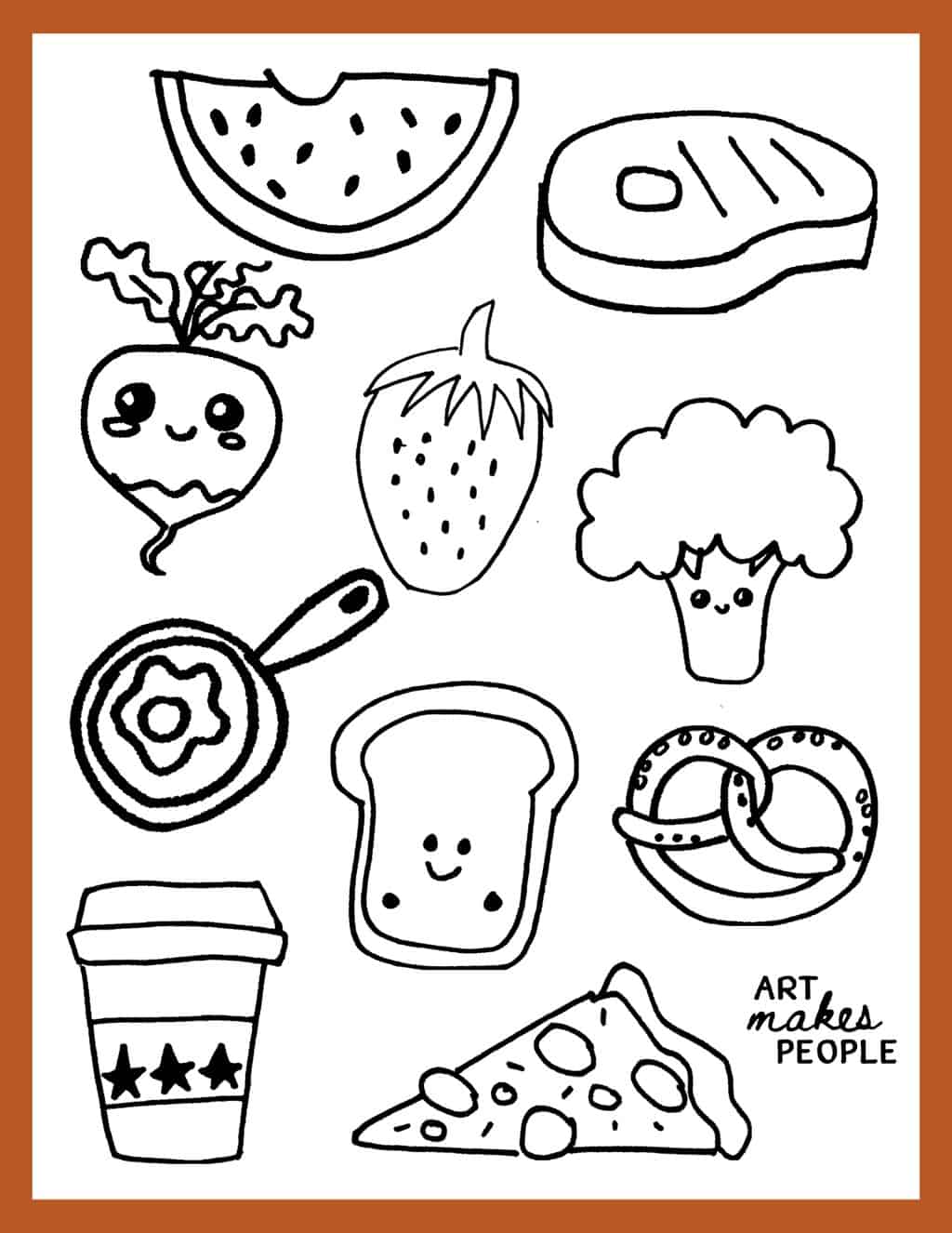
Sweets Doodles to Draw
Droooool. Who doesn’t love to draw sweets? It’s the second best thing next to eating them all. Since candies and desserts are so much fun to eat, I think that makes them automatically one of the best things to doodle – especially with all those sprinkles, cute wrappers, and fun shapes.

Also check out these drawing prompts by season if you want to doodle that way!
Animal Doodles
Practice these animal doodles and you will be ready to turn all your favorite animals into cute doodle characters. Here’s a hint: Once you get a few of these down, look at other animals and try to draw their basic shapes. Meaning, if you look at an animal photo and feel overwhelmed about how to turn it into a doodle, try looking at it as a group of basic geometric shapes all put together. Ears can be triangles, faces can be circles, etc.

Plant Doodles
Nature contains all the shapes and colors you could possibly want to doodle. It can be an endless source of inspiration for doodling ideas, and plants especially are really fun to draw! And we all know it’s impossible to draw a flower without adding a fun little face to it…

Outer Space Doodles
There is something about outer space that captures all of our imaginations – from the amazing planets in our solar system to twinkly stars to our ideas of what life on other planets could look like. As endlessly fascinated with space as we are, it is a fantastic source for doodle ideas!

Everyday Object Doodles
Everywhere you look around, there is something to doodle. Literally, the world is full of items to draw and turn into cute doodles.

Cute Faces to Doodle
If you want to take your doodle cuteness to the next level, practice drawing cute faces. Once you have a repertoire of lots of different expressions, you can use them to illustrate your current mood, or the mood of the item you are doodling, Who doesn’t love a grumpy carrot or laughing fried egg?
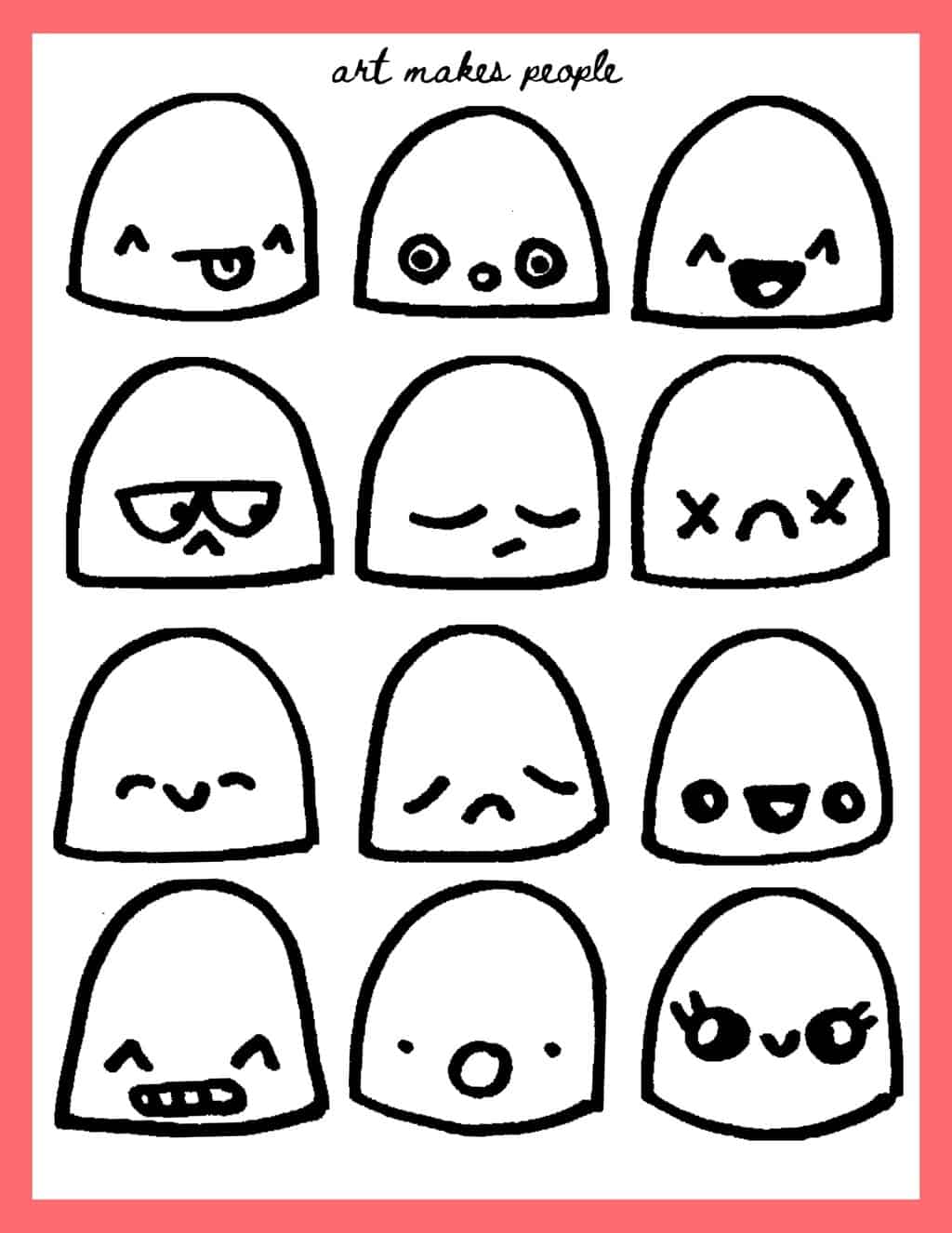
Tips for Doodle Drawing
If you feel a little lost with where to start, begin by drawing the largest shape first and then adding in the smaller details.
You can practice drawing your doodles in pencil, but I feel like that just defeats the purpose of doodling. You aren’t drawing masterpieces here; doodle art is supposed to be easy and fun! Take the pressure off yourself to draw something perfect. Instead of drawing with pencil and erasing any little bit that doesn’t look as expected, use your pen or marker of choice, and draw a whole page of one single doodle in your sketchbook. By the end of the page, you’ll feel pretty confident with how to draw that doodle, and you won’t have made doodling a chore!
After you’ve drawn your doodles, go ahead and play with coloring them in – try markers on some and watercolors on some – just like making your own coloring sheets!
To make your doodles extra cute, try adding faces to anything. Really, adding a face just automatically makes it adorable, see? 🙂
But if you don’t want to add a face, practice your line style. Loose drawing lines can make a drawing look somehow sweeter and more whimsical, and this comes with practice! This may be the third time I’ve written this here, but practice doodling as much as you can, and you will start to be able to manipulate your line styles as you draw, instead of just focusing on getting the drawing to look like whatever you are emulating.
Tools you’ll need
Ya don’t need very much at all to get started with doodling, but here is a list of some of my favorite doodle supplies:
This post was updated on December 4, 2023
Similar Posts

15 Art Techniques Every Kid Should Try
In a world that often seems dominated by screens and technology, nurturing a child’s creativity becomes more crucial than ever. Art provides a unique avenue for self-expression, allowing young minds to explore, experiment, and envision the world around them in vibrant hues. Whether your child is a budding Picasso or simply enjoys the process of…

How to Make a Gallery Wall in 7 Steps
Are you looking to make a gallery wall in your home? First off, welcome to 2016. No, just kidding, gallery walls never go out of style. The whole idea of gallery walls has been around forever, they just surged in popularity over the past decade, with tutorials, ideas, inspiration, and cool wall art abounding. So…

9 Brilliant Etsy Gifts for Artists
What better place than Etsy to buy creative gifts for the artist in your life? Artists making things for artists is sort of a no-brainer, as most of the art supplies Etsians are making were originally created to fill their own need. From lovingly-pinched ceramic paint palettes to vintage flat file storage chests, there is…

80 Silly Drawing Prompts For Kids
What better way to ignite the spark of creativity in kids than by infusing art with heaps of fun and silliness? Picture an art class where wee littles are cracking each other up drawing the funniest things ever. You will go down in history as the best teacher ever. Or picture being at home and…

Art Supplies List for Beginners (Or Hopping Back in)
You want to make art. You are a beginner, or you are getting back into making art after not for an extended period, you need an art supplies list that won’t have you buying every extra little art material at the store. If you answered yes to this very exciting scenario, take my hand and…

21 Doodles to Draw – Plus a Free Download
Ready to doodle? I know you are. One of my favorite things ever is to brainstorm cool doodling and drawing ideas. I know how intimidating it can be to face a blank page. Or maybe you are a beginner and don’t have a bank of doodling ideas stored up in your brain yet. No worries,…
Easy and cute doodles
Really fun and easy to do when you are very bored.
Leave a Reply Cancel reply
Your email address will not be published. Required fields are marked *
Save my name, email, and website in this browser for the next time I comment.
This site uses Akismet to reduce spam. Learn how your comment data is processed .
Privacy Overview

Easy Drawing Prompts for Kids: 21 Printable Daily Drawing Prompts
Do you have a child who likes to write? Today we have a project that will entice your child to pick up a pencil to draw AND write. The super cool thing about this project is that it isn’t a one-shot prompt. Instead it includes 21 days worth of doodling or drawing and writing prompts . That is three full weeks of creative fun. Plus, they are free for you to print and use.
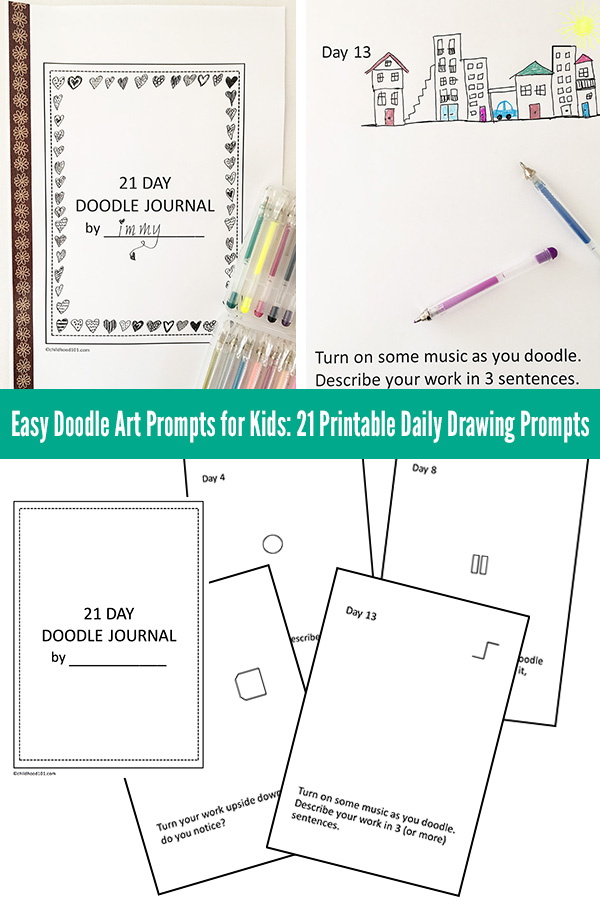
What is a Doodling? The Merriam-Webster Dictionary defines doodling as “to draw something without thinking about what you are doing.”
What are Doodle Journals? Doodle journals include creative drawing prompts that engage children or adults to create doodles or drawings, and in this case, that also inspire writing. It’s great for kids who enjoy doodling or drawing but also helps kids who can’t think of what to draw or write or spend so much time overthinking a writing prompt that they never actually get anything down on paper. By doodling first, kids relax and start day dreaming. Both of which are important to the writing process.
Why 21 Prompts? It’s said that it takes 21 days to form a habit. By starting with a 21-day journal, we hope to develop a regular journal writing and doodling habit.
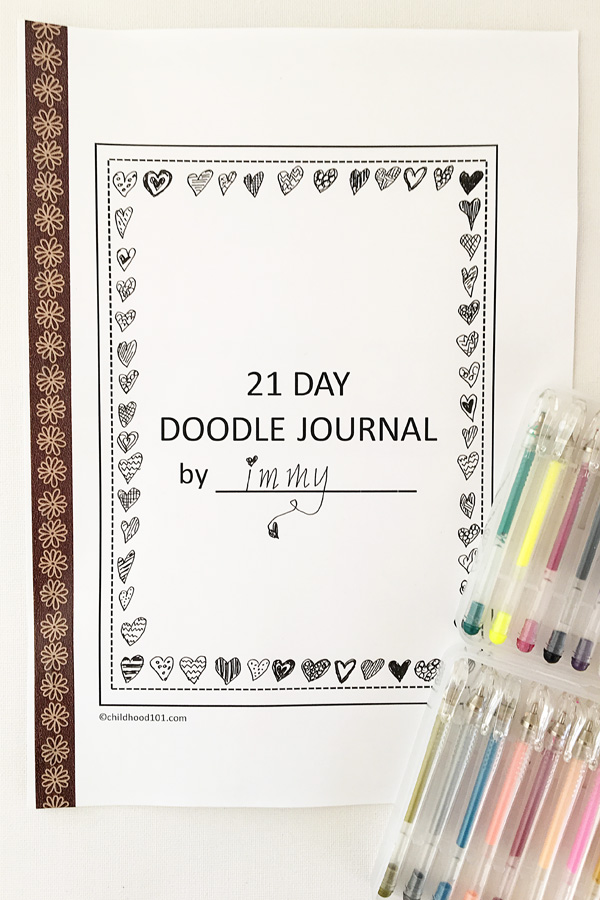
Printing Your 21 Printable Daily Drawing Prompts
Getting Your Doodle Journal Ready Download the free printable here: Daily Drawing Prompts Printable .
Print and decide if you want to bind the pages together with staples (we covered our staples with decorative tape) or punch the pages and place in a binder. You will also need a pen, pencil or marker. We like to go to the store to buy a special, new writing utensil for new projects.
Introducing the Doodle Journal Lay out a blank piece of paper for you and your child. Introduce the term ‘doodling’ and model how-to while you talk. There is really no right or wrong way to draw when you are doodling. Some doodles are random, many are repetitive and pattern like, yours might even grow into a little picture. Open the journal to day 1 and point out the mark on the page – each day there is a line, shape or mark on the page to get you started. Invite your child to doodle as long as she wants. Then, each day there is a writing prompt for recording some thoughts about what she has created. She may write as little or as much as she wants (just turn to the back of the page if you need more space to write).
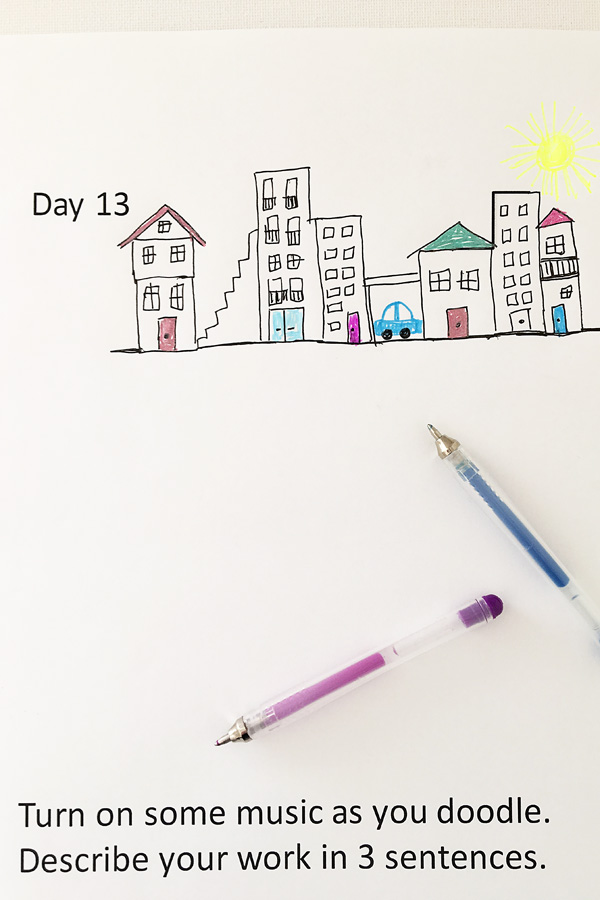
Further Ideas for Using the Writing Journal
- Make it a family project (doodling is great for adults too!) Print a journal for each family member. After dinner, spend time doodling and journaling. Share your finished journal pages with each other.
- Have your child pick a doodle buddy friend to do this project with her. The pair can meet periodically throughout the three weeks to share their journals with each other.
Have fun doodling and writing too!
You might also like;
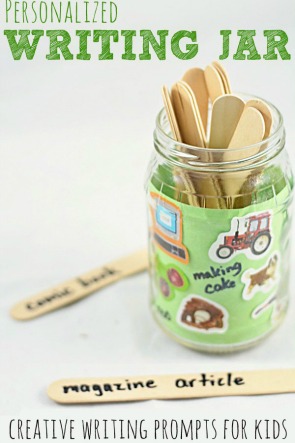
Jodie Rodriguez has a passion for helping caregivers nurture our youngest readers. As a former National Board Certified early-childhood, elementary teacher and administrator, she has worked with thousands of families and educators providing best literacy practices. She lives near St. Louis, Missouri and now stays home with home with her two young sons.

IMAGES
VIDEO
COMMENTS
The Power of the Doodle. For those of you who say doodling isn't art, you are missing the point. It is a form of expression that, says Heller, "often triggers insights and discoveries that aren't possible through words alone. Just think of all those napkins (or Post-Its) on which million-dollar ideas were sketched out."
Doodle a basic flower and then draw more and more and more petals going out from the petals. Draw a bullseye shape with spokes and doodle different patterns inside of the spaces. Draw one large triangle and see how many triangles you can draw inside of that one. Draw cute borders all across your page.
Get drawing and you could add to your portfolio with a bunch of new work (for inspiration, see these examples of amazing design portfolios ). 01. Joe Whale AKA The Doodle Boy. Joe Whale (who is 10 years old) used to get into trouble for doodling at school, until asked to decorate a local restaurant in his cartoon-style doodles, when he gained ...
Doodle art is an act of sketching, drawing, or scribbling on a piece of paper, without the idea of what the finished image will be. When it comes to this type of drawing, the act of doodling or drawing is of more value than the result. ... Then the papers are passed around to the person next to them, and they add to that first sketch. The ...
The purpose of visual language has always been to communicate ideas to others. Secondly, we doodle because our brain is designed to empathize with the world around us. According to Carol Jeffers, professor at California State University, our brains are wired to respond to, interact with, imitate and mirror behavior.
Our modern understanding of a doodle thus has its premise in a fictional work. What Deeds shows us is the first doodle to be called a doodle, but of course it's not one; it's a drawing of a doodle.It's as if here the scriptwriter has aimed to include all those archetypal forms that we are likely to find ourselves drawing when bored—stars, numbers, swirls, figure eights—drawing them ...
Burgerman has worked with major brands, like Nike, MTV, and Apple, and along the way he's been spreading the gospel of doodling among children and adults alike, through various books and workshops. "It was meant to be a bit of a gag," he said, speaking from his studio at the Invisible Dog Art Center, in Boerum Hill, Brooklyn.
Doodling is a whole-brain activity—spontaneous, at times unconscious, self-soothing, satisfying, exploratory, memory-enhancing and mindful (Malchiodi, 2014 ). Doodling, by contrast, is beyond craft and criticism; it belongs to us all; it's impossible to do it badly—or well (Battles, 2009 ).
11. Word Doodles for Journals. Word Doodles for Journals - Image by Vedika Gurav. Stylize your journal words by making a doodle out of them. Make a simple word such as smile into a work of art by writing the word inside a sunflower, or use different font styles and sizes to write your headings and quotes. 12.
In an essay titled, ... or generating ideas for new works in literature, art, or design. For some doodlers, therefore, doodling may be crucial for creativity, whereas for those at the other end of the spectrum, doodling seems to be relaxing or simply entertaining." ... while the artists ate and conversed with friends. The doodle at the bottom ...
A beginner guide to easy doodle art ideas, basic techniques & tips to get started with doodle art. Learn how to doodle to create unique works of art. ... Don't be afraid to try out different pens and papers to find the ones that work best for you. Each pen and paper combination can produce unique effects and textures. 3. Study Other Artists ...
Check out Celebrating the Art of the Doodle: 20 Awesome. David Maclagan is a writer, artist, lecturer and retired art therapist, living in W Yorks. He has published numerous articles on Outsider Art, art and imagination and psychological aesthetics (the title of a book published in 2001 by Jessica Kingsley).
Patterns and borders: Mix triangles and lines to create interesting patterns, borders, and frames for your doodle art. Experiment with different combinations of triangles and lines, and don't be afraid to add other shapes and patterns to create unique and eye-catching cute doodle art. 3. Developing Your Own Style.
Celebrating the Art of the Doodle: 20 Awesome - As a follow-up to our recent article, Browse Content. Home; Artist Watch; ... Abstract Accidental Critic Art-Essays Art-History Art-Interviews Art-News Art-Reviews Art-Videos Artist-Blog Book Reviews Collage Comics Digital-Art Drawings EIL-Blog Escape-Into-Chris Fiction Figurative Film ...
I'm calling it The Doodle Method of Creative Writing: Keep sketching — think of it like messy play for words, celebrate the story doodles — a character, a line, an idea — don't wait for ...
I believe in the art of a doodle. The art of remembering a moment in time, how you want to remember it. A doodle, a simple drawing on paper or skin. It can release your anger or make you laugh. It can make a statement about your personality or be a mindless scribble on the sketchpad of life. Life puts has both good and bad times, so, to ...
Doodle Art: Why & Where. Just to be clear, drawing for the sake of drawing is an excellent purpose in and of itself, and more than a good enough reason to doodle away. Other than simply for the joy it brings you, consider using these examples of cute doodles to draw in/on: notebooks; journals; a diary;
We'll cover the fundamentals of doodle art, providing you with the skills and inspiration to craft stunning creations. Whether you're a complete novice or lo...
In this blog post, I've curated a collection of 75 irresistibly cute doodles that you can draw anytime, anywhere. Whether you're a seasoned artist or just looking for a fun way to unwind, these doodle ideas are bound to spark your imagination and bring a smile to your face. Grab your favorite drawing tools and get ready for some playful ...
These are super easy doodles to draw that will take you less than 5 minutes. 4. Text Dividers. @ bujoandcookies on Instagram. Text dividers are another fun way to organize information and divide it in sections. I guess you can also consider this easy doodle art since most of them include little doodles.
8. Vines. Let's draw some plants now! A fun little doodle to draw is vines. It's so simple to draw, yet you can use it to decorate your sketchbook page or any drawing you want to create. 9. Ghost. Ghosts are such a cute little subject to draw so let's draw one next! 10.
Today we have a project that will entice your child to pick up a pencil to draw AND write. The super cool thing about this project is that it isn't a one-shot prompt. Instead it includes 21 days worth of doodling or drawing and writing prompts. That is three full weeks of creative fun. Plus, they are free for you to print and use.
We've put together a list of 50+ cute and easy doodles you can draw on your sketchbook, notebook, or art/bullet journal. We've handpicked such doodles that will be perfect for beginners who are looking for inspiration to have an idea of what to put on that blank piece of paper. In our drawing practice article, doodling is one of the many ...